You are using an out of date browser. It may not display this or other websites correctly.
You should upgrade or use an alternative browser.
You should upgrade or use an alternative browser.
What If - Finland had been prepared for the Winter War?
- Thread starter CanKiwi
- Start date
Well, the Ilmavoimat did get some Hurricanes from the UK in reality. That won't change.
But here's a preview......
Royal Air Force contributions
In addition to selling (rather than giving these to Finland as has often been thought) a limited number of aircraft (primarily Blenheims, Hurricanes, Blackburn Roc’s and Hawker Henley’s) to Finland, the Royal Air Force allowed a small number of volunteers from the RAF to assist Finland in the Winter War. Volunteer Pilot and Ground Personnel for a single fighter squadron were formed under the leadership of Squadron Leader James Bigglesworth, a noted RAF pilot with extensive combat and leadership experience dating back to WW1 (note that the biographer of Bigglesworth, WE Johns, falsely accounted for this period in Biggles life in “Biggles in the Baltic” as the British Government did not desire to broadcast the fact that British forces had actually fought against the USSR at the time the book was published - at which time the USSR was an ally against Nazi Germany). Along with the personnel for this squadron, twenty Hawker Hurricanes were transferred together with the RAF volunteers. These were painted in Finnish colours and flown to Finland via Sweden in late-December 1939, with the squadron entering combat in January 1940.
Under the leadership of Squadron Leader Bigglesworth (“Biggles”), the RAF pilots quickly adapted to flying in the extreme conditions of the Finnish winter, as well as to the “Finger Four” formation and the combat tactics used by the Ilmavoimat. The combination of a tightly knit and highly skilled group of RAF pilots, many of whom, such as Biggles himself, already possessed considerable combat experience, together with the adequate performance of the Hurricanes as a fighter led to some spectacular successes against the Soviet Air Force as well as to some incongruous notes. Such as Hurricanes and (Spanish) Me109’s fighting side by side against the Soviet Air Force even as the aircraft fought each other over France. The RAF pilots lost very few of their number, 3 pilots from 20, with 2 of these lost to accidents in the extreme winter weather and only 1 shot down. In return, the 20 RAF pilots accounted for some 120 confirmed kills and a further 50 odd probables. The RAF volunteers later fought in northern Norway in support of Finnish units intervening in the Norwegian campaign, and later returned to fight in the UK during the Battle of Britain as the German blitz commenced in full force.......
But here's a preview......
Royal Air Force contributions
In addition to selling (rather than giving these to Finland as has often been thought) a limited number of aircraft (primarily Blenheims, Hurricanes, Blackburn Roc’s and Hawker Henley’s) to Finland, the Royal Air Force allowed a small number of volunteers from the RAF to assist Finland in the Winter War. Volunteer Pilot and Ground Personnel for a single fighter squadron were formed under the leadership of Squadron Leader James Bigglesworth, a noted RAF pilot with extensive combat and leadership experience dating back to WW1 (note that the biographer of Bigglesworth, WE Johns, falsely accounted for this period in Biggles life in “Biggles in the Baltic” as the British Government did not desire to broadcast the fact that British forces had actually fought against the USSR at the time the book was published - at which time the USSR was an ally against Nazi Germany). Along with the personnel for this squadron, twenty Hawker Hurricanes were transferred together with the RAF volunteers. These were painted in Finnish colours and flown to Finland via Sweden in late-December 1939, with the squadron entering combat in January 1940.
Under the leadership of Squadron Leader Bigglesworth (“Biggles”), the RAF pilots quickly adapted to flying in the extreme conditions of the Finnish winter, as well as to the “Finger Four” formation and the combat tactics used by the Ilmavoimat. The combination of a tightly knit and highly skilled group of RAF pilots, many of whom, such as Biggles himself, already possessed considerable combat experience, together with the adequate performance of the Hurricanes as a fighter led to some spectacular successes against the Soviet Air Force as well as to some incongruous notes. Such as Hurricanes and (Spanish) Me109’s fighting side by side against the Soviet Air Force even as the aircraft fought each other over France. The RAF pilots lost very few of their number, 3 pilots from 20, with 2 of these lost to accidents in the extreme winter weather and only 1 shot down. In return, the 20 RAF pilots accounted for some 120 confirmed kills and a further 50 odd probables. The RAF volunteers later fought in northern Norway in support of Finnish units intervening in the Norwegian campaign, and later returned to fight in the UK during the Battle of Britain as the German blitz commenced in full force.......
What's in the pipeline?
In the "immediate" Pipeline - more on Valtion Lentokonetehdas (State Aircraft Factory) and the ongoing constructions program for the Ilmavoimat thru the 1930s up to the Munich Crisis - with a bit of an interesting little twist.
Also working on the Coastal Artillery but that's taking up a lot of research time - and I had most of the Air Force stuff drafted so I'm finishing that off first while I plug away at the Coastal Artillery. Which should come next.
Then it's a sideways jump to Foreign Affairs thru the 1920's and thru to about 1935.
More great updates! What's in the pipeline?
In the "immediate" Pipeline - more on Valtion Lentokonetehdas (State Aircraft Factory) and the ongoing constructions program for the Ilmavoimat thru the 1930s up to the Munich Crisis - with a bit of an interesting little twist.
Also working on the Coastal Artillery but that's taking up a lot of research time - and I had most of the Air Force stuff drafted so I'm finishing that off first while I plug away at the Coastal Artillery. Which should come next.
Then it's a sideways jump to Foreign Affairs thru the 1920's and thru to about 1935.
And now, back to Valtion Lentokonetehdas...
And now, back to Valtion Lentokonetehdas
Before we run through a history of aircraft construction by Valtion Lentokonetehdas, we’ll take a more indepth look at the new factory and at one of the key engineers – Arvo Ylinen.
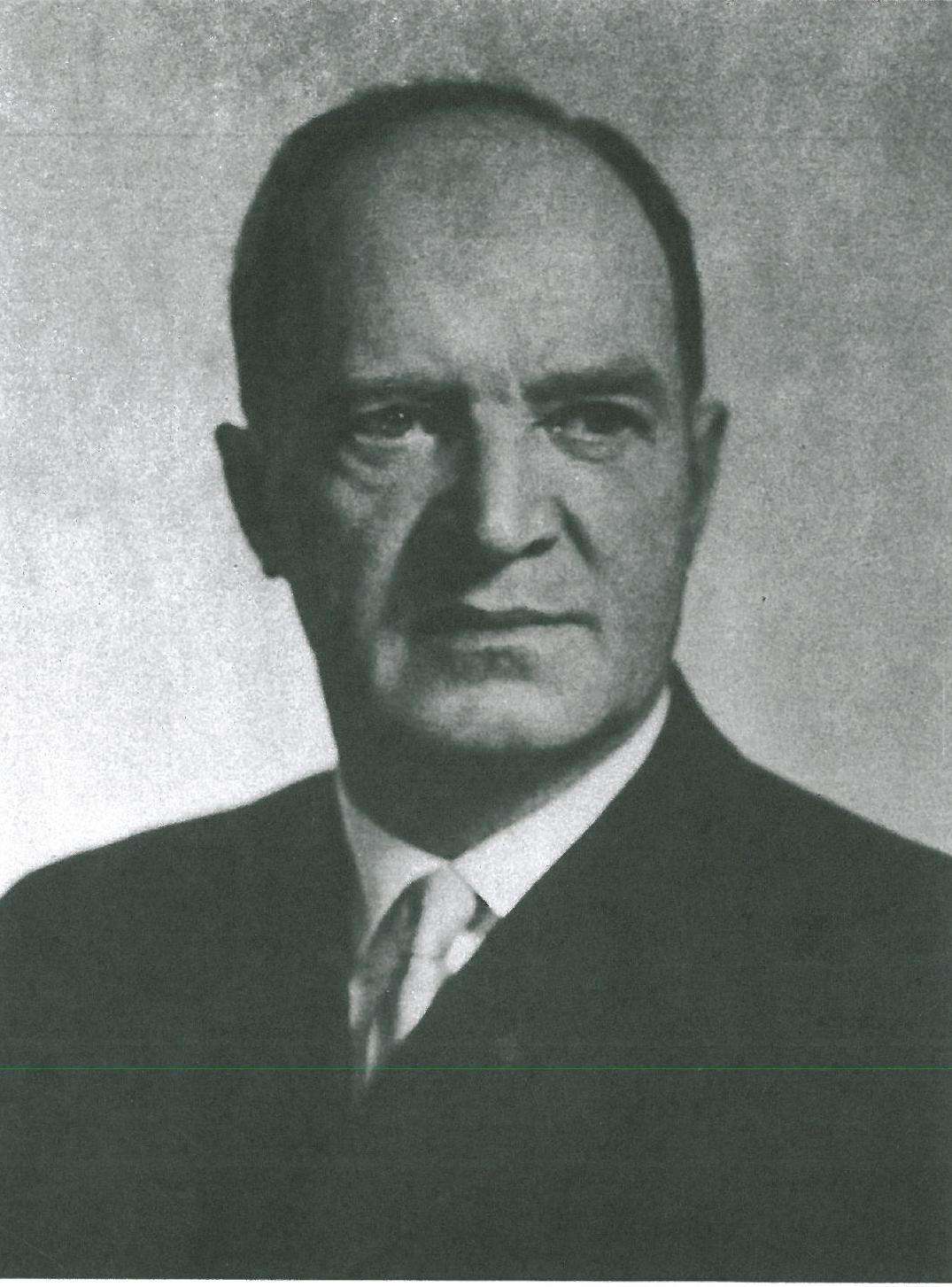
Arvo Johannes Ylinen (b. Yläne, Southwest Finland on 5 March 1902 – and died 27 July 1975) was an aeronautical engineer and late a Professor of Aeronautical Engineering. His father was Juho Ylijaakkola and his mother was Sofia Emerentia Uusitalo. Arvo Ylinen graduating from high school in Turku came in 1923, attended University and graduated in 1930 with a Master of Science ”with Distinction” in Engineering, which was then very rare. In the same year he completed the CDI's military technical department graduate course. He studied aviation engineering at the Charlottenburg Technical School of the Berlin University of Technology over 1930-31 and later completed a doctoral thesus, which he defended at TKK in 1938. His dissertation was the first aircraft technology thesis completed in Finland.
He joined IVL at Suomenlinna, first working as a Design Engineer from 1932 to 1933. He was soon promoted to Office and Drawing Manager, a position he held from 1933 to 1934. In 1934 he was married to Lea Maria Hietarinta, a Medical Doctor. He held the position of Construction Manager from 1934 to 1937 and Technical Director from 1937-1940. He became the first TKK Professor of Aeronautical Engineering in 1940, a position he held until 1956. At the same time, he continued to serve as an Advisory Engineer to Valtion Lentokonetehdas from 1940 to 1949. From 1956 to 1967 he was Professor Engineering whilst also working as a Laboratory Director for VTT from 1952 to 1956. He chaired the National Defence Scientific Advisory Committee for 4 years from 1 October 1961. He received numerous awards and wrote and published many books and articles and held the rank of Lieutenant Colonel in the Army. Arvo Ylinen died on 27 July 1975.
Arvo Ylinen was instrumental in the major achievements of ”success years” of Valtion Lentokonetehdas, holding the key positions of Construction Manager from 1934 to 1937 and Technical Director from 1937-1940, the period in which VL expanded its capacity dramatically and manufactured the aircraft that would be critical to Finland’s survival in the Winter War. Ylinen, the Manager of Valtion Lentokonetehdas (xxx), Rudolph Walden as Chairmain of VL’s Board of Directors and Major-General Somersalo were between them the key figures responsible for increasing aircraft production, directing the selection and mix of aircraft and making sometimes risky and at times also radical decisions which in turn enabled the Ilmavoimat to outclass and outfight their opponents at every stage of the Winter War and through WW2. Even towards the end of WW2, aircraft such as the Ilmavoimat’s Fokker G1 and the Heinkel He112 Fighters were, thanks to continual upgrades, still effective fighters capable of more than holding their own. In the Winter War, they proved to be devastatingly effective, as we will see.
Returning now to the Valtion Lentokonetehdas factories, the works at Suomenlinna and Santahamina continued to be utilised through the first half of the 1930’s, with some limited construction of indigenous designs, construction of foreign aircraft under licenses and the assembly of aircraft purchased from foreign suppliers. The early years of IVL and VL had seen some mistakes – not the least of which had been the disastrous purchase of the Koolhoven FK.31 from the Netherlands virtually ”on spec”. At the same time, relations between the Commander of the Ilmavoimat, Major Somersalo and the General Staff had not improved to any great extent. As you may recall from an earlier Post, in 1924 the British Maj. Gen. Walter Kirke and a small team of British military advisors had carried out a Defence Review and made a number of recommendations on Finland’s defences, including recommendations that the Ilmavoimat concentrate on a float-plane based development plan. At the time this plan had been strongly opposed by the Commander of the Ilmavoimat, Major Somersalo. However, Somersalo’s views had been overruled by the General Staff, who were more inclined to take account of the recommendations of the so-called British ”experts” rather than those of a relatively junior Finnish Officer. Somersalo however had soldiered on despite the many obstacles in his path, doing his best to work around the limitations imposed by the Kirke Review, the views of the General Staff and the relative independance of I.V.L, which also caused many problems.
Relations between the General Staff and the Ilmavoimat Commander in 1930 were, as we have mentioned, not of the best. Major Somersalo did his best to work with what he had, but the funds allocated to the Ilmavoimat were limited, within the military hierarchy he was a fairly junior office and while serving as Commander of the Air Force, he had not been promoted – the Maavoimat was by far the larger and more influential of the services, commanding the lions share of the limited military budget through the 1920’s (albiet with increased naval spending in the latter years of the decade) and many of the decisions made were out of his hands and not subject to his control or influence. And the shift in control of Valtion Lentokonetehdas from the Ilmavoimat to the Ministry of Defence in 1928 had been just one more issue he had to face. Somersalo however persisted in the face of adversity, continuing to emphasize the development of a mix of capabilities, demanding the development of combat flying skills from his squadrons, continually emphasising the need for close support teamwork with the Maavoimat (Army) and Merivoimat (Navy) and doing his best to workaround the limitations imposed by the recommendations of the Kirke Review and the views of many in the Maavoimat, who at best considered the Ilmavoimat something of an irrelevance – useful perhaps for reconnaisance or artillery spotting but not much else. There were of course exceptions – the theorists in the Maavoimat making up most of these – but they tended to be the younger and more junior officers.
And then, in 1930 the General Staff set up a Restructuring Committee to look at the Ilmavoimat and aircraft purchasing and construction. The Committee completed their report in 1931 and stated among other conclusions that the views of the British Advisors from 1924 were obsolete. As a result the General Staff decided to improve their aviation warfare skills knowledge and appointed their own air defense officer. Lieutenant-Colonel Aarne Snellman was appointed to the post and almost immediately harshly criticized the constraints and operating limitations that had been imposed on the Ilmavoimat and expressed support for the views of the Commander of the Ilmavoimat, Major Somersalo. It was at this point, in March 1931 that Mannerheim was appointed to chair the Defence Council and also commissioned as overall Comander-in-Chief of the Armed Forces with Rudolph Walden appointed Minister of Defence in the All-Party Consensus of 1931. Mannerheim immediately initiated the 1931 Military Review, which was completed some six months later – and it was a six month period of heated and sometimes vitriolic debate within the Finnish Armed Forces.
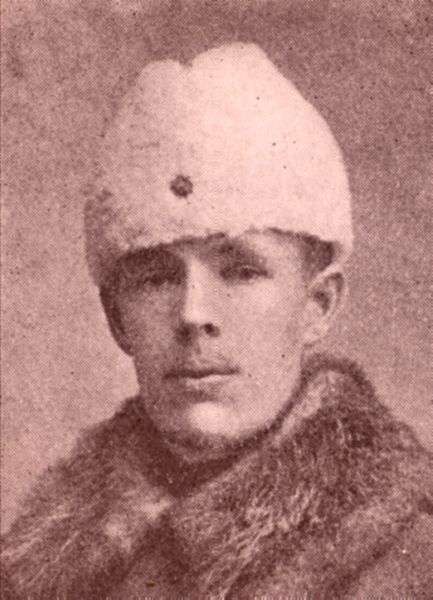
Aarne Snellman: (2. December 1894 - 28 April 1940 Helsinki): Snellman's father, Wilhelm Snellman was a district physician, his mother was Alexandra Sittkoff. Born on 1894, he matriculated from the Savonlinna Real Lyceum in 1912 and joined the Savo Students' Association. He continued his studies over the years 1912-1914 at the University of Helsinki Faculty of Philosophy and Economics and completed a first degree in Agriculture and Forest Management. He volunteered for the Finnish Jaegers and was awarded the German Iron Cross (Gruppenführer, JP27, awarded 1/26/1917). During the Finnish Civil War, Jaeger-Captain Snellman commanded Artillery Brigade 3. In 1920 he attended the French Military Pilots' School (Ecole d'Aviation Istres) and in 1921 he completed Finnish Pilot training (it was this early aviation background that led to Snellman being appointed General Staff Air Defense Officer).
He completed the Suojeluskuntas Officers course in 1926 and War College training over 1926-27. In 1927 he married Hildegund von Numersin. From 1934 to 1938 he served as Military Attache in Germany, from 1938-1939 he was the Commanding Officer, 3rd Field Artillery Regiment and over 1939 to early 1940 he was the Commanding Officer, Artillery, IV Corps. He was appointed Acting General Officer Commanding 12th Division following the death of the Division Commander in action, and after a replacement was found he took over as General Officer Commanding 17th Division. Colonel Aarne Snellman, commander of 17th Division, was seriously wounded when Soviet aircraft bombed his command post at Vaaseni on 13 April 1940. Promoted to Major-General on 26 April 1940, he died of wounds two days later.
OTL Note: real date of death was 26 April 1942 – events otherwise occurred as described. Some command periods adjusted, in reality he commanded these Divisions during the Continuation War.
For the Ilmavoimat and for Valtion Lentokonetehdas, the consequences of the 1931 Military Review were far-reaching, if sometimes slow to take effecxt. The views of the Restructuring Committee and Snellman’s report of 1931 as well as contributions from Somersalo and other Ilmavoimat officers were rolled into the 1931 Military Review, and having kept abreast of military affairs, Mannerheim and Walden were no strangers to the issues. Among Mannerheim’s first steps were the promotion of Somersalo to Lieutenant Colonel on 10-October-1931 (and to full Colonel on 8 September 1932 and then to Major-General in 1933 – a rapid rise indeed), the public expression of full support for Somersalo and a demand for immediate plans to be completed for the expansion both in capabilities and size for the Ilmavoimat and immediate financial budgetary arrangements allowing for the purchase of additional aircraft in 1931 and 1932. The other step (not quite so immediately) Mannerheim took was to change the management of Valtion Lentokonetehdas – on 1 January 1932, Engineer Erkki Mäkinen was appointed as Managing Director from among 24 applicants and Rudolph Walden became Chairman of the Board of Directors, giving him immediate oversight. The move of the Valtion Lentokonetehdas factory to Tampere was also approved at this time, although in this case it was Walden’s views on the location of the factory that carried the day. This incidentally, tended to be the general tenor of decisions taken by the Defense Triumvirate – Mannerheim tended to win the straight-out military decisions, Walden the industrial decisions and Ryti the financial. Where politics intruded, the views and influence of Vaino Tanner inevitably came into play, resulting at times in some interesting (but almost always practical) compromises.
We have already looked at the early attempts of IVL to design and build indigenous aircraft with the Berger designs for the C.24 and C.25, as well as the Kurki (“Järvinen's crate"). As a result of these failures, aircraft purchases had concentrated on either the purchase of built-up aircraft or the construction of imported designs built under license. The 1931 Military Review envisaged this mix continuing. It was considered too risky to rely entirely on aircraft purchased from foreign suppliers – in the event of war access to these would in all likeliehood be cut off. A domestic manufacturing capacity was needed, and it needed to be adequate to cope with the demands of the military in a war-time scenario. Stategically, attention was also paid to building up the ability to manufacture key components within Finland – hence the emphasis on the engine manufacturing capacity which resulted in the setting up first of the State Aircraft Factory (manufactiring Bristol Mercury and Rolls Royce Merlin engines under license) and then of the Tampella-Hispano-Suiza Factory (maunfacturing Hispano-Suiza aircraft engines). Likewise, there was a parallel emphasis on building up gun-manufacturing capacity – one component of which was the Hispano-Suiza 20mm cannon manufacturing plant.
Earlier mistakes, such as the purchase of the Koolhoven FK.31 from the Netherlands, the failure of the C.24, C.25 and Kurki projects were reviewed and initiatives currently underway which were experiencing problems such as the manufacturing of the Ripons were also looked into. A further issue addressed was the means and methods by which aircraft for the Ilmavoimat were selected and purchasing decisions were made. This all took some time, but the end result was a fairly major company restructuring that took place in 1933. Kurt Berger was one of those who took some of the blame and he was dismissed from the company (although his services as an advisor were retained). Ylinen was promoted to Construction Manager in 1934, and this together with substantially increased funding and the somewhat ruthless direction of the Chairman of the Board of Directors, Rudolph Walden, who was more than willing to step in and micromanage issues that needed to be addressed – bypassing or overriding VL’s management at times - and who continully emphasised the urgency of the situation and the speed with which projects needed to be completed, resulted in rapid progress and improvements.
Walden was not a man to accept excuses or tolerate failure and after a number of heads had rolled, progress became rather more rapid. In 1935 Valtion Lentokonetehdas was further re-organized, the works at Suomenlinna and Santahamina were closed and all design and production work was moved to the new facilities that were being built at or near Tampere. In 1936, the new Tampere factory employed 665 persons, but with the planned construction program getting underway, by the end of 1937 some 1,697 persons were employed, by late 1938 this had further increased to approximately 2,500 and by 1939 was somehwhat over 3,250. In addition, by 1939 the State Engine Factory employed some 1,000 personnel and plans were to double the number of personnel. In 1937, Walden implemented a further reorganisation of responsibilities. Valtion Lentokonetehdas would, from August 1937 on, be responsible the construction of new aircraft under license with the design and construction of indigenous aircraft as a secondary function.
Meanwhile, Veljekset Karhumäki (the "Karhumäki Brothers"), who also had a small aircraft construction business as well as a rather larger maintenance concern at Härmälä Airport, would be responsible for the assembly of all imported “built-up” aircraft as well as all the overhaul and repair of military aircraft that could not be performed by the Ilmavoimat Squadron maintenance personnel. An outright grant was given to Veljekset Karhumäki for the construction of additional hangers and maintenance workshops, together with a contract for ongoing maintenance work. At the same time, wartime contingency plans for the dispersal of facilities were drawn up and steps taken to put in place secondary and backup plants. In addition, as of mid-1937, it was becoming clear that the aircraft of the future would no longer be constructed primarily of fabric and wood but increasingly would be part or all-metal construction. Valtion Lentokonetehdas would need to rapidly build up expertise in this technology and Walden ensured steps were taken, including sending Engineers and other personnel abroad, to meet this need (the sending of Ylinen and two other engineers to Berlin to study aircraft engine design and construction was a small part of this program).
As new aircraft types were purchased and either assembled and maintained or manufactured under license Valtion Lentokonetehdas, Veljekset Karhumäki and Ilmavoimat maintenance personnel all acquired this experience and the expertise of the personnel within the small Finnish aviation industry rose to a very high level. As mentioned earlier, in 1927, the Ilmavoimat had been considering the purchase of Gloster Gamecock Fighters from Britain and on 23 March, 1927 the State Aircraft Factory (VL) received a single Gamecock from England for evaluation. At the same time, IVL had been experimenting with the Berger-designed prototype of the IVL Haukka, the Haukka I. This was built and made its maiden flight on March 17, 1927. This was immediately followed by the VL D.27 Haukka II - a further developed version of the D.26. Two aircraft were manufactured at the aircraft factory at Suomenlinna and in evaluations, the Haukka II turned out to have similar characteristics to the Gamecock, indeed, it proved to be the Gamecock’s equivalent in all regards.
Given the failure of Berger’s previous designs, a perhaps somewhat risky decision was made that the Haukka II would be ordered to equip a single Fighter Squadron, augmenting the single squadron of Martinsyde Buzzard Fighters then in service. An order for 17 aircraft was placed, with the Haukka’s to be manufactured at the VL aircraft factory at Suomenlinna. These were manufactured between 29 Oct, 1928 and 15 May, 1929. A further 23 Haukka’s were ordered in January 1929 and were manufactured between May 1929 and April 1930. In service, the Haukka II proved to be an effective and reliable fighter, well-liked by the Pilots and a good dog-fighter. Another (and this would later be significant) factor in the design and development of the Haukka was that it contributed considerably to the development of aircraft plywood in Finland – a factor that would prove critical later in the 1930’s. It would not be the last indigenous design to go intoproduction, but neither would there be a plethora of Finnish designed and built aircraft – the emphasis still remained in either purchasing aircraft outright, building an imported design under license or a combination of the two.
In the next Post, we will continue with a summary of Valtion Lentokonetehdas’ and the Ilmavoimat’s Purchase and Construction Program between 1927 and the Munich Crisis of 1938, covering each aircraft in detail.
An now - an interim side-bar to the current topic of of Valtion Lentokonetehdas’ and the Ilmavoimat’s Purchase and Construction Program
An Interesting Experiment
One of the inspectors of the Valtion Lentokonetehdas (VL) airplane engine workshop in the late 1930’s was Finnish engineer Toivo Jujani Kaario (b. Helsinki, 7 June 1912, d.Tampere, 20 October 1970). Kaario’s father, Hugo Johannes Kaario was also an Engineer, his mother was Iida Maria Appelqvist. The family had four children of whom Toivo was the oldest. Kaario took his matriculation examination in 1930 and completed his military service at the Santahamina factory over 1930-1931. Kaario had an early interest in aviation and at 14 years old he built his first powered aircraft model and had already during his school years, decided to become an airplane designer. With his glider flying experience, Kaario wished to become a Pilot in the Ilmavoimat and he sat Air Force entrance exams, but failed to qualift for pilot training due to poor vision. However, he was selected during his Conscript Service for Reserve Officer training, which he completed successfully, being promoted to lieutenant in July 1931.
In school, his interest in aviation had resulted in his being befriended by Ilmari Jäämaa, editor and writer for a number of different popular science type magazines. In 1929, Kaario had, with classmate Ensio Nuorteva, used a light car to tow one-man gliders. During his Conscript Service, Kaario also became acquainted with a motor transport that operated over the winter sea ice between Santahamina and the inner city of Helsinki. In 1932 Kaario started mechanical engineering courses at the Helsinki University of Technology, graduating as an engineer in December 1936. Following graduation, Kaario was immediately hired by the new and expanding State Aircraft Engine Factory as a service engineer. He was however, together with two other newly hired engineers immediately sent to Germany to study aero-engine design at the Charlottenburg University of Technology in Berlin where he remained for 1937 and 1938. The intention was that these three engineers would then taking leading roles in the new aircraft engine plant in Finland (where currently the bulk of the Engineers were foreigners hired to assist with establishing the factory and train Finnish employees).
At the start of 1939, Kaario returned to Finland together with his two colleagus and was transferred to the State Aircraft Engine’s new Linnavuori engine plant at Siuro where he was assigned to the aero-engine testing facility. Back in Finland, he now had the time to indulge into what had been a long-time hobby. In 1932, Kaario had come up with the idea of developing a vehicle utilising maavaikutusta (ground effect) and he had actually designed a gound-effect vehicle and built a small working model which worked by generating an air-cushion to support it. Over the winter of 1934-1935 Kaario went on to build the first Pintaliitäjäprototyypin (Pintaliitäjä=Surface Soarer, thus “Prototype Surface Soarer”), which was tested on the ice in January 1935.
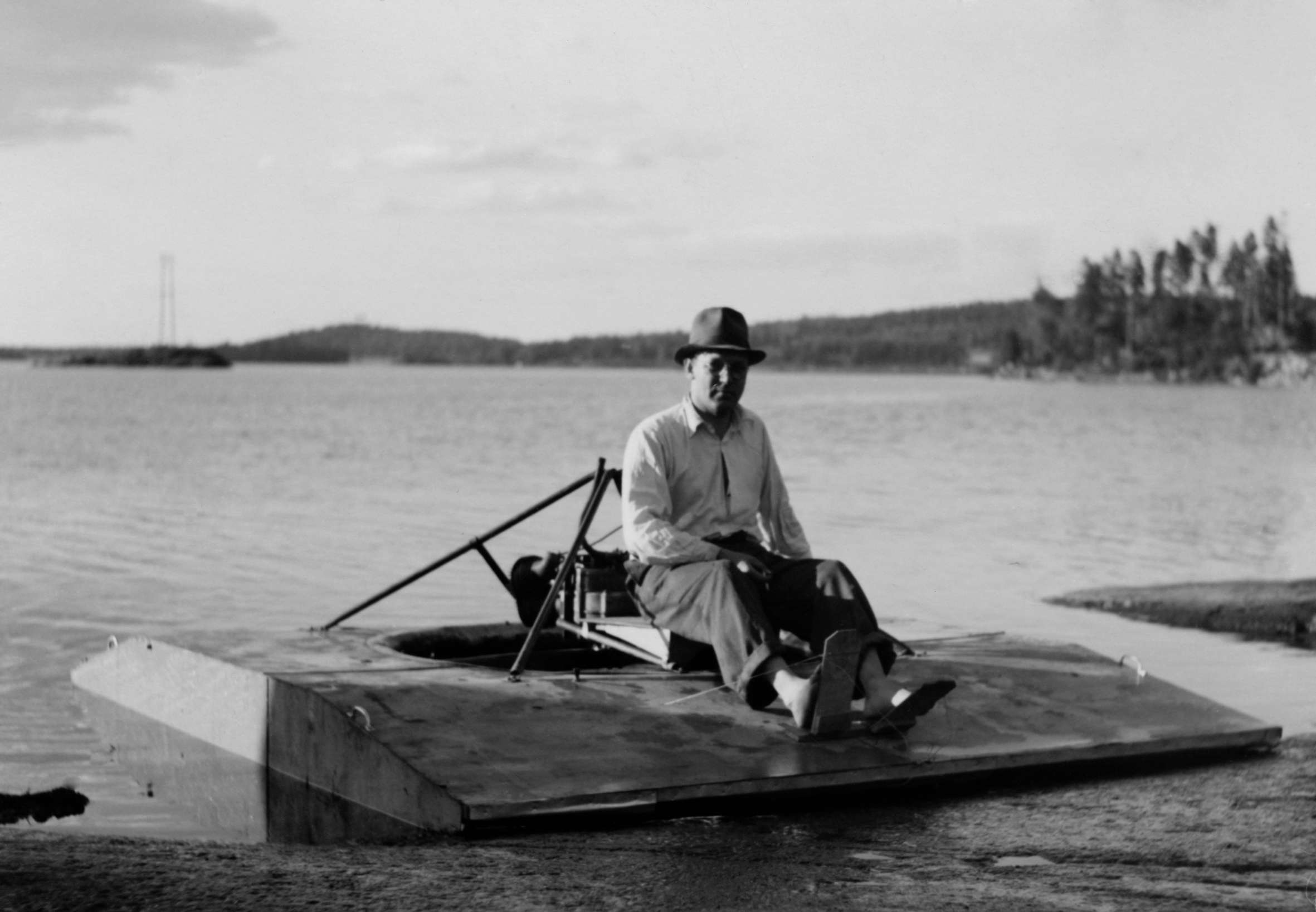
Toivo Kaario on an early Pintaliitäjäprototyypin in mid-1935
Based on experience testing the first prototype, Kaario went on to build a second prototype, Patosiipi No. 2 which he tested over 1935-1936. Kaario began to develop his theories concerning the use of ground-effect and built several models for further tests. As the ground-effect wing of Kaario’s early designs had an almost non-existent ability to block the loss of air being blown down by the propellor, the Patosiipi No. 2 was able to lift, but the ground-effect lift was weak. Kaario continued to experiment through 1936, building a further full-sized prototype powered by a 2-cylinder Harley-Davidson motorcycle engine but this time with a ”skirt” underneath which added to the lift by trapping the high pressure air that had been forced. This device was first tested on land and then on the water and was found to be slower but with more lift over an uneven surface. It was at this point that Kaario had discontinued his research and trials as he had graduated and is spare time in Berlin was largely taken up with his studies. However, he did have some free time....
And Kaario used this time well, bouncing his ideas around with German aviation experts, draw new designs, build and test models and come up with further improvements. In the late 1930’s when Kaario was in Germany, German aviation had been released from the shackles imposed after the defeat of WW1, the Luftwaffe was expanding rapidly, German aviation designers were trying out a variety of new ideas and concepts, some of them out there on the bleeding edge of technology, many of them merely leading edge, and Kaario found himself in the thick of this. His interests led him to make many contacts, and on his return to Finland in January 1939, Kaario had accumulated two years worth of ideas, thoughts and interaction with German aviation experts as well as having constructed and trialled a large number of models. Almost all his spare time was taken up with building and testing models and almost immediately he also began work on Patosiipi No. 8 which had substantially improved lift and air flow properties. At this stage a number of fellow workers at the State Aircraft Factory had become interested in his project and provided voluntary assistance. Work on Patosiipi No. 8 progressed rapidly tilizing a 53hp Porsche engine and before the snow was off the ground in the Spring of 1939, the device was first tested on land beside the Härmälä airport and then on the water at Siuro. The main problems experienced were vibration when driving on uneven ground and the inability of the prototype to drive over obstacles more than 20-cm-high. Sometimes serendipity plays its part in events. It was the testing beside Härmälä airport that inadvertantly led to far more rapid progress than Kaario had anticipated. Major-General Somersalo had been attending a meeting at the Airport whic had run late. On leaving, he happened to see the group working on Patosiipi No. 8 and stopped to watch as a test run was carried out, with the device reaching some 80kph while carrying two people. Intrigued, Somersalo had walked over to the group and started asking questions. At midnight, the entire group and Somersalo were still at the Airport with Kaario running an impromptu design review.
Two days later, Kaario and his team of volunteers found themselves doing a presentation to Somersalo, the head of the Merivoimat, Väinö Valve, the comanding officer of the Marine Jaegers, a small group of technical Officers and a couple of rather tough looking individuals in nondescript Maavoimat uniforms without any rank or branch identification. Kaario seized the opportunity and over a single day, he outlined the concepts and ideas he had put together while in Germany, starting with plans for a 100 ton Pintaliitäjä intended for transport on the Baltic Sea and with a cruising speed of 100-120kph, then moving on to concepts for a Fast Torpedo and Minelayer Pintaliitäjä and a High Speed Infantry Assault Pintaliitäjä. The ”ground effect” concept was explained in detail, and then demonstrated using Patosiipi No. 8, and Kaario’s ideas on how this could better be utilised were also explained (Kaario was perhaps the first to conceive of using a ”skirt” to trap air, rather than simply using ground-effect).
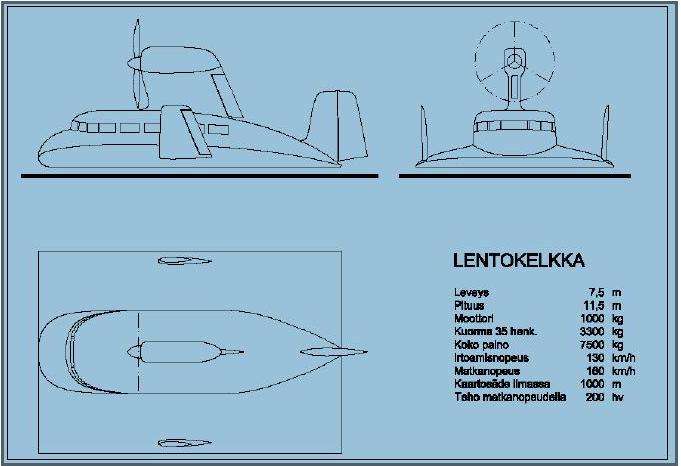
Line Drawing of Pintaliitäjä-Craft proposed by Kaario in Spring 1939
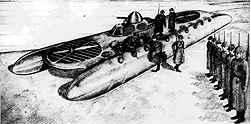
Rough Sketch of Infantry Assault Pintaliitäjä-Craft as proposed by Kaario in Spring 1939
The next morning he was summoned to the office of the Manager to find, not the Manager but the Commanding Officer of the Merivoimat, Väinö Valve. After a short and to the point discussion, Valve asked Kaario if he would take on a position as leader of a design and development team tasked with turning his Pintaliitäjä concept into a viable military weapon within a 12 month period. Adequate resourcing would be provided and the project would have the full backing of the Merivoimat. Kaario agreed. Almost immediately, a team was assembled and design work began for a full-size protoype of the Fast Torpedo and Minelayer Pintaliitäjä. The first prototype, maintaining the numbering sequence Kaario had initiated in 1932 was designated P-9, and had a very simple design which consisted of an elongated oblong shape made up two wooden catamaran hulls and powered by three aircraft engines using what we would now call a chamber configuration design. Two Mercury aero-engines were installed horizontally in the funnel-shaped wells on the platform which connected the catamaran hulls together. The third engine, also a Mercury, was placed in the aft part of the craft on a removable four-strut pylon. An air cushion was produced by the horizontally-placed engines. P-9 was designed and built over a one week period and was immediately trialled, achieving a speed of 70 knots, or about 130 kilometers per hour.
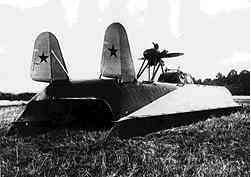
P-9 during initial trials in Spring 1939- the Red Star and ”CCCP” were painted on the sides to confuse any Observers, as it was known that the USSR was conducting trials on a similar type of craft designed by a Soviet engineer, Vladimir Levkov. It was hoped that any sightings of the Finnish craft would be confused with the Soviet Navy craft that had been observed carrying out trials.
The tests lasted for 10 days and at that time nobody other than Kaario and his small team of volunteers had any experience in operating such vehicles. Overwater runs were performed using all three engines running simultaneously, with the trials conducted in both calm and windy weather, crosswind and downwind, over flat shore and over swampy areas covered with sedge. Once the hovercrafts engines failed and the vehicle landed in a deep swamp. However, as soon as the engines were restarted, the boat ascended and recovered itself from the swamp. The maximum speed in the first runs was approximately 60 knots but in later tests 70 knots was easily reached and according to the P-9 test commander, a Merivoimat Fast Torpedo Boat commander, this was not on full power. Trial results of this first prototype hovercraft were acknowledged as very satisfactory. It was indicated in the report that the “principle for surface-soarer vehicles has been proven feasible.” This report was approved by the Commander of the Merivoimat, who directed that the Naval Construction Plan should encompass the production of two types of such skimming boats: one to be used as a fast attack torpedo craft and the other as a marine landing craft. Emergency Funds were allocated and the project was given the highest priority with a direction that three prototypes of each were to be constructed and completed by the end of summer 1939. This was a highly aggressive timetable, but one that the team worked day and night to meet.

P-10 at rest during a break in her initial trials P-10 had been designed over a four week period and a prototype was put together by mid-July 1939.
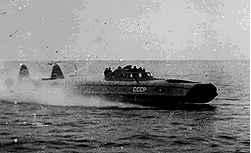
Performance Trials of P-10 on the Gulf of Finland, Summer of 1939. ”CCCP” was painted on the sides to confuse any Observers, as it was known that the USSR was conducting trials on a similar type of craft designed by a Soviet engineer, Vladimir Levkov. It was hoped that any sightings of the Finnish craft would be confused with the Soviet Navy craft that had been observed carrying out trials.
Building on knowledge gained from the P-10, a full-metal (duralumin) fast torpedo and infantry assault craft, designated P-11 was built in late summer 1939. The craft had a streamlined shape, in the midship area there was a streamlined pilot house/cabin for the pilot, mechanic and radio operator followed by a troop compartment, two turret (aircraft turrets were used, as had been done with some of the patrol torpedo boats) machine-gun mounts were installed on either side and slightly aft of the pilot-house and there was an aft mounted rear-facing 20mm cannon for AA protection. Directional control was provided by two large tail fins. Torpedo attachment points were arranged on either side of the troop compartment and the craft could also carry eight depth charges. The P-11 could surmount sandy strips, bogs, ice and rough seas, but was unstable during high speed turns. Regardless, a decision was made that it should go into production and by November 1939, the Merivoimat had 21 experimental air-cushion dual-purpose P-11 Pintaliitäjä-boats (High-Speed Torpedo Boats and Assault Craft) in service. The P-11 had a tonnage of 8.6-11.3 t, a crew of 7 men, a length of 24m, a width of 5.4 m, was armed with 2x12.7mm machineguns and 1x20mm Hispano-Suiza 20mm Cannon, carried two torpedoes, was powered by 2x1000hp Hispano-Suiza engines and could reach a top speed of 80 knots (approx 160kph).
As the Winter War broke out, Kaario’s team worked on manufacturing additional P-11 Pintaliitäjä-boats and repairing these that had been damaged while Kaario next began to work on an improved P-11 design as well and then, as this changed radically, it became the design for a larger and longer-ranged P-12 Pintaliitäjä-boat. With more P-11’s having been built and actually being used in operations during the early weeks of the Winter War, Kaario realised the craft had some serious shortcomings. Both good and discouraging reports were coming from the Merivoimat. The discouraging reports stated that pressure under the Pintaliitäjä-boats was low due to air escape through the vessels open ends, which reduced the load-carrying capacity; spray produced by the powerful engines limited visibility, the Pintaliitäjä-boats operations were limited to sea state 4 or less amd the impact of the Pintaliitäjä-boats with waves changed the settings of the louvres and occasionally damaged them. The engines also had problems with stalling when water penetrated into the exposed carburetors, and since the engines were positioned horizontally, they were not sufficiently air-cooled and would often overheat if run for long periods of time. Despite this, the Pintaliitäjä-boats had proved highly effective in combat due larely to their unbelievably high speeds.
Kaario and his design team worked 16 hour days working to rectify these problems, often sleeping under their desks in the ex-VL Suomenlinna factory building that was now their base. In the end, the ability of the P-11 design to cope with high speed turns seemed to improve with a substantial widening of the boat, first to 10m and then to 15m. As for lift, Kaario initially experimented with the building of a working model that demonstrated that by pumping air into a narrow tunnel around the perimeter of the underneath of the craft, it would flow towarda the center, creating a more effective air cushion. This peripheral jet would allow the air pressure to build enough to equal the weight of the craft and, since the air would be trapped, the pressure would elevate the craft off the surface upon which it traveled. By contrast, the P-11 utilised ground-effect, basically provided lift by using a propellor fan to force air from the deck down into the chamber between the two catamaran sides, which meant that air had to be continually pumped down to replace the air that escaped. After successfully trialling a model demonstrating that his new “air cushion” theory worked, Kaario redesigned P-12 incorporating a number of other modifications, a subject we shall return to after the Winter War.
OTL Note: Historically, Toivo Juhani Kaario was a Finnish engineer and inventor, who in the 1930s started working on prototypes of air cushion vehicles. Kaario is considered to have designed and built the first functional ground effect vehicles, but his invention did not receive sufficient funds for further development. Also, in this ATL I have shifted the dates by a couple of years to fit the scenario. But all else aside, Kaario WAS the first in the world to design and build functional ground effect vehicles and the Soviet engineer, Vladimir Levkov, followed his efforts as closely as was possible before building his pre-WW2 combat hovercraft for the USSR…… Toivo Kaario died at the age of 58 after a short illness in October 1970. He is buried at Tampere in the Kalevankangas Cemetery.
And now, back to Valtion Lentokonetehdas
Before we run through a history of aircraft construction by Valtion Lentokonetehdas, we’ll take a more indepth look at the new factory and at one of the key engineers – Arvo Ylinen.

Arvo Johannes Ylinen (b. Yläne, Southwest Finland on 5 March 1902 – and died 27 July 1975) was an aeronautical engineer and late a Professor of Aeronautical Engineering. His father was Juho Ylijaakkola and his mother was Sofia Emerentia Uusitalo. Arvo Ylinen graduating from high school in Turku came in 1923, attended University and graduated in 1930 with a Master of Science ”with Distinction” in Engineering, which was then very rare. In the same year he completed the CDI's military technical department graduate course. He studied aviation engineering at the Charlottenburg Technical School of the Berlin University of Technology over 1930-31 and later completed a doctoral thesus, which he defended at TKK in 1938. His dissertation was the first aircraft technology thesis completed in Finland.
He joined IVL at Suomenlinna, first working as a Design Engineer from 1932 to 1933. He was soon promoted to Office and Drawing Manager, a position he held from 1933 to 1934. In 1934 he was married to Lea Maria Hietarinta, a Medical Doctor. He held the position of Construction Manager from 1934 to 1937 and Technical Director from 1937-1940. He became the first TKK Professor of Aeronautical Engineering in 1940, a position he held until 1956. At the same time, he continued to serve as an Advisory Engineer to Valtion Lentokonetehdas from 1940 to 1949. From 1956 to 1967 he was Professor Engineering whilst also working as a Laboratory Director for VTT from 1952 to 1956. He chaired the National Defence Scientific Advisory Committee for 4 years from 1 October 1961. He received numerous awards and wrote and published many books and articles and held the rank of Lieutenant Colonel in the Army. Arvo Ylinen died on 27 July 1975.
Arvo Ylinen was instrumental in the major achievements of ”success years” of Valtion Lentokonetehdas, holding the key positions of Construction Manager from 1934 to 1937 and Technical Director from 1937-1940, the period in which VL expanded its capacity dramatically and manufactured the aircraft that would be critical to Finland’s survival in the Winter War. Ylinen, the Manager of Valtion Lentokonetehdas (xxx), Rudolph Walden as Chairmain of VL’s Board of Directors and Major-General Somersalo were between them the key figures responsible for increasing aircraft production, directing the selection and mix of aircraft and making sometimes risky and at times also radical decisions which in turn enabled the Ilmavoimat to outclass and outfight their opponents at every stage of the Winter War and through WW2. Even towards the end of WW2, aircraft such as the Ilmavoimat’s Fokker G1 and the Heinkel He112 Fighters were, thanks to continual upgrades, still effective fighters capable of more than holding their own. In the Winter War, they proved to be devastatingly effective, as we will see.
Returning now to the Valtion Lentokonetehdas factories, the works at Suomenlinna and Santahamina continued to be utilised through the first half of the 1930’s, with some limited construction of indigenous designs, construction of foreign aircraft under licenses and the assembly of aircraft purchased from foreign suppliers. The early years of IVL and VL had seen some mistakes – not the least of which had been the disastrous purchase of the Koolhoven FK.31 from the Netherlands virtually ”on spec”. At the same time, relations between the Commander of the Ilmavoimat, Major Somersalo and the General Staff had not improved to any great extent. As you may recall from an earlier Post, in 1924 the British Maj. Gen. Walter Kirke and a small team of British military advisors had carried out a Defence Review and made a number of recommendations on Finland’s defences, including recommendations that the Ilmavoimat concentrate on a float-plane based development plan. At the time this plan had been strongly opposed by the Commander of the Ilmavoimat, Major Somersalo. However, Somersalo’s views had been overruled by the General Staff, who were more inclined to take account of the recommendations of the so-called British ”experts” rather than those of a relatively junior Finnish Officer. Somersalo however had soldiered on despite the many obstacles in his path, doing his best to work around the limitations imposed by the Kirke Review, the views of the General Staff and the relative independance of I.V.L, which also caused many problems.
Relations between the General Staff and the Ilmavoimat Commander in 1930 were, as we have mentioned, not of the best. Major Somersalo did his best to work with what he had, but the funds allocated to the Ilmavoimat were limited, within the military hierarchy he was a fairly junior office and while serving as Commander of the Air Force, he had not been promoted – the Maavoimat was by far the larger and more influential of the services, commanding the lions share of the limited military budget through the 1920’s (albiet with increased naval spending in the latter years of the decade) and many of the decisions made were out of his hands and not subject to his control or influence. And the shift in control of Valtion Lentokonetehdas from the Ilmavoimat to the Ministry of Defence in 1928 had been just one more issue he had to face. Somersalo however persisted in the face of adversity, continuing to emphasize the development of a mix of capabilities, demanding the development of combat flying skills from his squadrons, continually emphasising the need for close support teamwork with the Maavoimat (Army) and Merivoimat (Navy) and doing his best to workaround the limitations imposed by the recommendations of the Kirke Review and the views of many in the Maavoimat, who at best considered the Ilmavoimat something of an irrelevance – useful perhaps for reconnaisance or artillery spotting but not much else. There were of course exceptions – the theorists in the Maavoimat making up most of these – but they tended to be the younger and more junior officers.
And then, in 1930 the General Staff set up a Restructuring Committee to look at the Ilmavoimat and aircraft purchasing and construction. The Committee completed their report in 1931 and stated among other conclusions that the views of the British Advisors from 1924 were obsolete. As a result the General Staff decided to improve their aviation warfare skills knowledge and appointed their own air defense officer. Lieutenant-Colonel Aarne Snellman was appointed to the post and almost immediately harshly criticized the constraints and operating limitations that had been imposed on the Ilmavoimat and expressed support for the views of the Commander of the Ilmavoimat, Major Somersalo. It was at this point, in March 1931 that Mannerheim was appointed to chair the Defence Council and also commissioned as overall Comander-in-Chief of the Armed Forces with Rudolph Walden appointed Minister of Defence in the All-Party Consensus of 1931. Mannerheim immediately initiated the 1931 Military Review, which was completed some six months later – and it was a six month period of heated and sometimes vitriolic debate within the Finnish Armed Forces.

Aarne Snellman: (2. December 1894 - 28 April 1940 Helsinki): Snellman's father, Wilhelm Snellman was a district physician, his mother was Alexandra Sittkoff. Born on 1894, he matriculated from the Savonlinna Real Lyceum in 1912 and joined the Savo Students' Association. He continued his studies over the years 1912-1914 at the University of Helsinki Faculty of Philosophy and Economics and completed a first degree in Agriculture and Forest Management. He volunteered for the Finnish Jaegers and was awarded the German Iron Cross (Gruppenführer, JP27, awarded 1/26/1917). During the Finnish Civil War, Jaeger-Captain Snellman commanded Artillery Brigade 3. In 1920 he attended the French Military Pilots' School (Ecole d'Aviation Istres) and in 1921 he completed Finnish Pilot training (it was this early aviation background that led to Snellman being appointed General Staff Air Defense Officer).
He completed the Suojeluskuntas Officers course in 1926 and War College training over 1926-27. In 1927 he married Hildegund von Numersin. From 1934 to 1938 he served as Military Attache in Germany, from 1938-1939 he was the Commanding Officer, 3rd Field Artillery Regiment and over 1939 to early 1940 he was the Commanding Officer, Artillery, IV Corps. He was appointed Acting General Officer Commanding 12th Division following the death of the Division Commander in action, and after a replacement was found he took over as General Officer Commanding 17th Division. Colonel Aarne Snellman, commander of 17th Division, was seriously wounded when Soviet aircraft bombed his command post at Vaaseni on 13 April 1940. Promoted to Major-General on 26 April 1940, he died of wounds two days later.
OTL Note: real date of death was 26 April 1942 – events otherwise occurred as described. Some command periods adjusted, in reality he commanded these Divisions during the Continuation War.
For the Ilmavoimat and for Valtion Lentokonetehdas, the consequences of the 1931 Military Review were far-reaching, if sometimes slow to take effecxt. The views of the Restructuring Committee and Snellman’s report of 1931 as well as contributions from Somersalo and other Ilmavoimat officers were rolled into the 1931 Military Review, and having kept abreast of military affairs, Mannerheim and Walden were no strangers to the issues. Among Mannerheim’s first steps were the promotion of Somersalo to Lieutenant Colonel on 10-October-1931 (and to full Colonel on 8 September 1932 and then to Major-General in 1933 – a rapid rise indeed), the public expression of full support for Somersalo and a demand for immediate plans to be completed for the expansion both in capabilities and size for the Ilmavoimat and immediate financial budgetary arrangements allowing for the purchase of additional aircraft in 1931 and 1932. The other step (not quite so immediately) Mannerheim took was to change the management of Valtion Lentokonetehdas – on 1 January 1932, Engineer Erkki Mäkinen was appointed as Managing Director from among 24 applicants and Rudolph Walden became Chairman of the Board of Directors, giving him immediate oversight. The move of the Valtion Lentokonetehdas factory to Tampere was also approved at this time, although in this case it was Walden’s views on the location of the factory that carried the day. This incidentally, tended to be the general tenor of decisions taken by the Defense Triumvirate – Mannerheim tended to win the straight-out military decisions, Walden the industrial decisions and Ryti the financial. Where politics intruded, the views and influence of Vaino Tanner inevitably came into play, resulting at times in some interesting (but almost always practical) compromises.
We have already looked at the early attempts of IVL to design and build indigenous aircraft with the Berger designs for the C.24 and C.25, as well as the Kurki (“Järvinen's crate"). As a result of these failures, aircraft purchases had concentrated on either the purchase of built-up aircraft or the construction of imported designs built under license. The 1931 Military Review envisaged this mix continuing. It was considered too risky to rely entirely on aircraft purchased from foreign suppliers – in the event of war access to these would in all likeliehood be cut off. A domestic manufacturing capacity was needed, and it needed to be adequate to cope with the demands of the military in a war-time scenario. Stategically, attention was also paid to building up the ability to manufacture key components within Finland – hence the emphasis on the engine manufacturing capacity which resulted in the setting up first of the State Aircraft Factory (manufactiring Bristol Mercury and Rolls Royce Merlin engines under license) and then of the Tampella-Hispano-Suiza Factory (maunfacturing Hispano-Suiza aircraft engines). Likewise, there was a parallel emphasis on building up gun-manufacturing capacity – one component of which was the Hispano-Suiza 20mm cannon manufacturing plant.
Earlier mistakes, such as the purchase of the Koolhoven FK.31 from the Netherlands, the failure of the C.24, C.25 and Kurki projects were reviewed and initiatives currently underway which were experiencing problems such as the manufacturing of the Ripons were also looked into. A further issue addressed was the means and methods by which aircraft for the Ilmavoimat were selected and purchasing decisions were made. This all took some time, but the end result was a fairly major company restructuring that took place in 1933. Kurt Berger was one of those who took some of the blame and he was dismissed from the company (although his services as an advisor were retained). Ylinen was promoted to Construction Manager in 1934, and this together with substantially increased funding and the somewhat ruthless direction of the Chairman of the Board of Directors, Rudolph Walden, who was more than willing to step in and micromanage issues that needed to be addressed – bypassing or overriding VL’s management at times - and who continully emphasised the urgency of the situation and the speed with which projects needed to be completed, resulted in rapid progress and improvements.
Walden was not a man to accept excuses or tolerate failure and after a number of heads had rolled, progress became rather more rapid. In 1935 Valtion Lentokonetehdas was further re-organized, the works at Suomenlinna and Santahamina were closed and all design and production work was moved to the new facilities that were being built at or near Tampere. In 1936, the new Tampere factory employed 665 persons, but with the planned construction program getting underway, by the end of 1937 some 1,697 persons were employed, by late 1938 this had further increased to approximately 2,500 and by 1939 was somehwhat over 3,250. In addition, by 1939 the State Engine Factory employed some 1,000 personnel and plans were to double the number of personnel. In 1937, Walden implemented a further reorganisation of responsibilities. Valtion Lentokonetehdas would, from August 1937 on, be responsible the construction of new aircraft under license with the design and construction of indigenous aircraft as a secondary function.
Meanwhile, Veljekset Karhumäki (the "Karhumäki Brothers"), who also had a small aircraft construction business as well as a rather larger maintenance concern at Härmälä Airport, would be responsible for the assembly of all imported “built-up” aircraft as well as all the overhaul and repair of military aircraft that could not be performed by the Ilmavoimat Squadron maintenance personnel. An outright grant was given to Veljekset Karhumäki for the construction of additional hangers and maintenance workshops, together with a contract for ongoing maintenance work. At the same time, wartime contingency plans for the dispersal of facilities were drawn up and steps taken to put in place secondary and backup plants. In addition, as of mid-1937, it was becoming clear that the aircraft of the future would no longer be constructed primarily of fabric and wood but increasingly would be part or all-metal construction. Valtion Lentokonetehdas would need to rapidly build up expertise in this technology and Walden ensured steps were taken, including sending Engineers and other personnel abroad, to meet this need (the sending of Ylinen and two other engineers to Berlin to study aircraft engine design and construction was a small part of this program).
As new aircraft types were purchased and either assembled and maintained or manufactured under license Valtion Lentokonetehdas, Veljekset Karhumäki and Ilmavoimat maintenance personnel all acquired this experience and the expertise of the personnel within the small Finnish aviation industry rose to a very high level. As mentioned earlier, in 1927, the Ilmavoimat had been considering the purchase of Gloster Gamecock Fighters from Britain and on 23 March, 1927 the State Aircraft Factory (VL) received a single Gamecock from England for evaluation. At the same time, IVL had been experimenting with the Berger-designed prototype of the IVL Haukka, the Haukka I. This was built and made its maiden flight on March 17, 1927. This was immediately followed by the VL D.27 Haukka II - a further developed version of the D.26. Two aircraft were manufactured at the aircraft factory at Suomenlinna and in evaluations, the Haukka II turned out to have similar characteristics to the Gamecock, indeed, it proved to be the Gamecock’s equivalent in all regards.
Given the failure of Berger’s previous designs, a perhaps somewhat risky decision was made that the Haukka II would be ordered to equip a single Fighter Squadron, augmenting the single squadron of Martinsyde Buzzard Fighters then in service. An order for 17 aircraft was placed, with the Haukka’s to be manufactured at the VL aircraft factory at Suomenlinna. These were manufactured between 29 Oct, 1928 and 15 May, 1929. A further 23 Haukka’s were ordered in January 1929 and were manufactured between May 1929 and April 1930. In service, the Haukka II proved to be an effective and reliable fighter, well-liked by the Pilots and a good dog-fighter. Another (and this would later be significant) factor in the design and development of the Haukka was that it contributed considerably to the development of aircraft plywood in Finland – a factor that would prove critical later in the 1930’s. It would not be the last indigenous design to go intoproduction, but neither would there be a plethora of Finnish designed and built aircraft – the emphasis still remained in either purchasing aircraft outright, building an imported design under license or a combination of the two.
In the next Post, we will continue with a summary of Valtion Lentokonetehdas’ and the Ilmavoimat’s Purchase and Construction Program between 1927 and the Munich Crisis of 1938, covering each aircraft in detail.
An now - an interim side-bar to the current topic of of Valtion Lentokonetehdas’ and the Ilmavoimat’s Purchase and Construction Program
An Interesting Experiment
One of the inspectors of the Valtion Lentokonetehdas (VL) airplane engine workshop in the late 1930’s was Finnish engineer Toivo Jujani Kaario (b. Helsinki, 7 June 1912, d.Tampere, 20 October 1970). Kaario’s father, Hugo Johannes Kaario was also an Engineer, his mother was Iida Maria Appelqvist. The family had four children of whom Toivo was the oldest. Kaario took his matriculation examination in 1930 and completed his military service at the Santahamina factory over 1930-1931. Kaario had an early interest in aviation and at 14 years old he built his first powered aircraft model and had already during his school years, decided to become an airplane designer. With his glider flying experience, Kaario wished to become a Pilot in the Ilmavoimat and he sat Air Force entrance exams, but failed to qualift for pilot training due to poor vision. However, he was selected during his Conscript Service for Reserve Officer training, which he completed successfully, being promoted to lieutenant in July 1931.
In school, his interest in aviation had resulted in his being befriended by Ilmari Jäämaa, editor and writer for a number of different popular science type magazines. In 1929, Kaario had, with classmate Ensio Nuorteva, used a light car to tow one-man gliders. During his Conscript Service, Kaario also became acquainted with a motor transport that operated over the winter sea ice between Santahamina and the inner city of Helsinki. In 1932 Kaario started mechanical engineering courses at the Helsinki University of Technology, graduating as an engineer in December 1936. Following graduation, Kaario was immediately hired by the new and expanding State Aircraft Engine Factory as a service engineer. He was however, together with two other newly hired engineers immediately sent to Germany to study aero-engine design at the Charlottenburg University of Technology in Berlin where he remained for 1937 and 1938. The intention was that these three engineers would then taking leading roles in the new aircraft engine plant in Finland (where currently the bulk of the Engineers were foreigners hired to assist with establishing the factory and train Finnish employees).
At the start of 1939, Kaario returned to Finland together with his two colleagus and was transferred to the State Aircraft Engine’s new Linnavuori engine plant at Siuro where he was assigned to the aero-engine testing facility. Back in Finland, he now had the time to indulge into what had been a long-time hobby. In 1932, Kaario had come up with the idea of developing a vehicle utilising maavaikutusta (ground effect) and he had actually designed a gound-effect vehicle and built a small working model which worked by generating an air-cushion to support it. Over the winter of 1934-1935 Kaario went on to build the first Pintaliitäjäprototyypin (Pintaliitäjä=Surface Soarer, thus “Prototype Surface Soarer”), which was tested on the ice in January 1935.

Toivo Kaario on an early Pintaliitäjäprototyypin in mid-1935
Based on experience testing the first prototype, Kaario went on to build a second prototype, Patosiipi No. 2 which he tested over 1935-1936. Kaario began to develop his theories concerning the use of ground-effect and built several models for further tests. As the ground-effect wing of Kaario’s early designs had an almost non-existent ability to block the loss of air being blown down by the propellor, the Patosiipi No. 2 was able to lift, but the ground-effect lift was weak. Kaario continued to experiment through 1936, building a further full-sized prototype powered by a 2-cylinder Harley-Davidson motorcycle engine but this time with a ”skirt” underneath which added to the lift by trapping the high pressure air that had been forced. This device was first tested on land and then on the water and was found to be slower but with more lift over an uneven surface. It was at this point that Kaario had discontinued his research and trials as he had graduated and is spare time in Berlin was largely taken up with his studies. However, he did have some free time....
And Kaario used this time well, bouncing his ideas around with German aviation experts, draw new designs, build and test models and come up with further improvements. In the late 1930’s when Kaario was in Germany, German aviation had been released from the shackles imposed after the defeat of WW1, the Luftwaffe was expanding rapidly, German aviation designers were trying out a variety of new ideas and concepts, some of them out there on the bleeding edge of technology, many of them merely leading edge, and Kaario found himself in the thick of this. His interests led him to make many contacts, and on his return to Finland in January 1939, Kaario had accumulated two years worth of ideas, thoughts and interaction with German aviation experts as well as having constructed and trialled a large number of models. Almost all his spare time was taken up with building and testing models and almost immediately he also began work on Patosiipi No. 8 which had substantially improved lift and air flow properties. At this stage a number of fellow workers at the State Aircraft Factory had become interested in his project and provided voluntary assistance. Work on Patosiipi No. 8 progressed rapidly tilizing a 53hp Porsche engine and before the snow was off the ground in the Spring of 1939, the device was first tested on land beside the Härmälä airport and then on the water at Siuro. The main problems experienced were vibration when driving on uneven ground and the inability of the prototype to drive over obstacles more than 20-cm-high. Sometimes serendipity plays its part in events. It was the testing beside Härmälä airport that inadvertantly led to far more rapid progress than Kaario had anticipated. Major-General Somersalo had been attending a meeting at the Airport whic had run late. On leaving, he happened to see the group working on Patosiipi No. 8 and stopped to watch as a test run was carried out, with the device reaching some 80kph while carrying two people. Intrigued, Somersalo had walked over to the group and started asking questions. At midnight, the entire group and Somersalo were still at the Airport with Kaario running an impromptu design review.
Two days later, Kaario and his team of volunteers found themselves doing a presentation to Somersalo, the head of the Merivoimat, Väinö Valve, the comanding officer of the Marine Jaegers, a small group of technical Officers and a couple of rather tough looking individuals in nondescript Maavoimat uniforms without any rank or branch identification. Kaario seized the opportunity and over a single day, he outlined the concepts and ideas he had put together while in Germany, starting with plans for a 100 ton Pintaliitäjä intended for transport on the Baltic Sea and with a cruising speed of 100-120kph, then moving on to concepts for a Fast Torpedo and Minelayer Pintaliitäjä and a High Speed Infantry Assault Pintaliitäjä. The ”ground effect” concept was explained in detail, and then demonstrated using Patosiipi No. 8, and Kaario’s ideas on how this could better be utilised were also explained (Kaario was perhaps the first to conceive of using a ”skirt” to trap air, rather than simply using ground-effect).

Line Drawing of Pintaliitäjä-Craft proposed by Kaario in Spring 1939

Rough Sketch of Infantry Assault Pintaliitäjä-Craft as proposed by Kaario in Spring 1939
The next morning he was summoned to the office of the Manager to find, not the Manager but the Commanding Officer of the Merivoimat, Väinö Valve. After a short and to the point discussion, Valve asked Kaario if he would take on a position as leader of a design and development team tasked with turning his Pintaliitäjä concept into a viable military weapon within a 12 month period. Adequate resourcing would be provided and the project would have the full backing of the Merivoimat. Kaario agreed. Almost immediately, a team was assembled and design work began for a full-size protoype of the Fast Torpedo and Minelayer Pintaliitäjä. The first prototype, maintaining the numbering sequence Kaario had initiated in 1932 was designated P-9, and had a very simple design which consisted of an elongated oblong shape made up two wooden catamaran hulls and powered by three aircraft engines using what we would now call a chamber configuration design. Two Mercury aero-engines were installed horizontally in the funnel-shaped wells on the platform which connected the catamaran hulls together. The third engine, also a Mercury, was placed in the aft part of the craft on a removable four-strut pylon. An air cushion was produced by the horizontally-placed engines. P-9 was designed and built over a one week period and was immediately trialled, achieving a speed of 70 knots, or about 130 kilometers per hour.

P-9 during initial trials in Spring 1939- the Red Star and ”CCCP” were painted on the sides to confuse any Observers, as it was known that the USSR was conducting trials on a similar type of craft designed by a Soviet engineer, Vladimir Levkov. It was hoped that any sightings of the Finnish craft would be confused with the Soviet Navy craft that had been observed carrying out trials.
The tests lasted for 10 days and at that time nobody other than Kaario and his small team of volunteers had any experience in operating such vehicles. Overwater runs were performed using all three engines running simultaneously, with the trials conducted in both calm and windy weather, crosswind and downwind, over flat shore and over swampy areas covered with sedge. Once the hovercrafts engines failed and the vehicle landed in a deep swamp. However, as soon as the engines were restarted, the boat ascended and recovered itself from the swamp. The maximum speed in the first runs was approximately 60 knots but in later tests 70 knots was easily reached and according to the P-9 test commander, a Merivoimat Fast Torpedo Boat commander, this was not on full power. Trial results of this first prototype hovercraft were acknowledged as very satisfactory. It was indicated in the report that the “principle for surface-soarer vehicles has been proven feasible.” This report was approved by the Commander of the Merivoimat, who directed that the Naval Construction Plan should encompass the production of two types of such skimming boats: one to be used as a fast attack torpedo craft and the other as a marine landing craft. Emergency Funds were allocated and the project was given the highest priority with a direction that three prototypes of each were to be constructed and completed by the end of summer 1939. This was a highly aggressive timetable, but one that the team worked day and night to meet.

P-10 at rest during a break in her initial trials P-10 had been designed over a four week period and a prototype was put together by mid-July 1939.

Performance Trials of P-10 on the Gulf of Finland, Summer of 1939. ”CCCP” was painted on the sides to confuse any Observers, as it was known that the USSR was conducting trials on a similar type of craft designed by a Soviet engineer, Vladimir Levkov. It was hoped that any sightings of the Finnish craft would be confused with the Soviet Navy craft that had been observed carrying out trials.
Building on knowledge gained from the P-10, a full-metal (duralumin) fast torpedo and infantry assault craft, designated P-11 was built in late summer 1939. The craft had a streamlined shape, in the midship area there was a streamlined pilot house/cabin for the pilot, mechanic and radio operator followed by a troop compartment, two turret (aircraft turrets were used, as had been done with some of the patrol torpedo boats) machine-gun mounts were installed on either side and slightly aft of the pilot-house and there was an aft mounted rear-facing 20mm cannon for AA protection. Directional control was provided by two large tail fins. Torpedo attachment points were arranged on either side of the troop compartment and the craft could also carry eight depth charges. The P-11 could surmount sandy strips, bogs, ice and rough seas, but was unstable during high speed turns. Regardless, a decision was made that it should go into production and by November 1939, the Merivoimat had 21 experimental air-cushion dual-purpose P-11 Pintaliitäjä-boats (High-Speed Torpedo Boats and Assault Craft) in service. The P-11 had a tonnage of 8.6-11.3 t, a crew of 7 men, a length of 24m, a width of 5.4 m, was armed with 2x12.7mm machineguns and 1x20mm Hispano-Suiza 20mm Cannon, carried two torpedoes, was powered by 2x1000hp Hispano-Suiza engines and could reach a top speed of 80 knots (approx 160kph).
As the Winter War broke out, Kaario’s team worked on manufacturing additional P-11 Pintaliitäjä-boats and repairing these that had been damaged while Kaario next began to work on an improved P-11 design as well and then, as this changed radically, it became the design for a larger and longer-ranged P-12 Pintaliitäjä-boat. With more P-11’s having been built and actually being used in operations during the early weeks of the Winter War, Kaario realised the craft had some serious shortcomings. Both good and discouraging reports were coming from the Merivoimat. The discouraging reports stated that pressure under the Pintaliitäjä-boats was low due to air escape through the vessels open ends, which reduced the load-carrying capacity; spray produced by the powerful engines limited visibility, the Pintaliitäjä-boats operations were limited to sea state 4 or less amd the impact of the Pintaliitäjä-boats with waves changed the settings of the louvres and occasionally damaged them. The engines also had problems with stalling when water penetrated into the exposed carburetors, and since the engines were positioned horizontally, they were not sufficiently air-cooled and would often overheat if run for long periods of time. Despite this, the Pintaliitäjä-boats had proved highly effective in combat due larely to their unbelievably high speeds.
Kaario and his design team worked 16 hour days working to rectify these problems, often sleeping under their desks in the ex-VL Suomenlinna factory building that was now their base. In the end, the ability of the P-11 design to cope with high speed turns seemed to improve with a substantial widening of the boat, first to 10m and then to 15m. As for lift, Kaario initially experimented with the building of a working model that demonstrated that by pumping air into a narrow tunnel around the perimeter of the underneath of the craft, it would flow towarda the center, creating a more effective air cushion. This peripheral jet would allow the air pressure to build enough to equal the weight of the craft and, since the air would be trapped, the pressure would elevate the craft off the surface upon which it traveled. By contrast, the P-11 utilised ground-effect, basically provided lift by using a propellor fan to force air from the deck down into the chamber between the two catamaran sides, which meant that air had to be continually pumped down to replace the air that escaped. After successfully trialling a model demonstrating that his new “air cushion” theory worked, Kaario redesigned P-12 incorporating a number of other modifications, a subject we shall return to after the Winter War.
OTL Note: Historically, Toivo Juhani Kaario was a Finnish engineer and inventor, who in the 1930s started working on prototypes of air cushion vehicles. Kaario is considered to have designed and built the first functional ground effect vehicles, but his invention did not receive sufficient funds for further development. Also, in this ATL I have shifted the dates by a couple of years to fit the scenario. But all else aside, Kaario WAS the first in the world to design and build functional ground effect vehicles and the Soviet engineer, Vladimir Levkov, followed his efforts as closely as was possible before building his pre-WW2 combat hovercraft for the USSR…… Toivo Kaario died at the age of 58 after a short illness in October 1970. He is buried at Tampere in the Kalevankangas Cemetery.
A little more on Valtion Lentokonetehdas through the 1930's
A little more on Valtion Lentokonetehdas through the 1930’s
As we have seen, Valtion Lentokonetehdas was established outside Tampere over 1935-1936, with the State Aircraft Factory being established nearby over the same period and producing Bristol Mercury and Rolls Royce Merlin engines in small numbers. The second aircraft-engine facility set up in Finland was the Tampella-Hispano-Suiza Aircraft Engine Company, established in 1936 to manufacture the Hispano-Suiza 12Y Aircraft Engine and with the plant beginning production in 1937. We have also covered the establishment of the Hispano-Suiza cannon factory in the late thirties (as we will see in a later post, this factory was one of a number involved in the production of weapons and munitions in the Tampere area). In addition, Veljekset Karhumäki (the "Karhumäki Brothers"), with their location at Härmälä Airport were also involved in small scale aircraft construction and, after the signing of contracts and receiving of grants for the construction of facilities from the government, involved in the assembly of imported aircraft and the maintenance and repair of all Ilmavoimat aircraft.
All of this expansion meant that the aircraft industry and its offshoots were a major employer in the area, with the new industrial area of Halli largely created by these factories. The location of these around the area of Härmälä Airport also resulted in the Ilmavoimat Flight Depot and Test Flight Section to the region, as well as the establishment of an Ilmavoimat base at the airfield. Test flying was important in peace time, because flight training caused a lot of damage to the aircraft and that in turn meant repair work for the industry. Information about new Ilmavoimat planes was also gathered through test flights, as while there were manuals available, they often did n ot reflect the true capabilities and limitations of the aircraft. And with Veljekset Karhumäki already operating civilian flight training and building small aircraft for private use, Härmälä Airport was busy from the start. In the Spring of 1937, Marshal Mannerheim had made a surprise visit to the Veljekset Karhumäki airplane workshop in Keljo. Later that same year, the engineers Koskiala and Kuusinen suggested that the company should expand and relocate from Keljo to a more suitable site. In late 1937, after the signing of the contract for aircraft assembly and maintenance and the recieving of the government grant for construction of larger and improved facilities, the Veljekset Karhumäki airplane workshop in Keljo was relocated to Kuorevesi and became increasingly busy, employing some 750 workers by mid-1938.
Over the period we are looking at in this post, from 1931 to late 1938, Valtion Lentokonetehdas went on to build a number of aircraft under license as well as continuing work by its own aircraft design department as well. Several Finnish designed aircraft types were produced by the factory between 1930 and the end of WW2, although in this post we will only cover the period to late 1938. Several designs for aircraft were developed, with prototypes flying and in the 1930s, generally achieving comparable performance with foreign types. While the primary aircraft types were usually bought abroad, since buying these was often cheaper than building an entire new aircraft in Finland, Valtion Lentokonetehdas did build some of its own designed for the Ilmavoimat. And course there was fairly large scale (for Finland) construction of aircraft such as the license built Fokker D.XXIs and Blenheims. The Fokker D.XXI however was so thoroughly redesigned in Finland, that the locally built Fokkers ended up being more Finnish-designed than Dutch. From late 1937, a clear division of responsibilities with Veljekset Karhumäki had been established and each Company had a clear set of priorities. This carried through into the Winter War itself, with Walden as both Defence Minister and Chairman of the Board of VL immediately resolving any disagreements to his own satisfaction, if not to the satisfaction of the Managers of the respective enterprises.
And with the establishment of the new Valtion Lentokonetehdas factory at Tampere, the capabilities of the company rapidly improved. This was achieved under the direction of the Board of Directors (Rudolp Walden-Chairman, Prof. Martti Levon-Vice Chairman, K. Heimonen, Akseli Linnavuori, Eljas Erkko and J. E. Pilppula) and the Management Team (Erkki Mäkinen-Managing Director, Arvo Ylinen-Technical Manager, Arvi Airola-Works Manager, V. Kivenheimo-Secretary). Considerable progress was made with the development of aero accessories and the production of factory-design streamline aircraft-skis, bakelite glued plywood floats and compressed Birch airscrews.
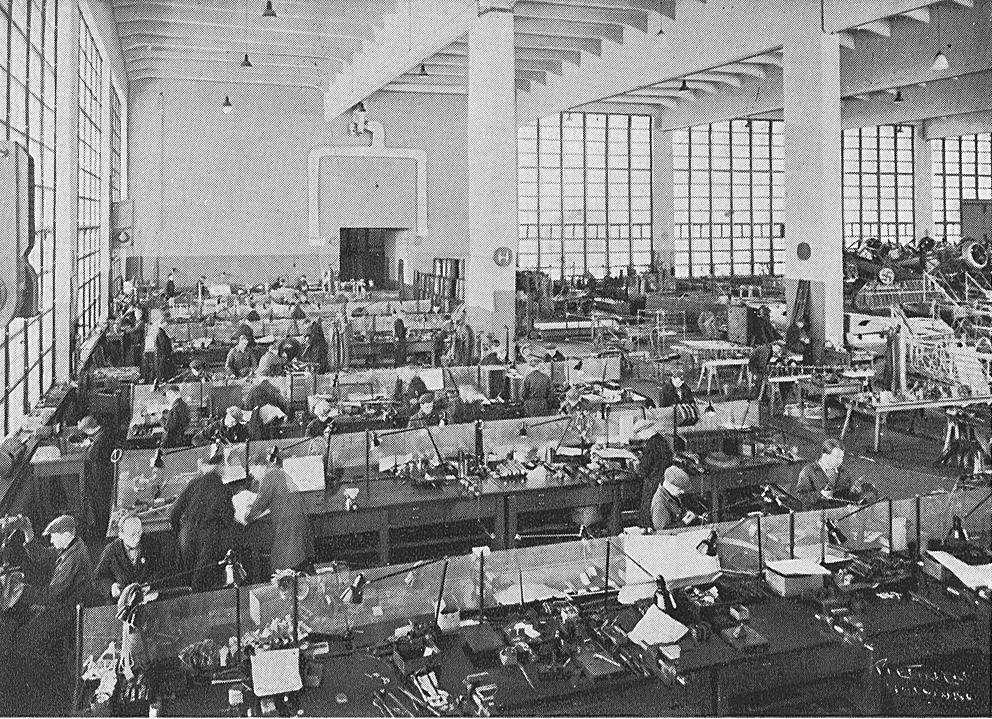
VL Design Shop – new Tampere Factory

VL WorkShop – new Tampere Factory
From 1933 on, the airscrews produced by Valtion Lentokonetehdas were manufactured according to a Factory-patented method using a birch plywood specially designed and improved for this purpose. By utilising this method it proved possible to make airscrews of exclusively domestic birch-wood. The properties of these airscrews – steadfastness of shape without any special protective covering, a narrow and aero-dynamically advantageous form, the possibility of fastening the blades to a metal hub – are to a great extent comparable to metal aircsrews but are much lighter in weight and cheaper than the metal alternative. Resistance to fracture or splitting is very great compared to that of natural airscrew woods. In addition, the resistance to projectiles is much better than in metal airscrews – bullets leave only small holes in the airscrew. Another important advantage of these airscrews is the great rigidity of the blades, which is especially useful with regard to vibration and tip flutter. Furthermore, “fatigue” which is a characteristic of metal airscrews which is controlled with difficulty – is practically unknown in these compressed-wood airscrews.
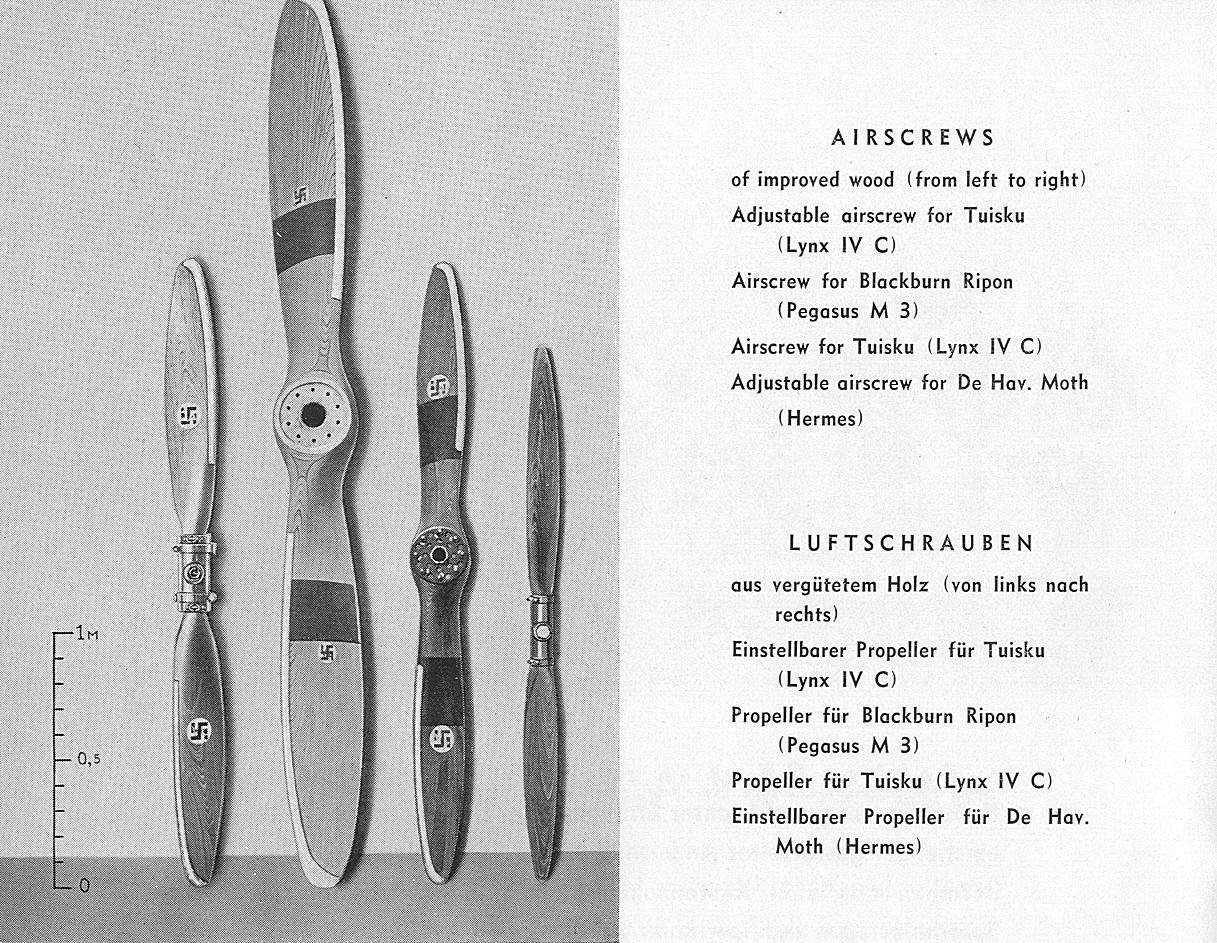
VL Airscrews –produced by the new Tampere Factory

VL Airscrew Manufacturing in the new Tampere Factory
Valtion Lentokonetehdas also excelled in the design of snow, ice and extreme-col related accessories and equipment for aircraft as well as in floats for seaplanes. This was largely dictated by the extreme weather conditions aircraft in Finland operated in as well as the conditions in summer, which provided an ideal environment for the operation of floatplanes. While useful for Finland, these were unfortunately not conditions which applied through much of the rest of the world, meaning that while VL excelled in these products, there was no potentially large export market to be tapped into. By the 1930’s, VL had lengthy experience in the construction of aircraft skis. These were made in eight different sizes for aircraft varying in wight from 600kg to 3700kg. VL developed streamlined skiis for different types of modern aircraft, the the aerodynamically most advantageous skis built with a bottom-layer of Finnish pine covered with steel sheets. The supports were made of welded steel sheet construction and were supplied with brakes which locked the skis, preventing movement when flying (and especially when diving). The shaping was made of aluminium sheets and allowed the skis to flex under landing loads.
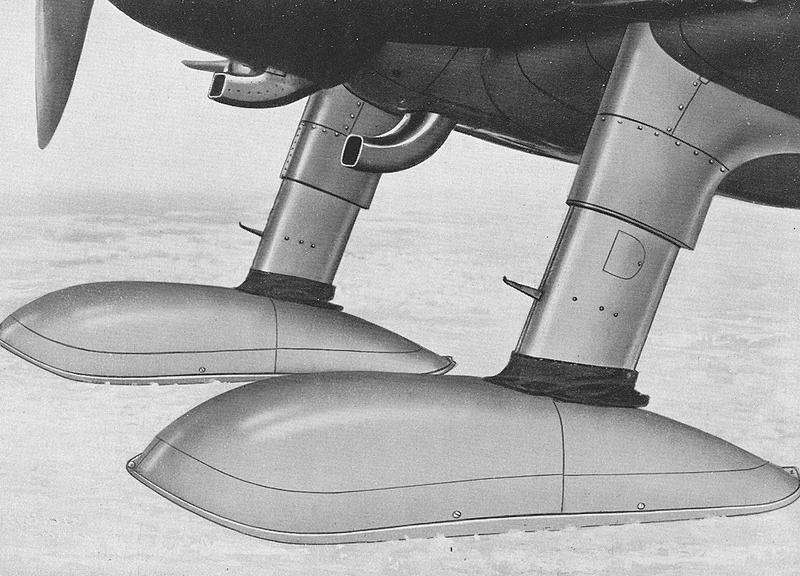
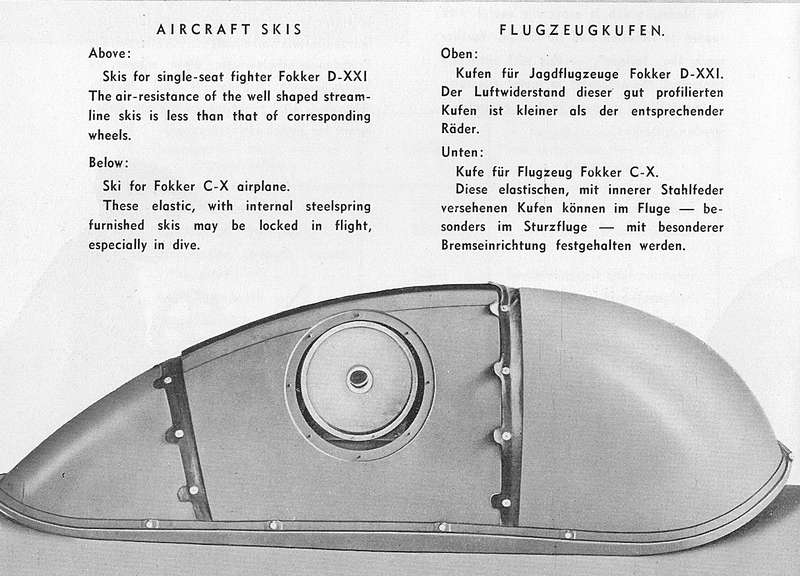
VL Skis from a 1938 Valtion Lentokonetehdas Brochure
Valtion Lentokonetehdas built aircraft floats from Finnish pine covered with baelite-glued plywood and furnished with rudders. The floats were furnished with inspection holes which could be easily opened for ventilation. The colume of the float for the VL-designed and built Tuisku was about 1.5 cubic meters and it weighted 95.5kg.
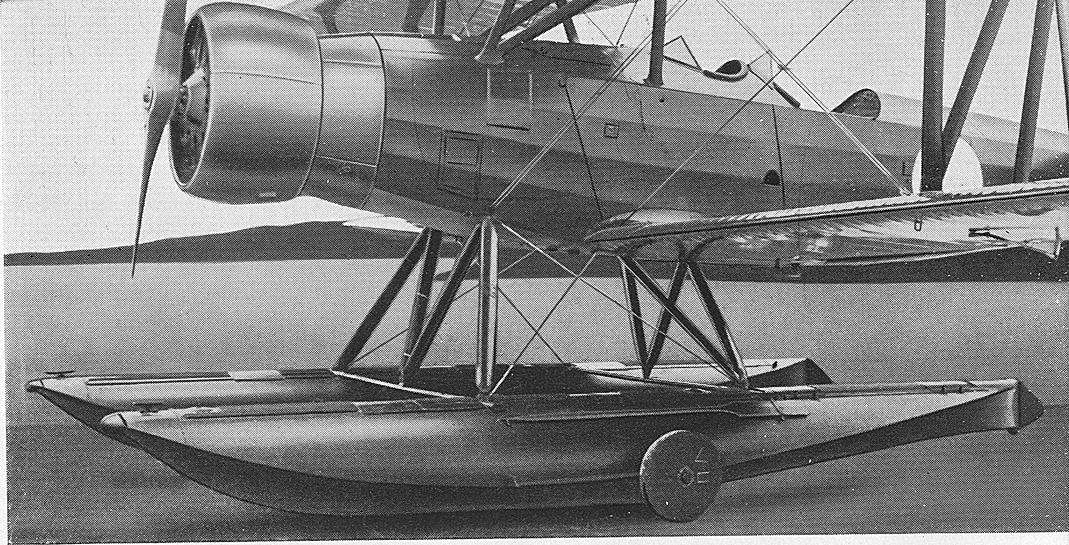
VL Tuisku Floats - from a 1938 Valtion Lentokonetehdas Brochure
Another area that VL specialised in was the construction of heating apparatus to assist with starting aircraft engines in the conditions of extreme cold experienced during a Finnish winter.
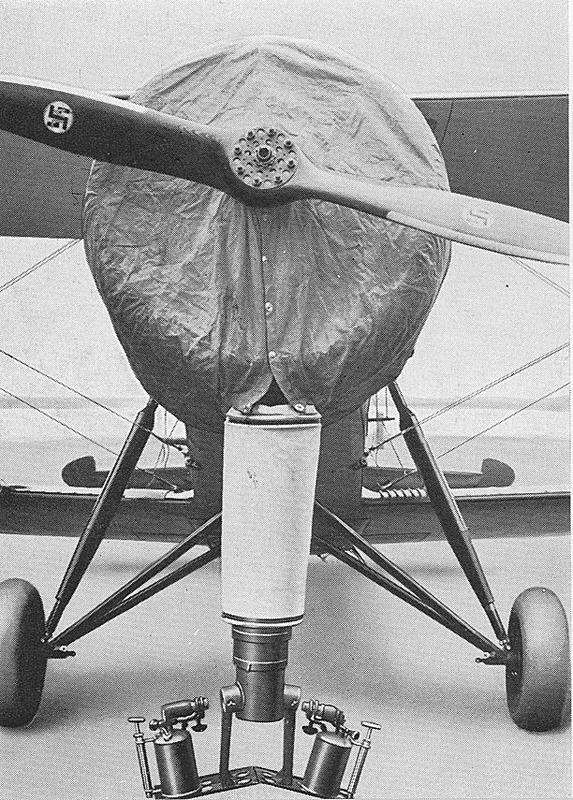
VL Engine Heater - from a 1938 Valtion Lentokonetehdas Brochure. Note the VL Logo emblazoned on the airscrew – this marker was found in all IVL and VL designed and built airscrews.
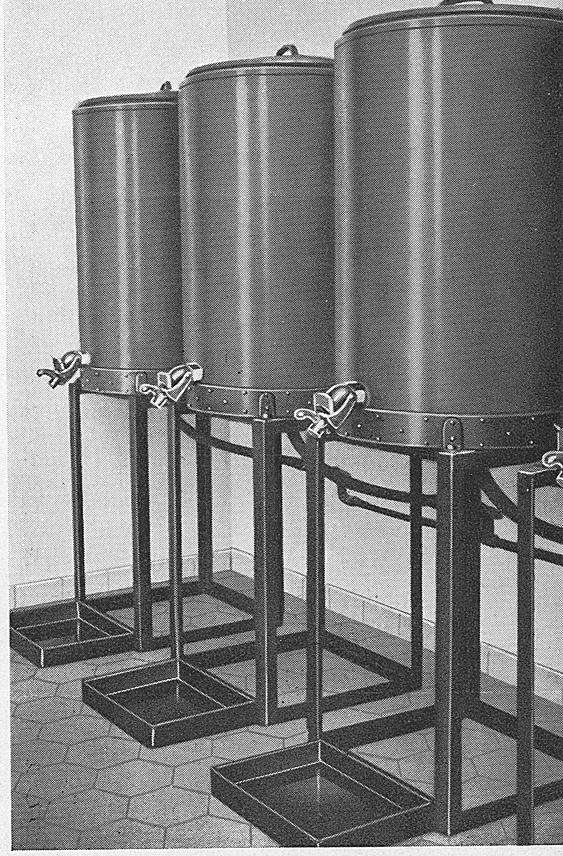
Oil Heating and Filtering Apparatus: Engine lubricating oil was filtered and heated with this apparatus. In winter-time, when Oil must be heated before being used, the heating is carried out rapidly through the use of steam. Each tank holds about 50 Litres of Oil.
The Valtion Lentokonetehdas factory manufactured a large variety of aircraft parts and accessories used in different aircraft. In its modern casting-shop, all aluminium and bronze castings for aircraft were made. A well-equipped surfacte-treatment shop plated the steel parts with cadmium, wrought alloys were anodized and magnesium parts were pickled. In the Heat Treatment Shop, all necessary heat treating processes could be carried out, while the Fine Mechanical Shop both built and repaired aircraft instruments.
The factory also had a well equipped Testing Laboratory in which all materials used in aircraft construction as well as different structures and maufacturing methods were tested. In relation to the construction of the prototypes of the VL designed and bult Tuisku, Viima and Pury aircraft, all dynamic and static loading tests with all the principal parts to be used were carried out in this Testing Lab.The reasearch work carried out in the Labortapry concentrated in tests made with Finnish pine, birch and pine plywood, different glues, compressed wood for airscrew construction and different fatirge tests for various wooden and metal materials. Tests made with Finnish pine showed that this material was eminently suitable for aircraft construction and could be used instead of spruce (something that was to prove critical to Finland’s ability to construct high performance fighters, bombers and ground-attack aircraft in the period leading up to WW2).
Investigations made with aircraft plywood and compressed wood were very important for the develoment of corresponding industries in Finland. Fatigue investigations – of which fatigue tests of various welded steel tubes, Finnish pine and birch plywood were the most important – were made with Schenck’s testing machine for rotating test pieces and with a DVL testing machine for bending test pieces. Significant research work was also conducted on the stresses on different parts of aircraft skis, with measurements being made in flight, on landing and on takeoff using a DVL-Ritz tensometer.
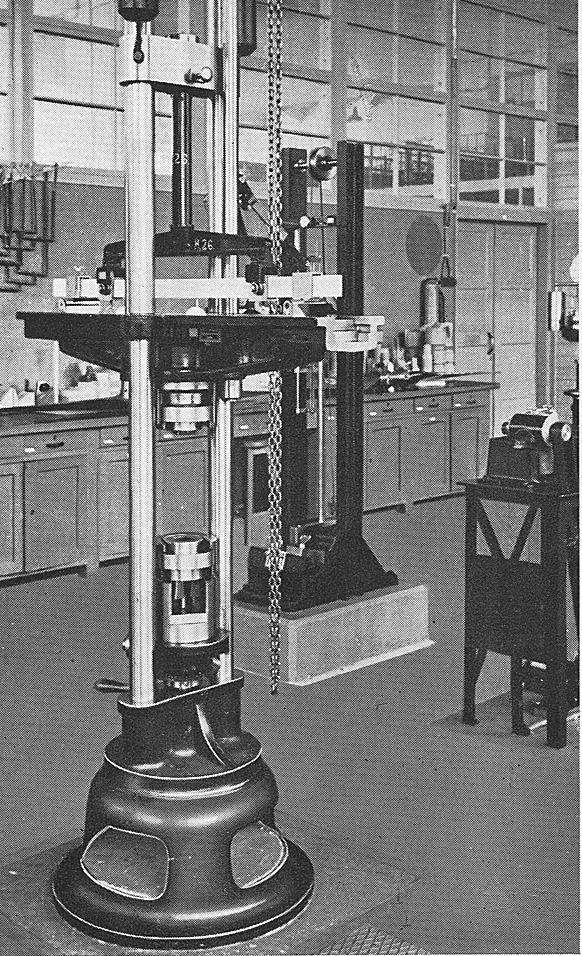
Valtion Lentokonetehdas Testing Laboratory: In the foreground, Amsler’s 20-ton test machine.
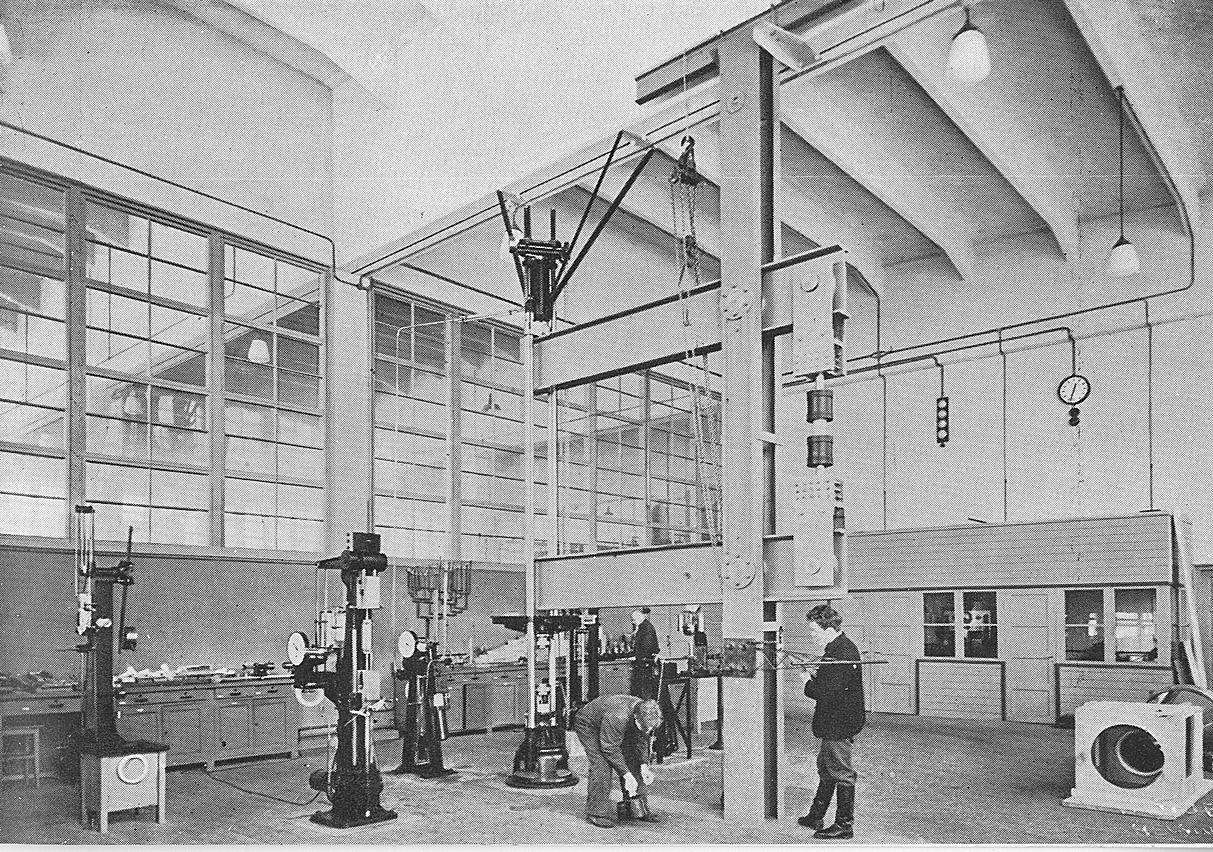
Valtion Lentokonetehdas Testing Laboratory: a wide view of the Testing Laboratory showing in the foreground a big 100-ton test machine.
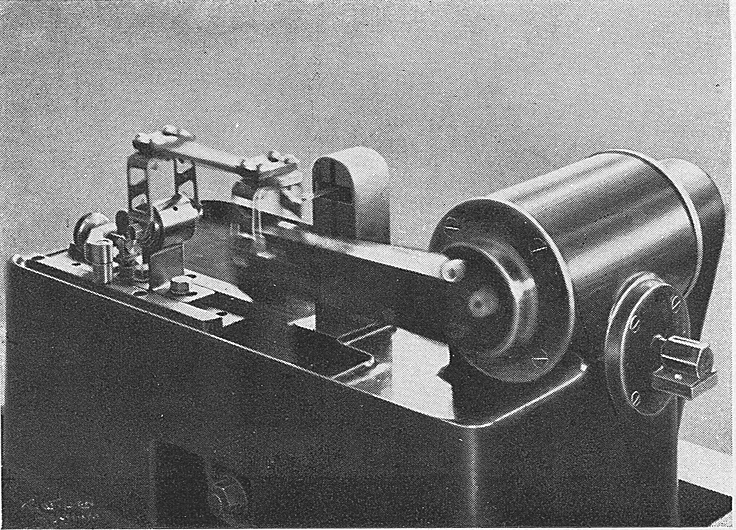
Valtion Lentokonetehdas Testing Laboratory: DVL testing machine for bending test pieces
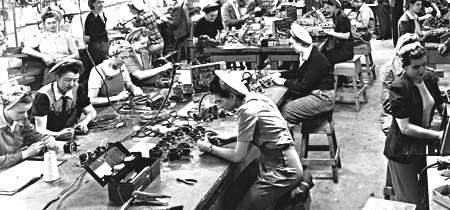
After moving to Tampere, the Valtion Lentokonetehdas factory employed more and more women. Here, women workers are soldering parts: sometime in 1939
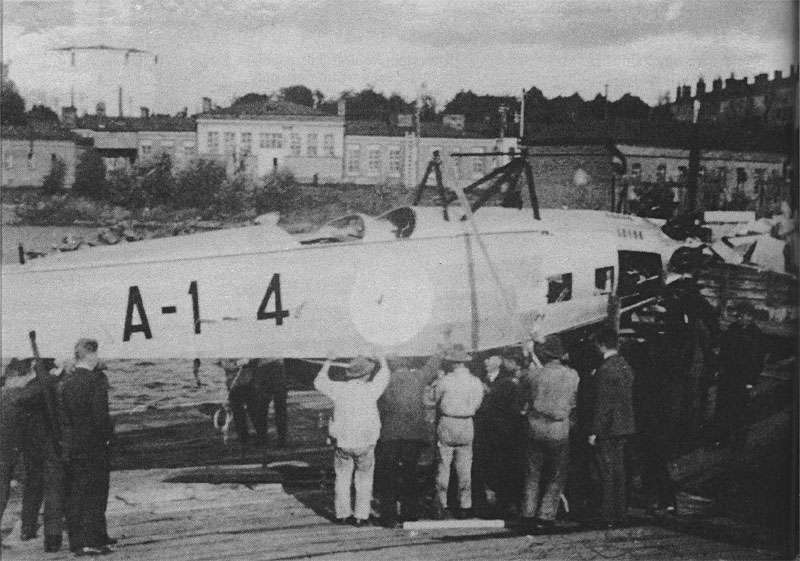
The move from the old premises at Suomenlinna did lead to major improvements – here, a VL Kotka II (Eagle) is being assembled outdoors at Suomenlinna (the old buildings made indoor assembly almost impossible, and most aircraft had their final assembly carried out in the open. By contrast, the new Tampere factory allowed aircraft to be assembled indoors, but even with the new premises, there were problems….
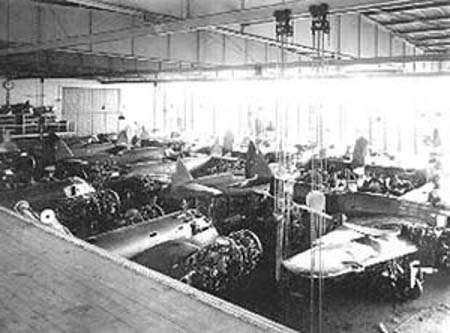
Even with the new Valtion Lentokonetehdas factory, with the surge of orders in the late 1930s, the factory premises soon became crowded: Here, VL-Blenheims being manufactured under license.
Next: The Ramifications of the 1931 Military Review for the Ilmavoimat and the Ilmavoimats purchase program through the 1930’s and up to the Munich Crisis of late 1938
A little more on Valtion Lentokonetehdas through the 1930’s
As we have seen, Valtion Lentokonetehdas was established outside Tampere over 1935-1936, with the State Aircraft Factory being established nearby over the same period and producing Bristol Mercury and Rolls Royce Merlin engines in small numbers. The second aircraft-engine facility set up in Finland was the Tampella-Hispano-Suiza Aircraft Engine Company, established in 1936 to manufacture the Hispano-Suiza 12Y Aircraft Engine and with the plant beginning production in 1937. We have also covered the establishment of the Hispano-Suiza cannon factory in the late thirties (as we will see in a later post, this factory was one of a number involved in the production of weapons and munitions in the Tampere area). In addition, Veljekset Karhumäki (the "Karhumäki Brothers"), with their location at Härmälä Airport were also involved in small scale aircraft construction and, after the signing of contracts and receiving of grants for the construction of facilities from the government, involved in the assembly of imported aircraft and the maintenance and repair of all Ilmavoimat aircraft.
All of this expansion meant that the aircraft industry and its offshoots were a major employer in the area, with the new industrial area of Halli largely created by these factories. The location of these around the area of Härmälä Airport also resulted in the Ilmavoimat Flight Depot and Test Flight Section to the region, as well as the establishment of an Ilmavoimat base at the airfield. Test flying was important in peace time, because flight training caused a lot of damage to the aircraft and that in turn meant repair work for the industry. Information about new Ilmavoimat planes was also gathered through test flights, as while there were manuals available, they often did n ot reflect the true capabilities and limitations of the aircraft. And with Veljekset Karhumäki already operating civilian flight training and building small aircraft for private use, Härmälä Airport was busy from the start. In the Spring of 1937, Marshal Mannerheim had made a surprise visit to the Veljekset Karhumäki airplane workshop in Keljo. Later that same year, the engineers Koskiala and Kuusinen suggested that the company should expand and relocate from Keljo to a more suitable site. In late 1937, after the signing of the contract for aircraft assembly and maintenance and the recieving of the government grant for construction of larger and improved facilities, the Veljekset Karhumäki airplane workshop in Keljo was relocated to Kuorevesi and became increasingly busy, employing some 750 workers by mid-1938.
Over the period we are looking at in this post, from 1931 to late 1938, Valtion Lentokonetehdas went on to build a number of aircraft under license as well as continuing work by its own aircraft design department as well. Several Finnish designed aircraft types were produced by the factory between 1930 and the end of WW2, although in this post we will only cover the period to late 1938. Several designs for aircraft were developed, with prototypes flying and in the 1930s, generally achieving comparable performance with foreign types. While the primary aircraft types were usually bought abroad, since buying these was often cheaper than building an entire new aircraft in Finland, Valtion Lentokonetehdas did build some of its own designed for the Ilmavoimat. And course there was fairly large scale (for Finland) construction of aircraft such as the license built Fokker D.XXIs and Blenheims. The Fokker D.XXI however was so thoroughly redesigned in Finland, that the locally built Fokkers ended up being more Finnish-designed than Dutch. From late 1937, a clear division of responsibilities with Veljekset Karhumäki had been established and each Company had a clear set of priorities. This carried through into the Winter War itself, with Walden as both Defence Minister and Chairman of the Board of VL immediately resolving any disagreements to his own satisfaction, if not to the satisfaction of the Managers of the respective enterprises.
And with the establishment of the new Valtion Lentokonetehdas factory at Tampere, the capabilities of the company rapidly improved. This was achieved under the direction of the Board of Directors (Rudolp Walden-Chairman, Prof. Martti Levon-Vice Chairman, K. Heimonen, Akseli Linnavuori, Eljas Erkko and J. E. Pilppula) and the Management Team (Erkki Mäkinen-Managing Director, Arvo Ylinen-Technical Manager, Arvi Airola-Works Manager, V. Kivenheimo-Secretary). Considerable progress was made with the development of aero accessories and the production of factory-design streamline aircraft-skis, bakelite glued plywood floats and compressed Birch airscrews.

VL Design Shop – new Tampere Factory

VL WorkShop – new Tampere Factory
From 1933 on, the airscrews produced by Valtion Lentokonetehdas were manufactured according to a Factory-patented method using a birch plywood specially designed and improved for this purpose. By utilising this method it proved possible to make airscrews of exclusively domestic birch-wood. The properties of these airscrews – steadfastness of shape without any special protective covering, a narrow and aero-dynamically advantageous form, the possibility of fastening the blades to a metal hub – are to a great extent comparable to metal aircsrews but are much lighter in weight and cheaper than the metal alternative. Resistance to fracture or splitting is very great compared to that of natural airscrew woods. In addition, the resistance to projectiles is much better than in metal airscrews – bullets leave only small holes in the airscrew. Another important advantage of these airscrews is the great rigidity of the blades, which is especially useful with regard to vibration and tip flutter. Furthermore, “fatigue” which is a characteristic of metal airscrews which is controlled with difficulty – is practically unknown in these compressed-wood airscrews.

VL Airscrews –produced by the new Tampere Factory

VL Airscrew Manufacturing in the new Tampere Factory
Valtion Lentokonetehdas also excelled in the design of snow, ice and extreme-col related accessories and equipment for aircraft as well as in floats for seaplanes. This was largely dictated by the extreme weather conditions aircraft in Finland operated in as well as the conditions in summer, which provided an ideal environment for the operation of floatplanes. While useful for Finland, these were unfortunately not conditions which applied through much of the rest of the world, meaning that while VL excelled in these products, there was no potentially large export market to be tapped into. By the 1930’s, VL had lengthy experience in the construction of aircraft skis. These were made in eight different sizes for aircraft varying in wight from 600kg to 3700kg. VL developed streamlined skiis for different types of modern aircraft, the the aerodynamically most advantageous skis built with a bottom-layer of Finnish pine covered with steel sheets. The supports were made of welded steel sheet construction and were supplied with brakes which locked the skis, preventing movement when flying (and especially when diving). The shaping was made of aluminium sheets and allowed the skis to flex under landing loads.


VL Skis from a 1938 Valtion Lentokonetehdas Brochure
Valtion Lentokonetehdas built aircraft floats from Finnish pine covered with baelite-glued plywood and furnished with rudders. The floats were furnished with inspection holes which could be easily opened for ventilation. The colume of the float for the VL-designed and built Tuisku was about 1.5 cubic meters and it weighted 95.5kg.

VL Tuisku Floats - from a 1938 Valtion Lentokonetehdas Brochure
Another area that VL specialised in was the construction of heating apparatus to assist with starting aircraft engines in the conditions of extreme cold experienced during a Finnish winter.

VL Engine Heater - from a 1938 Valtion Lentokonetehdas Brochure. Note the VL Logo emblazoned on the airscrew – this marker was found in all IVL and VL designed and built airscrews.

Oil Heating and Filtering Apparatus: Engine lubricating oil was filtered and heated with this apparatus. In winter-time, when Oil must be heated before being used, the heating is carried out rapidly through the use of steam. Each tank holds about 50 Litres of Oil.
The Valtion Lentokonetehdas factory manufactured a large variety of aircraft parts and accessories used in different aircraft. In its modern casting-shop, all aluminium and bronze castings for aircraft were made. A well-equipped surfacte-treatment shop plated the steel parts with cadmium, wrought alloys were anodized and magnesium parts were pickled. In the Heat Treatment Shop, all necessary heat treating processes could be carried out, while the Fine Mechanical Shop both built and repaired aircraft instruments.
The factory also had a well equipped Testing Laboratory in which all materials used in aircraft construction as well as different structures and maufacturing methods were tested. In relation to the construction of the prototypes of the VL designed and bult Tuisku, Viima and Pury aircraft, all dynamic and static loading tests with all the principal parts to be used were carried out in this Testing Lab.The reasearch work carried out in the Labortapry concentrated in tests made with Finnish pine, birch and pine plywood, different glues, compressed wood for airscrew construction and different fatirge tests for various wooden and metal materials. Tests made with Finnish pine showed that this material was eminently suitable for aircraft construction and could be used instead of spruce (something that was to prove critical to Finland’s ability to construct high performance fighters, bombers and ground-attack aircraft in the period leading up to WW2).
Investigations made with aircraft plywood and compressed wood were very important for the develoment of corresponding industries in Finland. Fatigue investigations – of which fatigue tests of various welded steel tubes, Finnish pine and birch plywood were the most important – were made with Schenck’s testing machine for rotating test pieces and with a DVL testing machine for bending test pieces. Significant research work was also conducted on the stresses on different parts of aircraft skis, with measurements being made in flight, on landing and on takeoff using a DVL-Ritz tensometer.

Valtion Lentokonetehdas Testing Laboratory: In the foreground, Amsler’s 20-ton test machine.

Valtion Lentokonetehdas Testing Laboratory: a wide view of the Testing Laboratory showing in the foreground a big 100-ton test machine.

Valtion Lentokonetehdas Testing Laboratory: DVL testing machine for bending test pieces

After moving to Tampere, the Valtion Lentokonetehdas factory employed more and more women. Here, women workers are soldering parts: sometime in 1939

The move from the old premises at Suomenlinna did lead to major improvements – here, a VL Kotka II (Eagle) is being assembled outdoors at Suomenlinna (the old buildings made indoor assembly almost impossible, and most aircraft had their final assembly carried out in the open. By contrast, the new Tampere factory allowed aircraft to be assembled indoors, but even with the new premises, there were problems….

Even with the new Valtion Lentokonetehdas factory, with the surge of orders in the late 1930s, the factory premises soon became crowded: Here, VL-Blenheims being manufactured under license.
Next: The Ramifications of the 1931 Military Review for the Ilmavoimat and the Ilmavoimats purchase program through the 1930’s and up to the Munich Crisis of late 1938
Last edited:
The Ramifications of the 1931 Military Review for the Ilmavoimat
The Ramifications of the 1931 Military Review for the Ilmavoimat
The outcome of the 1931 Military Review for the Ilmavoimat was both extremely positive in terms of increased budgeting, and supportive of Somersalo’s views as to the future path the Ilmavoimat should take. Immediate measures that the Ilmavoimat took in 1931 were to order additional aircraft of types already in service while working to plan an immediate acquisition program for the 1932 financial year. That aside, the major planned emphasis was put a detailed five year plan for the continued strengthening of the Ilmavoimat together with the necessary steps towards putting in place the needed unit organisation together with the physical infrastructure. Now given a free rein, promoted and while answerable to the military command, with unfettered access to Mannerheim (which he rarely used), Somersalo was also able to move ahead with the development of the Ilmavoimat’s strategic and tactical doctrine development as he saw necessary and in this he had the assistance of some highly capable subordinates (more on these and the development of the Ilmavoimat’s strategic and tactical doctrine in a subsequent post).
We have already reviewed the Ilmavoimat and Valtion Lentokonetehdas’s purchasing and construction program through the 1920’s in detail. Moving ahead, we will now review the Ilmavoimat’s purchase program on a year by year basis through to the Munich Crisis of late 1938, where we will pause and look at other aspects of Finland’s military defence and foreign policy.
As of the end of 1930, immediately prior to the 1931 Military Review, the Ilmavoimat consisted of the following aircraft:
Primary Trainers
64 Caudron C.60s, purchased 1923 (Retired in 1936)
6 Morane-Saulnier MS50.C, in-service 1925 (Retired in 1939)
33 VL Sääski I, II and IIA, in-service 1928 (Retired in 1945)
18 De Havilland DH60 Moth, in-service 1929 (Retired in 1944)
75 Letov S.218.A Smolik, in-service 1930 (Retired in 1945)
Fighters
19 Gourdou-Leseurre GL-22, in-service 1923 (Retired in 1931)
15 Martinsyde F4 Buzzard, in-service 1923 (Retired in 1939)
12 Koolhoven F.K.31, in-service 1926 (Retired in 1931)
40 Haukka II, in-service 1927 (Retired in 1944)
Ground Attack / Army Liason
6 Junkers J1, in-service 1919 (Retired in 1932)
1 Fokker CV, in-service 1927 (Retired in 1945)
8 Aero A-11, in-service 1927 (Retired in 1939)
16 Aero A-32, in-service 1929 (Retired in 1944)
Transport
10 Junkers W.34, in-service 1930 (Retired in 1944)
Maritime Patrol
120 VL A.22 Hansa, in-service 1922 (Retired in 1936)
40 Blackburn Ripon IIF, in-service 1929 (Retired in 1944)
As we can see, with some 196 training aircraft, 86 Fighters, 31 Army Liasion/Light Bombers, 10 Transports and 147 odd maritime aircraft, the Ilmavoimat of 1930 was a reasonable size, albeit with a large number of aircraft that were, by 1930, outdated. It was from this foundation that the Commanding Officer of the Ilamvoimat, Aarne Somersalo, would go on through the decade of the 1930’s to build what was the most combat capable and effective airforce of the Second World War with an unrivalled kill ratio.
In 1931, orders for the following aircraft had been placed and these were in the process of being constructed:
Blackburn Ripon - 1st ordered 1927 (40 delivered between 1929 and 1933)
We’ve looked at the Blackburn Ripon in an earlier post – at this stage, suffice it to say that the Ilmavoimat had ordered one Blackburn Ripon in 1929, at the same time acquiring an unlimited license for production. The Ilmavoimat then ordered a first production series of 15 Ripon IIFs (type R.29) from VL. Series I, consisting of 7 aircraft, was delivered to Merilentoasema between 17 Dec, 1930 and 20 Oct, 1931 (these were powered by the 480 hp Gnome Rhone Jupiter VI engine - this engine resulted in the plane being under-powered for float operations and beginning in 1933, attempts were made to find a more aoppropriate engine). Series II, consisting of 8 aircraft, was delivered between 20 Oct, 1931 and 18 Feb, 1932 (these were powered by the 535 hp Armstrong Siddeley Panther engines). VL had been busy manufacturing Haukka II Fighters from October 1928 to April 1930.
Manufacturing of the license-built Ripon’s commenced immediately after the Haukka’s had been completed and kept VL working at capacity through 1930 and 1931. Following the defense review of 1931, a third series of 25 Ripons was ordered in late 1931. These were delivered between 11 June, 1932 and 26 Oct, 1933 and were powered by the 580 hp Bristol Pegasus engines – an alternatiove sources says the 620hp Bristol Pegasus II engine), equipping the Ilmavoimat with two full squadrons (40 Ripons in all) which were all in service by early 1934. In total, 40 Ripons were produced under License. However, construction of the aircraft by VL was beset by several problems and there were cost increases and delays in the delivery of the aircraft. The original manufacturer was not able to supply the detailed plans within the agreed timefeame and VL’s factory did not have the necessary tools to build all the components. In the end some parts had to be ordered from England, which caused further delays.
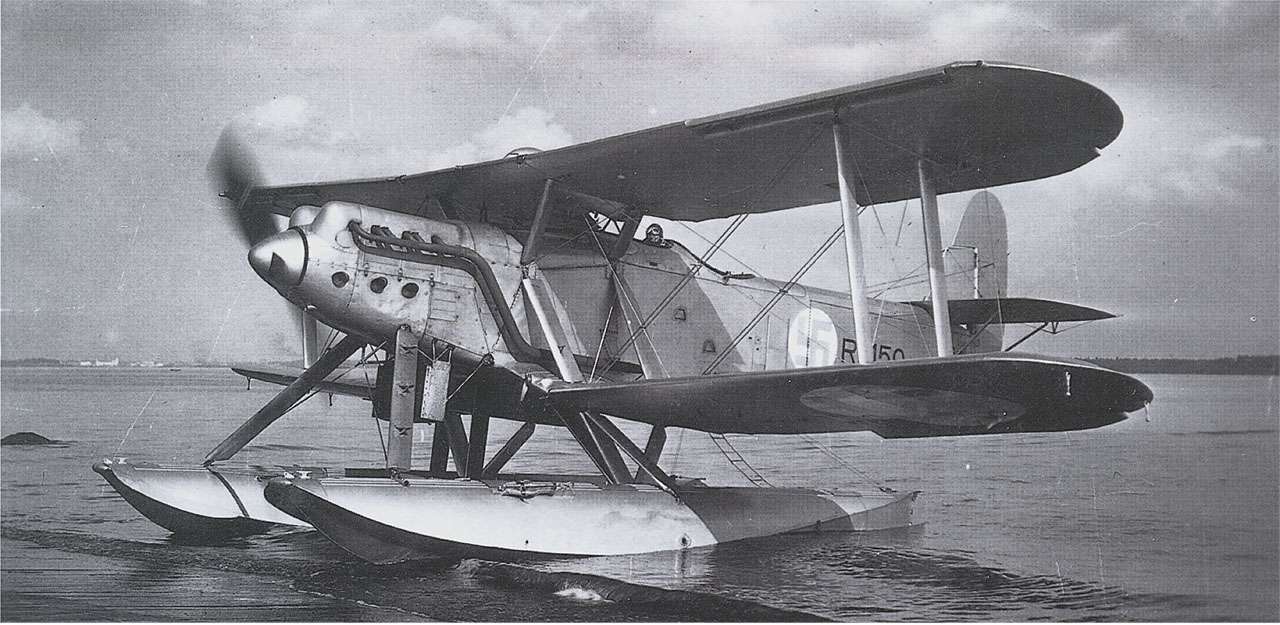
Quite a nice looking Finnish-built Blackburn Ripon with the Hispano Suiza V-12 photographed at Turkinsaari in the summer of 1937. This engine had 650 hp when the Bristol Pegasus II had 610 hp and the Armstrong Siddley Panther only 525 hp. The Finnish Air Force decided not to upgrade the engines and so this is the only Ripon to have an inline engine. Photo from "Suomen Ilmavoimat 1928-1940" by Keskinen, Partonen and Stenman
Letov S-18 (Smolik) Primary Trainers – 10 ordered 1930, 65 ordered early 1931
Through the 1930’s and the Second World War, the bulk of the Ilmavoimat’s Primary Trainers were the Letov S-18's. This was a Czechoslovak single-engined two seat biplane trainer designed by Alois Smolík at the firm of Letov Kbely which first flew in 1925. In 1929, one Š-218 Smolik had been shown at the Helsinki International Show and was purchased outright in March 1930 An order for nine further aircraft together with the manufacturing license was soon placed with Czechoslovakia and the nine aircraft ordered from arrived at the Kauhava Aviation School over May-June, 1931.
In the meantime, the 1931 Military Review was well underway and with the planned expansion of the Ilmavoimat, it was decided that substantially increased numbers of Primary Trainers were required for Pilot Training. Almost immediately on plans for Air Force expansion having been formulated by mid-1931, an order was placed with the State Aircraft Factory for a further 65 Smolik Primary Trainers to be delivered over the period 1932-1933. An expansion to VL manufacturing capacity and numbers of employees was planned for and funded was provided in the 1931 defense budget to enable this and other future Ilmavoimat orders to be met in the planned timeframe. The aircraft were manufactured by VL and delivered over 1932 to 1934, remaining in use as basic trainers until 1945, proving to be effective in their role as Primary Trainers and having been used as the Primary Trainer for most of the Ilmavoimat Pilots who fought in the Winter War so effectively.
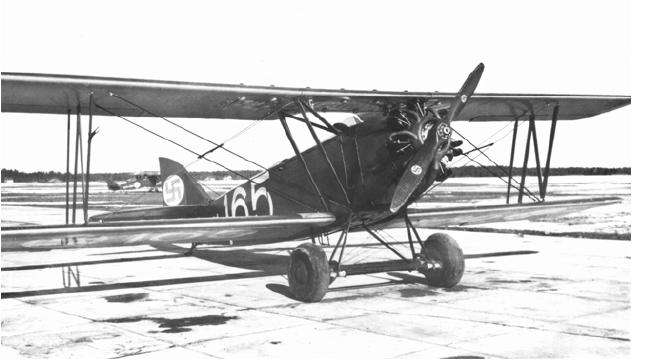
Ilmavoimat Smolik S-218
The construction of 65 of these aircraft over a three year period (1932 – 1933 – 1934), whilst also fulfilling the orders for the Blackburn Ripon together with a small number of other aircraft, was a major strain for the VL factory at Suomenlinna. Thus, with the VL factory heavily committed for the next two years of production, aircraft orders placed in the last quarter of 1931 were focused largely on the ordering of completed aircraft from foreign manufacturers. (Prior to this, a single order for 12 Fokker CV CV twin-seat light reconnaissance and bomber biplane aircraft had been placed on 17 March 19321 with Fokker. The Ilmavoimat had one already in servivce that been purchased in 1927 and this had proven reliable and effective in its role. It could be manufactured and supplied quickly from the Fokker plant in the Netherlands and delivery was indeed quick – all 13 were received in the winter of 1932. (as a footnote, during the Winter War, Sweden donated three more C.V-Es. The aircraft were used as reconnaissance and light bomber aircraft through until 1945. During the Winter War, the Finnish C.Vs flew extensively on reconnaissance and harassment bombing sorties without suffering any losses).
The 1931 Ilmavoimat Purchase Program
For late 1931, the purchase program focused on two different aircraft types. The first order that was placed was for six VL-designed E.30 Kotka (Eagle) maritime patrol aircraft.The existing Hansa floatplanes were both obsolete and worn out and with delays in the Ripon manufacturing program and an interim replacement was desperately needed. The purchasing of a small number of Kotka’s was an interim solution – further orders were not envisaged. The second order placed was for 20 Curtiss F8C-5 Helldiver Divebombers.
Fokker CV
One Fokker C.V-E had been purchased in 1927, with delivery on 20 September of the same year. A further 13 were purchased on 17 March 1931, arriving in the winter of 1932.
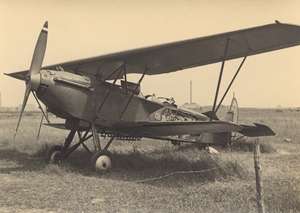

Ilmavoimat Fokker CV - The Fokker C.V (or C.5) was the most successful export product of the Fokker factories after WWI. It was sold to Italy, Norway, Denmark, Hungary, Bolivia, China, Finland, Japan, Russia and the US. The C.V was fitted with twin FN 7.9 mm synchronized machineguns and one manually operated Lewis 7.9 mm machinegun in the rear which was operated by the navigator/observer/bomb-aimer. The two-seater plane was also capable of delivering a modest pay-load to the battlefield. For this purpose two racks were installed under the wings, which could carry either 16 shrapnel bombs of 8 kg each, 4 x 25 kg or 4 x 50 kg. With a speed of 155mph and a range of 621 miles, it was able to survive in WW2 combat by staying low and hedge-hopping.
VL Kotka I and II - 6 ordered 1931, retired 1944
The VL E.30 Kotka (Eagle) was a Finnish-designed and built two-seat biplane maritime patrol aircraft, designed by Kurt Berger at the State Aircraft Factory (Valtion Lentokonetehdas - VL). The project started when the Ilmavoimat began to look for a replacement for the now worn out and obsolete Hansa floatplanes that were in service with the Ilmavoimat. The prototype made its first flight on September 30, 1930. Work was terminated, only to be resumed and then continued in haste when the costs of, and delays in, the deliveries of the Blackburn Ripon became apparent. In 1931 Valtion Lentokonetehdas began producing a series of five aircraft. These were used as liaison aircraft until 1944.
The Kotka met the standards for a successful military aircraft at the time the order was placed and was no better or worse than comparable aircraft from other countries – which only shows that the amount of expertise was no better or worse than in other countries. The Ilmavoimat operated the six aircraft from 1931 to 1944. Additional numbers were contemplated but after the Ripon construction project was brought back onto track through the personal involvement of Rudolph Walden in the reorganization of the State Aircraft Factory (Valtion Lentokonetehdas - VL) it was decided that the aircraft was not required in any greater numbers.
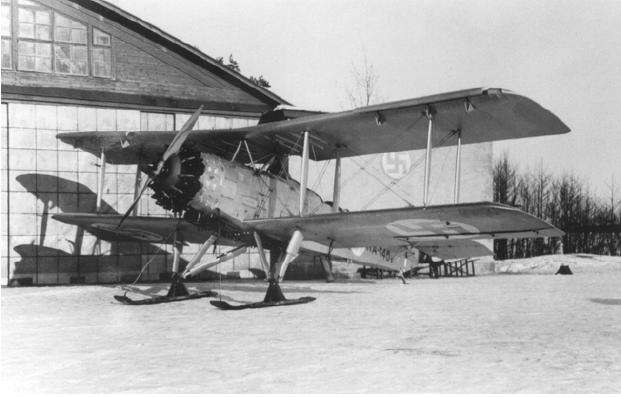
With a crew of 2 (Pilot and Observer), powered by a single Wright R-1820 Cyclone E radial engine, the Kotka had a maximum speed of 140mph and a service ceiling of 9.840 feet
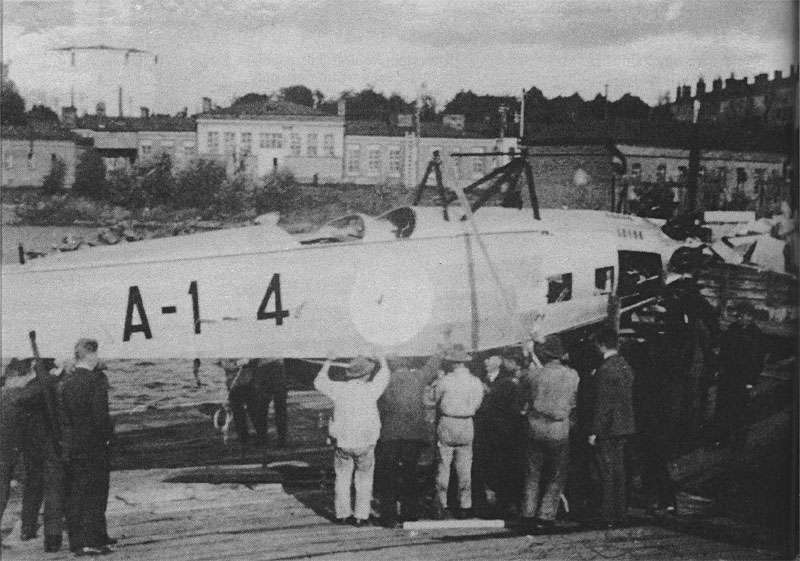
A VL Kotka II (Eagle) being assembled outdoors at Suomenlinna (a 250-year-old fortress outside Finland's capital, Helsinki). VL had begun its production at Suomenlinna and Santahamina in Helsinki and the factory did not have an airport, only the sea and sea ice could be used for take-off and landing. Most of the aircraft built in Helsinki were seaplanes and because of the small size of the factory at Suomenlinna, much of the final assembly was done outdoors.
OTL Note: One aircraft (no. 4, KA-147) is still preserved and on display at the Päijät-Häme Aviation Museum.
Curtiss F8C-5 Hell-Diver Divebomber – 20 ordered in late 1931
The second and final purchase of the last quarter of 1931 was an aircraft near and dear to the heart of the commander of the Ilmavoimat. Somersalo had been a long-time advocate of aircraft in specialised roles. While continually ushing for a strong fighter force for the Ilmavoimat, he in no way neglected other types, and with the increased budget available in the last quarter of 1931 for aircraft purchases, he saw the way open to beginning to modernise and build up the ground-attack component of the Ilmavoimat. From 1919 on, this had been largely the role of the six now antiquated Junkers J1’s which Somersalo had ensured were kept in service to preserve the limited institutional ground-attack aircraft knowledge, experience and tactical doctrine. While the J1’s were by 1931 obsolete, they had at least allowed for the continuation of limited ground-attack training and participation in Army exercises in a ground-attack role. In searching for an immediate replacement, Somersalo settled on the purchase of a number of Curtiss F8C-4 Helldivers from the United States. This type had originated with the US Marine Corps who were, in the late 1920s, developing dive-bombing techniques – a development which Somersalo and others in the Ilmavoimat had followed with interest from the sparse and sporadic reports available. Immediately after having been given the go-ahead for the 1931 last-quarter purchase program, Somersalo together with one test pilot, two crews from the J1 Flight and a Valtion Lentokonetehdas representative embarked on a trip to the United States to evaluate the aircraft. The aircraft proved to be almost everything Somersalo was looking for and the J1 crews were also enthusiastic after a series of comprehensive test flights. The Valtion Lentokonetehdas representative was perhaps less enthusiastic as the Helldiver used a different construction method than those VL had experience working with.
At its conception, Curtiss engineers had decided to make the Helldiver frame from welded steel tubing, which was a sharp departure over previous construction methods. Unlike the frame however, the Helldiver’s wing structure was a conventional of a wood-framework covered in canvas. Powered by a 450hp R-1340-80 Wasp, the XF8C-2 prototype had appeared early in 1929. Although the first prototype crashed in testing, the biplane showed enough promise to warrant further development. A second prototype, the XF8C-4, was flown in August 1929 and by early 1929, the Helldiver was in full production mode. The aircraft that emerged out of the ashes of the prototype was much more advanced. The F8C-4/02C Helldiver was now a pure, dedicated dive bomber aircraft with two fixed, forward firing heavy machine guns housed on the upper wing structure and a special bomb rack that was able to carry up to 500 pounds of ordinance.
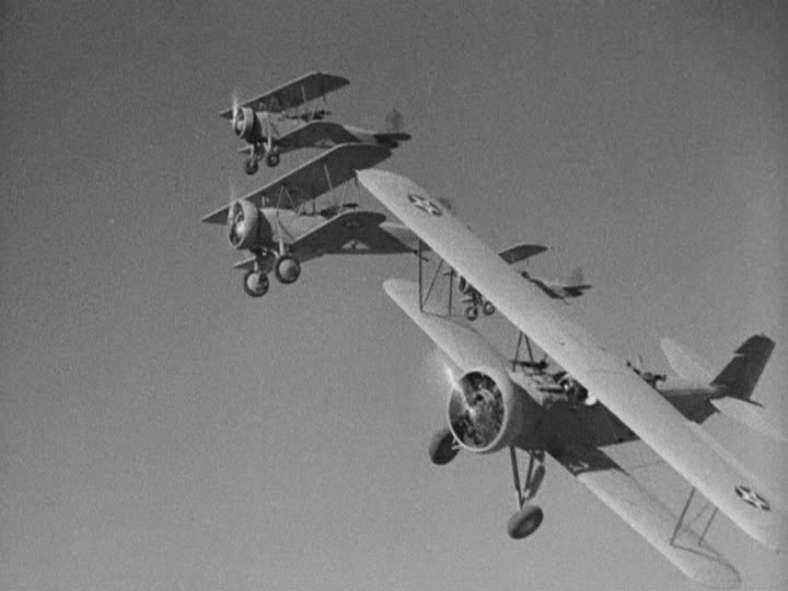
Curtiss F8C Helldiver’s peeling off…….
The rack was designed to deploy the bomb away from the aircraft as it dived in order to avoid the bomb entering the propeller arc. As with many planes of the era, the F8C, although a very robust platform still lacked self-sealing fuel tanks which could have proved to be fatal if the plane were involved in combat. A single bullet could have turned the aircraft into a fiery coffin. Twenty five of the first Helldiver model, the F8C-4, went on to serve aboard the US Navy’s infant aircraft carrier fleet. The US Marine Corps received 63 examples of the modified, land based F8C-5 version. A 3rd type, a pure reconnaissance airplane, was known as the 02C-1. Thirty examples of this version were also ordered by the Navy. Although the aircraft did not see full fledged combat operations with the US Navy or Marine Corps, it had its moment in the sun. The plane, a favorite of the Navy’s nascent public relation office, was immortalized as the aircraft that shot down King Kong as he sat on top of the Empire State Building during the famous 1930s film.
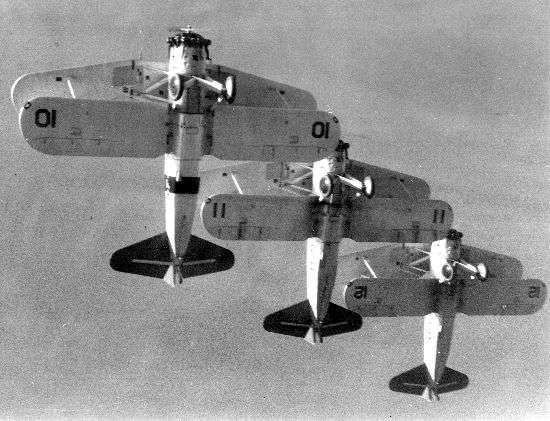
Ilmavoimat F8C-5 Helldivers after delivery but before being repainted in Ilmavoimat colours or insignia: With a top speed of 160mph, a range of 720 miles, a service ceiling of 16,250 feet and armed with two forward-firing machineguns and 500lbs of bombs, this was an effective dive-bomber of the early 1930’s. Performance-wise, the F8C Helldiver was as fast as any Fighter aircraft in service at the time it was purchased.

A three-view drawing of the Curtiss F8C-4 Helldiver
Based on the success of the test flights, Somersalo signed an order with Curtiss on behalf of the Ilmavoimat for 20 F8C-5 Helldivers in late 1931. These were delivered to Finland in one shipment, arriving in June 1932 and entering service shortly thereafter. A two-seater, the Helldiver typically carried a Pilot in the front seat and an Observer in the rear. The Ilmavoimat version was fitted with then new 712 hp (531 kW) Wright Cyclone SR-1820 Cyclone 9 radial piston engine (giving a substantial improvement in performance over earlier models) and an additional ring-mounted machinegun for the Observer / Radio Operator. A small team from Curtiss accompanied the shipment, assisted with assembly and undertook a training program for Valtion Lentokonetehdas technical personnel and for the Ilmavoimat ground crew responsible for maintaining the aircraft. While on his trip to the USA and immediately after signing the order, Somersalo had arranged (with the prior concurrence of Finlands Ministry of Defence) for four US Marine Corps personnel (2 Pilots and 2 Observers) to spend some months with the Ilmavoimat Squadron flying the Helldivers, familiarising Ilmavoimat personnel with the aircraft and training them in the dive-bombing techniques that had been developed by the US Navy and Marine Corps. It was a valuable learning experience and a capability that the Ilmavoimat would go on to build on independantly.
Once familiar with the aircraft and the techniques of dive bombing, the Helldiver Squadron went on to develop standard dive bombing procedures over 1933. Having developed a standard dive bombing procedure, the Helldiver Squadron commenced regular Army cooperation exercises from 1934 on. From 1935 on, the Squadron also exercised regularly with the Experimental Combined Arms Battle Group, where the skills and lessons learned were incorporated into the military tactical battle fighting doctrine that was in the process of being developed and implemented in a continuous feedback loop. It was as a result of the lessons learned from these ongoing exercises that the Ilmavoimat purchased additional and more modern dive bombers in the period preceding the Winter War. These would serve Finland well in battle, but it was the purchase of the Helldivers that laid the foundations for future success.
The 1932 Ilmavoimat Purchase Program
In late 1931, the Ilmavoimat and Valtion Lentokonetehdas put in place a joint Procurement Organisation structured to continually tracking and evaluating aircraft from manufacturers in Britain, France, Italy, Germany, Czechoslovakia, Poland and the United States. Where an aircraft was of interest and available for test flights, a small evaluation team was sent to the manufacturer to carry out a preliminary evaluation program. At the same time, a separate unit within the General Staff (with Ilmavoimat and Valtion Lentokonetehdas members as well as Maavoimat, Merivoimat and technical / civilian members) was setup to track weapons development programs in the primary threat – the USSR. Attention was also paid to doctrinal development and, wherever possible, Finnish military representatives attended Soviet military exercises as observers. In addition, close ties were maintained with the German military and important information on the Soviet Union was obtained unofficially (and at times officially) through this channel.
In 1932, the Ilmavoimat commenced upgrading its Fighter Aircraft. While longer term plans were still being made, it was decided that at least two Squadrons of the most modern fighters should be purchased as a start and to enable the Fighter Pilot training program to move ahead. To this end, the Ilmavoimat decided on the purchase of forty Bristol Bulldog’s from the UK.
Bristol Bulldog Biplane Fighter – ordered 1932
The Bristol Bulldog was a British Royal Air Force (RAF) single-seat biplane fighter designed during the late 1920s by the Bristol Aeroplane Company. The Ilmavoimat purchased forty Bristol Bulldog Mk IVAs from Britain, ordering these on 24 March 1932 and taking delivery in February 1933. This was a relatively expensive purchase but by purchasing the aircraft outright rather than building under license, rapid delivery was assured.
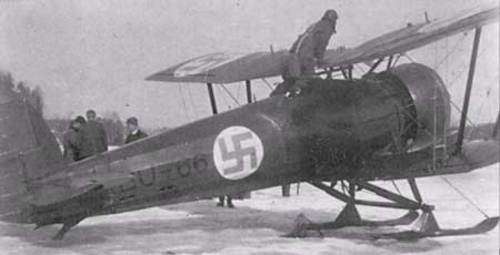
Ilmavoimat Bristol Bulldog – Winter War
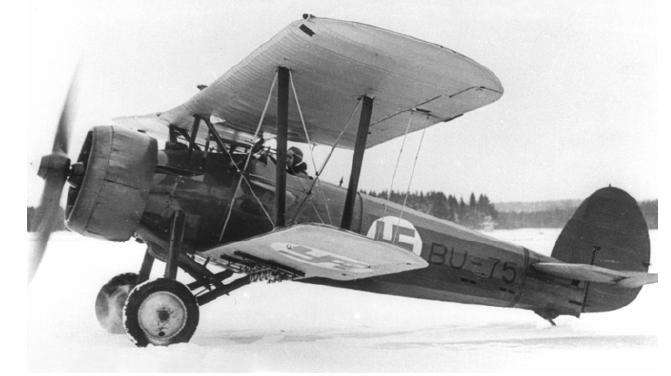
The Bulldog was the first aircraft to exceed 300 km/h in level flight in Finland. Sweden donated two Bulldog IIAs to Finland during the Winter War. These aircraft had negligible effect on the war effort due to damage they sustained in service.
In September 1926, the British Air Ministry had stated a need for a single-seat fighter capable of operating in day and night-time conditions; to be armed with two 0.303 in (7.7 mm) Vickers machine guns and to be powered by a radial air-cooled engine. This requirement was laid down in Specification F9/26. The Bulldog was designed by Frank Barnwell, the Chief Designer of the Bristol company, (who had served as a Captain in the British Army during the First World War), as a private venture to meet the requirements of this specification. The Bristol Bulldog was a mixed structure bi-plane fighter with a fixed landing gear. It had a high tensile steel strip construction with fabric skinning. By comparison with the standard Mk. IIA, the Mk. IVA had deeper, biconvex wing sections, permitting the fuel tanks to be accommodated completely within the wing profile; reduced lower wing chord to improve the pilot's view; single (in place of double) lift wires; a deeper rear fuselage of increased stiffness and a long-chord cowling for the engine.
The prototype Bulldog, the Bulldog Mk. I first flew on 17 May 1927. After initial consideration of all the types entered to meet the specification, the Bulldog and the Hawker Hawfinch were selected by the British Air Ministry for more detailed evaluation. While the Bulldog's manoeuvrability and strength were praised by the RAF, it initially had poor spinning recovery properties and was therefore fitted with a lengthened rear fuselage. In this form, it was declared the winner of the competition, having slightly superior speed and being easier to maintain, requiring fewer changes to produce an operational aircraft than the Hawfinch. The full-production Bulldog came in the form of the Mk.II, which had a modified structure but in every other respect was identical to the original Bulldog; having two 0.303 in (7.7 mm) Vickers machine guns; a capacity for four 20 lb (9 kg) bombs; a 450 hp (336 kW) Bristol Jupiter radial engine; giving the Bulldog a maximum speed of just under 180 mph (290 km/h) and a range of 300 miles (480 km).
The aircraft entered production in 1928, entering service the following year, and becoming, during the early 1930s, the most widely used aircraft in the RAF over the inter-war period with over four hundred Bulldogs produced. It was cheap to maintain and thus, at a time of defence budget constraints, was the more preferable option to any other of the more expensive competitors. The Mk. IIA was again virtually similar to its predecessor, though it had a new Jupiter engine and a strengthened structure. The Bulldog proved to be quite a successful export to foreign air forces, seeing service with Australia, Denmark, Estonia, Finland, Japan, Latvia, Siam, Spain and Sweden. The Bulldog was withdrawn from RAF service in 1937, being replaced by the Hawker Hurricane and Supermarine Spitfire, both of which would become legends of the RAF for their contributions during the Second World War. The Bristol Bulldog's career was not over though, for the type continued to serve with other air forces. The Bulldog never saw combat service with the RAF. A number of Bulldogs, ex-Latvian aircraft, saw service during the Spanish Civil War, as part of the forces fighting the Nationalists.
Ilmavoimat Bulldogs however saw combat in two wars. In 1937, twenty Bulldogs were sold as “surplus” to a German arms dealer, and “somehow” found their way to Spain, where by a strange coincidence they were the first aircraft flown by the Finnish Volunteer Squadron attached to the Finnish Volunteer Division (“Pohjan Pojat” – the Boys from the North) fighting with Franco’s Nationalist Forces in the Spanish Civil War. Considerable experience was gained, with the Finnish Pilots achieving rermarkable successes in their Bulldogs against their “Republican” opponents. This experience will be discussed in detail in a later post covering all aspects of the now little-known and virtually forgotten Finnish Volunteer involvement in the Spanish Civil War.
Ilmavoimat Bulldogs continued to serve during the Winter War against the Soviet Union, which began in 1939. As in Spain, the Bulldogs fought well against their Soviet opponent, gaining six kills by five pilots for the loss of one of their own, the types shot down being two Polikarpov I-16s and four Tupolev SB-2s, both of which were quite superior in terms of technology compared to the Bulldog. In fact, OTL, the very first aerial victory of the Finnish Air Force was achieved by a Bulldog piloted by SSgt Toivo Uuttu on 1 December 1939. OTL, the Bulldog continued in service during the subsequent Continuation War against the Soviet Union, though without scoring any further kills or suffering losses. ATL, the Bulldog was generally relegated to use as an Advanced Fighter Trainer and, while it saw limited action in early stages of the Winter War, was relegated to training use from early 1940.
1933 Ilmavoimat Organisational Changes
By 1933, the Ilmavoimat’s five-year plan had been drawn up and approved. In essence, this consisted of a steady acquisiton program for a combination of Fighters, Ground-attack aircraft and bombers, maritime patrol, transport and trainers. In addition, the ongoing role of dive-bombers was seen as being applicable to supporting both the Maavoimat and Merivoimat. The intent was to ensure the continual phasing in of late-model aircraft on an ongoing basis. That this would in all likeliehood result in a disparate range of aircraft in service at any one time was recognised. Conversely, this would also reduce the chances of entering a war with a large number of aircraft that were obsolete and not capable of putting up an effective fight. Some aircraft would be obsolete or outclassed, but at least some would not. With this in mind, actual purchases were decided on a year-by-year basis dependent on what was available and the conclusions of the evaluation and test teams.
At the same time, it was also recognised that the ongoing expansion of the Ilmavoimat would demand more personnel and infrastructure. Up until 1932, the Ilmavoimat had generally been made up largely of permanent personnel with small numbers of reservists. From 1933 on, the Ilmavoimat would be gradually re-shaped, with the organisation being structured around a core of permanent personnel forming a small number of squadrons together with permanent training cadre, conscript-volunteers and Active Reserves. A precondition of conscripts being accepted as volunteers for the Ilmavoimat would be a commitment to 18 months of conscript service rather than the Maavoimat’s 12 months, joining the Ilmavoimat Active Reserve for a ten-year period and maintaining annual training status. With the growth that was projected for the Ilmavoimat between 1933 and 1938, over time it was foreseen that the bulk of the Ilmavoimat squadrons would be manned by Active Reserve units, with an increasingly active weekend training schedule needed to keep training and skills current.
Additionally, and far more radically, the Ilmavoimat from 1933 on permitted women to join in all capacities, including as pilots (albeit women pilots were permitted to fly transport aircraft and ferry-flights only – and had to have alrerady qualified as civilian pilots before being accepted to sit the entrance exams). While joining was voluntary for women, after being accepted they were then subject to the same training as male conscripts. This became an increasingly popular choice for young women and by the late 1930’s, approximately one third of Ilmavoimat personnel were women, serving in all except front-line pilot and air-crew roles and filling many of the maintenance and administrative positions within the Ilmavoimat, as well as crewing the AA Guns protecting Ilmavoimat airbases, working as parachute-packers, bomb-fitters and the like.
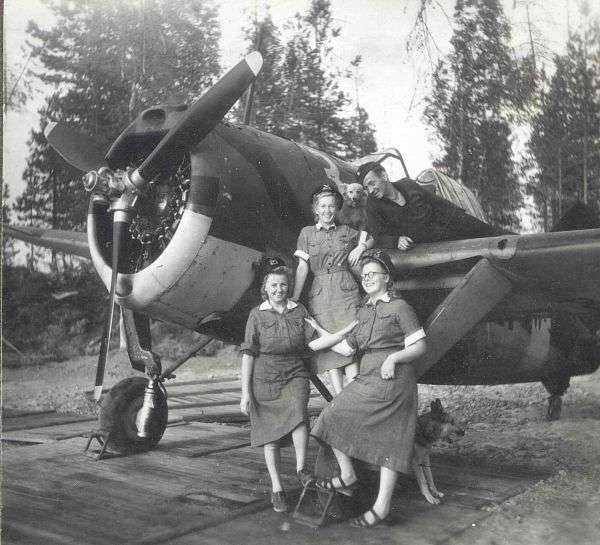
Ilmavoimat-Lotta ground-crew personnel in Summer 1940 with the Fighter they were responsible for maintaining. Ilmavoimat-Lotta ground-crew dress was usually not this formal, and in general clothing was identical to that issued to male groundcrew. It is likely that these Lottas were “dressed for the photograph.”
With the projected growth, the Ilmavoimat also focused more on developing an interest in aviation at an early age and providing as much preliminary training as possible. To this end, the existing Suomen Ilmapuolustusliitto or SIPL (Air Defence League) was given more support and the Ilmavoimat also encouraged gliding clubs and civilian flying, allowing Ilmavoimat bases to be used for these purposes.
The Suomen Ilmapuolustusliitto or SIPL (Air Defence League)
Gliding and private flying in Finland was closely associated with the Suomen Ilmapuolustusliitto (or SIPL as it was usually abbreviated to). SIPL had been founded in the 1920s as a kind of Air Civil Guard with local associations (Ilmapuolustusyhdistys) which owned their own aircraft and trained pilots. In the nationalist mood of the day, the task of Suomen Ilmapuolustusliitto was seen as being to arouse the interest of youth in aviation in the spirit of building up the national defences. The building of flying models and glider flying training were arranged for youngsters. (If you recall, the designer of the Merivoimat ground-effect craft we looked at previously, Toivo Kaario, had his interest in aviation aroused and encouraged in just this manner).
From 1933 on, the Ilmavoimat provided primary training aircraft and instructors to SIPL, with actual flying courses for older youth arranged. The purpose of these courses was to give basic training to to future air force pilots and at the same time, assess suitability for potential pilot trainees. The applicants had to fullfil Ilmavoimat requirements and to commit to finish an Imavoimat officer course if accepted. The aim was to train reserve pilots and funding was provided from the Ministry of Defence, with flying training provided primarily by Ilmavoimat Officers. But flying was not the only activity carried out by SIPL. Aircraft engineering and mechanics were taught, as was radio communications and training was open to both boys and girls. Many of the Ilmavoimat ground-crew and support personnel in the Winter War had their early interest in the Ilmavoimat encouraged by SIPL in the pre-war years and it was a program that paid remarkable dividends. The program grew in popularity and by 1938, the Ilmavoimat loaned fifteen Smolik trainers to SIPL for their annual Summer Camp training exercises, as well as regularly providing training aircraft on weekends.
Simultaneously with interest in SIPL, Gliding Clubs grew in popularity through the 1930s – and proved to be an activity with an unexpected outcome in the Winter War. Gliding as an activity in Finland began in the 1920s, but it was in the 1930s that it really took off. A demonstration of glising in Finland in 1934 by the German Deutscher Luftsportsvereinin gained a great deal of press attention and helped to popularise the sport and on 17 July 1935 the Jämi Gliding School held its first course. These gliding courses were open only to members of SIPL and as they grew in popularity and other Gliding Schools were opened, SIPL began providing its affiliated associations with free glider kits (in fact, in 1936 SIPL established Jämijärvi Wood and Metal Ltd to manufacture Gliders for the rapidly gowing gliding clubs. As we will see in a later post, Jämijärvi Wood and Metal Ltd took on a military role in the late 1930’s as the then newly-established Maavoimat Para-Jaeger units experimented with the use of assault-gliders).
Initially, Glider flying was organized on the German model – with Gliders launched from the tops of small hills and with flight duration measured in seconds or tens of seconds. With gliders being single seaters, the pilots first flight was a solo flight – which generally (but not always….) resulted in increased confidence. Typical of these Gliding Clubs was the Vaas Gliding Club, which was founded in the mid-1930s (and continues to this day incidentally). The Vaasa Gliding Club acquired its first Winch Car, a Packard, in December 1936. The Packard was an open top car, with one rear wheel replaced with a cable-drum and a “guillotine” fitted on the left front wheel to cut the rope used for towing if necessary. (The Packard was lost during the war).
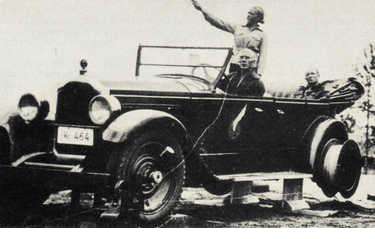
Jamilla: Photo taken in 1937. Miss Aili Heikinaro, christened "Finnish die Hannaksikin" stands in the new winch-Packard holding an outstretched signal flag. She was the first female glider pilot in the country. In the driver's seat sits Vaasa Glider Club President Gustav Aulin and in the backseat is "Pasi" Jääskeläinen. Note the "guillotine" on the left front wheel.
The development of Gliding proceeded at a rapid paceover 1934-1935 and in 1936, the Club’s first “real” glider, the Grunau Baby IIa was built. This was one of the most famous glider models of the 1930s and was built in large numbers around the world, with some 6,000 constructed worldwide. In Finland, over 30 of the Grunau Baby’s were built. Construction of the first Finnish Grunau Baby Iia started in Vaasa in December 1935, with SIPL organising and paying for all the necessary building materials as well as an Office Administrator to support the work. Volunteers from the Vaasa Club built the Glider which was completed on 27 June 1936 and christened "Antti-Jukaksi," which also became the symbol of the OH-Anssi-Jukka. Later, the machine was painted with the symbol of OH-VASA 3.
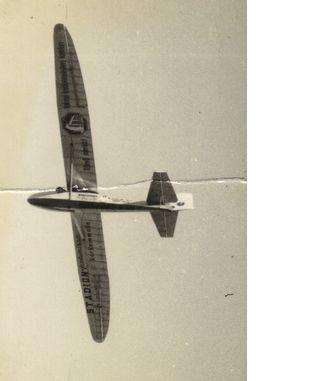
An old photo of "Antti-Jukasta" from the 1930s, complete with advertising for a brewery - "the mark which guarantees the quality of the drink." On the wings "Stadion pukimissa lentämällä pisimmälle ja korkeimmalle" and "Tämä merkki takaa kudonnaisten laadun”
In addition to the Vaasa Grunau Baby, further “Baby’s” wete built in Turku, Kuopio, Lahti, and two planes in Helsinki. The Vaasa Grunau Baby was taken to Jämijärvi in the same summer that it was built and started flights there. The machine participated the same year in Air Shows at Turku (6 September), Vyborg (13 September) and in Utti (20 September). Lieutenant T B Nissinen from Viipuri demonstrated aerobatics and Miss Aili Heikinaro was christened the "Finnish Hannaksi Die" by the public after a film of the flights was screened.
Reserve Lieutenant T B Nissinen had started his career as a pilot in Utti in 1924 and flew Maritime Patrol aircraft. He was based from Vaasa from 1932 and in addition to flying for the Ilmavoimat, Lt. Nissinen was involved from the outset in training and supervising flying and glider pilot training at Vaasa. SIPL hired Nissinen as a glider flight instructor in 1935, when his career with the Ilmavoimat ended. In the same year he became acquainted with German Gliding through the award of a German Ministry of Aviation scholarship. He served as director of construction union training courses in 1936-37, when Finland built a large number of Grunau 9 and Grunau Baby machines. Lt. Nissinen was awarded the title “flight captain” and the prestigious Harmon Award for Gliding Development in 1938. Flight Captain Nissinen was director of the Vaasa Gliding Club from 1935-44, and contributed much to the development of Finnish Gliding during that time. After his flying career ened, T.B. Nissinen took the position of Headmaster of the Kymi Oy Högfors engineering school.
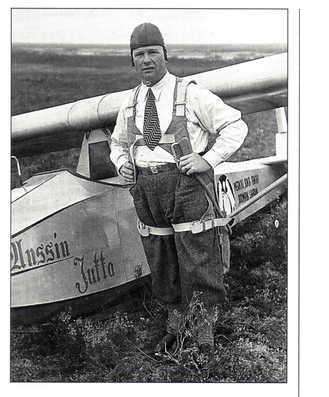
Jämi Instructor and Ilmavoimat Reserve Lieutenant T B Nissinen demonstrates the Vaasa clubs "Anssi-Jukka" Grunau Baby glider in the the 1930's.
That gliding was popular and that these Air Shows were well attended by the public is illustrated in the following Post, which is a translation of an Article from the North Satakunta Journal of 15 August 1936 and a series of accompanying photos.....
The Ramifications of the 1931 Military Review for the Ilmavoimat
The outcome of the 1931 Military Review for the Ilmavoimat was both extremely positive in terms of increased budgeting, and supportive of Somersalo’s views as to the future path the Ilmavoimat should take. Immediate measures that the Ilmavoimat took in 1931 were to order additional aircraft of types already in service while working to plan an immediate acquisition program for the 1932 financial year. That aside, the major planned emphasis was put a detailed five year plan for the continued strengthening of the Ilmavoimat together with the necessary steps towards putting in place the needed unit organisation together with the physical infrastructure. Now given a free rein, promoted and while answerable to the military command, with unfettered access to Mannerheim (which he rarely used), Somersalo was also able to move ahead with the development of the Ilmavoimat’s strategic and tactical doctrine development as he saw necessary and in this he had the assistance of some highly capable subordinates (more on these and the development of the Ilmavoimat’s strategic and tactical doctrine in a subsequent post).
We have already reviewed the Ilmavoimat and Valtion Lentokonetehdas’s purchasing and construction program through the 1920’s in detail. Moving ahead, we will now review the Ilmavoimat’s purchase program on a year by year basis through to the Munich Crisis of late 1938, where we will pause and look at other aspects of Finland’s military defence and foreign policy.
As of the end of 1930, immediately prior to the 1931 Military Review, the Ilmavoimat consisted of the following aircraft:
Primary Trainers
64 Caudron C.60s, purchased 1923 (Retired in 1936)
6 Morane-Saulnier MS50.C, in-service 1925 (Retired in 1939)
33 VL Sääski I, II and IIA, in-service 1928 (Retired in 1945)
18 De Havilland DH60 Moth, in-service 1929 (Retired in 1944)
75 Letov S.218.A Smolik, in-service 1930 (Retired in 1945)
Fighters
19 Gourdou-Leseurre GL-22, in-service 1923 (Retired in 1931)
15 Martinsyde F4 Buzzard, in-service 1923 (Retired in 1939)
12 Koolhoven F.K.31, in-service 1926 (Retired in 1931)
40 Haukka II, in-service 1927 (Retired in 1944)
Ground Attack / Army Liason
6 Junkers J1, in-service 1919 (Retired in 1932)
1 Fokker CV, in-service 1927 (Retired in 1945)
8 Aero A-11, in-service 1927 (Retired in 1939)
16 Aero A-32, in-service 1929 (Retired in 1944)
Transport
10 Junkers W.34, in-service 1930 (Retired in 1944)
Maritime Patrol
120 VL A.22 Hansa, in-service 1922 (Retired in 1936)
40 Blackburn Ripon IIF, in-service 1929 (Retired in 1944)
As we can see, with some 196 training aircraft, 86 Fighters, 31 Army Liasion/Light Bombers, 10 Transports and 147 odd maritime aircraft, the Ilmavoimat of 1930 was a reasonable size, albeit with a large number of aircraft that were, by 1930, outdated. It was from this foundation that the Commanding Officer of the Ilamvoimat, Aarne Somersalo, would go on through the decade of the 1930’s to build what was the most combat capable and effective airforce of the Second World War with an unrivalled kill ratio.
In 1931, orders for the following aircraft had been placed and these were in the process of being constructed:
Blackburn Ripon - 1st ordered 1927 (40 delivered between 1929 and 1933)
We’ve looked at the Blackburn Ripon in an earlier post – at this stage, suffice it to say that the Ilmavoimat had ordered one Blackburn Ripon in 1929, at the same time acquiring an unlimited license for production. The Ilmavoimat then ordered a first production series of 15 Ripon IIFs (type R.29) from VL. Series I, consisting of 7 aircraft, was delivered to Merilentoasema between 17 Dec, 1930 and 20 Oct, 1931 (these were powered by the 480 hp Gnome Rhone Jupiter VI engine - this engine resulted in the plane being under-powered for float operations and beginning in 1933, attempts were made to find a more aoppropriate engine). Series II, consisting of 8 aircraft, was delivered between 20 Oct, 1931 and 18 Feb, 1932 (these were powered by the 535 hp Armstrong Siddeley Panther engines). VL had been busy manufacturing Haukka II Fighters from October 1928 to April 1930.
Manufacturing of the license-built Ripon’s commenced immediately after the Haukka’s had been completed and kept VL working at capacity through 1930 and 1931. Following the defense review of 1931, a third series of 25 Ripons was ordered in late 1931. These were delivered between 11 June, 1932 and 26 Oct, 1933 and were powered by the 580 hp Bristol Pegasus engines – an alternatiove sources says the 620hp Bristol Pegasus II engine), equipping the Ilmavoimat with two full squadrons (40 Ripons in all) which were all in service by early 1934. In total, 40 Ripons were produced under License. However, construction of the aircraft by VL was beset by several problems and there were cost increases and delays in the delivery of the aircraft. The original manufacturer was not able to supply the detailed plans within the agreed timefeame and VL’s factory did not have the necessary tools to build all the components. In the end some parts had to be ordered from England, which caused further delays.

Quite a nice looking Finnish-built Blackburn Ripon with the Hispano Suiza V-12 photographed at Turkinsaari in the summer of 1937. This engine had 650 hp when the Bristol Pegasus II had 610 hp and the Armstrong Siddley Panther only 525 hp. The Finnish Air Force decided not to upgrade the engines and so this is the only Ripon to have an inline engine. Photo from "Suomen Ilmavoimat 1928-1940" by Keskinen, Partonen and Stenman
Letov S-18 (Smolik) Primary Trainers – 10 ordered 1930, 65 ordered early 1931
Through the 1930’s and the Second World War, the bulk of the Ilmavoimat’s Primary Trainers were the Letov S-18's. This was a Czechoslovak single-engined two seat biplane trainer designed by Alois Smolík at the firm of Letov Kbely which first flew in 1925. In 1929, one Š-218 Smolik had been shown at the Helsinki International Show and was purchased outright in March 1930 An order for nine further aircraft together with the manufacturing license was soon placed with Czechoslovakia and the nine aircraft ordered from arrived at the Kauhava Aviation School over May-June, 1931.
In the meantime, the 1931 Military Review was well underway and with the planned expansion of the Ilmavoimat, it was decided that substantially increased numbers of Primary Trainers were required for Pilot Training. Almost immediately on plans for Air Force expansion having been formulated by mid-1931, an order was placed with the State Aircraft Factory for a further 65 Smolik Primary Trainers to be delivered over the period 1932-1933. An expansion to VL manufacturing capacity and numbers of employees was planned for and funded was provided in the 1931 defense budget to enable this and other future Ilmavoimat orders to be met in the planned timeframe. The aircraft were manufactured by VL and delivered over 1932 to 1934, remaining in use as basic trainers until 1945, proving to be effective in their role as Primary Trainers and having been used as the Primary Trainer for most of the Ilmavoimat Pilots who fought in the Winter War so effectively.

Ilmavoimat Smolik S-218
The construction of 65 of these aircraft over a three year period (1932 – 1933 – 1934), whilst also fulfilling the orders for the Blackburn Ripon together with a small number of other aircraft, was a major strain for the VL factory at Suomenlinna. Thus, with the VL factory heavily committed for the next two years of production, aircraft orders placed in the last quarter of 1931 were focused largely on the ordering of completed aircraft from foreign manufacturers. (Prior to this, a single order for 12 Fokker CV CV twin-seat light reconnaissance and bomber biplane aircraft had been placed on 17 March 19321 with Fokker. The Ilmavoimat had one already in servivce that been purchased in 1927 and this had proven reliable and effective in its role. It could be manufactured and supplied quickly from the Fokker plant in the Netherlands and delivery was indeed quick – all 13 were received in the winter of 1932. (as a footnote, during the Winter War, Sweden donated three more C.V-Es. The aircraft were used as reconnaissance and light bomber aircraft through until 1945. During the Winter War, the Finnish C.Vs flew extensively on reconnaissance and harassment bombing sorties without suffering any losses).
The 1931 Ilmavoimat Purchase Program
For late 1931, the purchase program focused on two different aircraft types. The first order that was placed was for six VL-designed E.30 Kotka (Eagle) maritime patrol aircraft.The existing Hansa floatplanes were both obsolete and worn out and with delays in the Ripon manufacturing program and an interim replacement was desperately needed. The purchasing of a small number of Kotka’s was an interim solution – further orders were not envisaged. The second order placed was for 20 Curtiss F8C-5 Helldiver Divebombers.
Fokker CV
One Fokker C.V-E had been purchased in 1927, with delivery on 20 September of the same year. A further 13 were purchased on 17 March 1931, arriving in the winter of 1932.


Ilmavoimat Fokker CV - The Fokker C.V (or C.5) was the most successful export product of the Fokker factories after WWI. It was sold to Italy, Norway, Denmark, Hungary, Bolivia, China, Finland, Japan, Russia and the US. The C.V was fitted with twin FN 7.9 mm synchronized machineguns and one manually operated Lewis 7.9 mm machinegun in the rear which was operated by the navigator/observer/bomb-aimer. The two-seater plane was also capable of delivering a modest pay-load to the battlefield. For this purpose two racks were installed under the wings, which could carry either 16 shrapnel bombs of 8 kg each, 4 x 25 kg or 4 x 50 kg. With a speed of 155mph and a range of 621 miles, it was able to survive in WW2 combat by staying low and hedge-hopping.
VL Kotka I and II - 6 ordered 1931, retired 1944
The VL E.30 Kotka (Eagle) was a Finnish-designed and built two-seat biplane maritime patrol aircraft, designed by Kurt Berger at the State Aircraft Factory (Valtion Lentokonetehdas - VL). The project started when the Ilmavoimat began to look for a replacement for the now worn out and obsolete Hansa floatplanes that were in service with the Ilmavoimat. The prototype made its first flight on September 30, 1930. Work was terminated, only to be resumed and then continued in haste when the costs of, and delays in, the deliveries of the Blackburn Ripon became apparent. In 1931 Valtion Lentokonetehdas began producing a series of five aircraft. These were used as liaison aircraft until 1944.
The Kotka met the standards for a successful military aircraft at the time the order was placed and was no better or worse than comparable aircraft from other countries – which only shows that the amount of expertise was no better or worse than in other countries. The Ilmavoimat operated the six aircraft from 1931 to 1944. Additional numbers were contemplated but after the Ripon construction project was brought back onto track through the personal involvement of Rudolph Walden in the reorganization of the State Aircraft Factory (Valtion Lentokonetehdas - VL) it was decided that the aircraft was not required in any greater numbers.

With a crew of 2 (Pilot and Observer), powered by a single Wright R-1820 Cyclone E radial engine, the Kotka had a maximum speed of 140mph and a service ceiling of 9.840 feet

A VL Kotka II (Eagle) being assembled outdoors at Suomenlinna (a 250-year-old fortress outside Finland's capital, Helsinki). VL had begun its production at Suomenlinna and Santahamina in Helsinki and the factory did not have an airport, only the sea and sea ice could be used for take-off and landing. Most of the aircraft built in Helsinki were seaplanes and because of the small size of the factory at Suomenlinna, much of the final assembly was done outdoors.
OTL Note: One aircraft (no. 4, KA-147) is still preserved and on display at the Päijät-Häme Aviation Museum.
Curtiss F8C-5 Hell-Diver Divebomber – 20 ordered in late 1931
The second and final purchase of the last quarter of 1931 was an aircraft near and dear to the heart of the commander of the Ilmavoimat. Somersalo had been a long-time advocate of aircraft in specialised roles. While continually ushing for a strong fighter force for the Ilmavoimat, he in no way neglected other types, and with the increased budget available in the last quarter of 1931 for aircraft purchases, he saw the way open to beginning to modernise and build up the ground-attack component of the Ilmavoimat. From 1919 on, this had been largely the role of the six now antiquated Junkers J1’s which Somersalo had ensured were kept in service to preserve the limited institutional ground-attack aircraft knowledge, experience and tactical doctrine. While the J1’s were by 1931 obsolete, they had at least allowed for the continuation of limited ground-attack training and participation in Army exercises in a ground-attack role. In searching for an immediate replacement, Somersalo settled on the purchase of a number of Curtiss F8C-4 Helldivers from the United States. This type had originated with the US Marine Corps who were, in the late 1920s, developing dive-bombing techniques – a development which Somersalo and others in the Ilmavoimat had followed with interest from the sparse and sporadic reports available. Immediately after having been given the go-ahead for the 1931 last-quarter purchase program, Somersalo together with one test pilot, two crews from the J1 Flight and a Valtion Lentokonetehdas representative embarked on a trip to the United States to evaluate the aircraft. The aircraft proved to be almost everything Somersalo was looking for and the J1 crews were also enthusiastic after a series of comprehensive test flights. The Valtion Lentokonetehdas representative was perhaps less enthusiastic as the Helldiver used a different construction method than those VL had experience working with.
At its conception, Curtiss engineers had decided to make the Helldiver frame from welded steel tubing, which was a sharp departure over previous construction methods. Unlike the frame however, the Helldiver’s wing structure was a conventional of a wood-framework covered in canvas. Powered by a 450hp R-1340-80 Wasp, the XF8C-2 prototype had appeared early in 1929. Although the first prototype crashed in testing, the biplane showed enough promise to warrant further development. A second prototype, the XF8C-4, was flown in August 1929 and by early 1929, the Helldiver was in full production mode. The aircraft that emerged out of the ashes of the prototype was much more advanced. The F8C-4/02C Helldiver was now a pure, dedicated dive bomber aircraft with two fixed, forward firing heavy machine guns housed on the upper wing structure and a special bomb rack that was able to carry up to 500 pounds of ordinance.

Curtiss F8C Helldiver’s peeling off…….
The rack was designed to deploy the bomb away from the aircraft as it dived in order to avoid the bomb entering the propeller arc. As with many planes of the era, the F8C, although a very robust platform still lacked self-sealing fuel tanks which could have proved to be fatal if the plane were involved in combat. A single bullet could have turned the aircraft into a fiery coffin. Twenty five of the first Helldiver model, the F8C-4, went on to serve aboard the US Navy’s infant aircraft carrier fleet. The US Marine Corps received 63 examples of the modified, land based F8C-5 version. A 3rd type, a pure reconnaissance airplane, was known as the 02C-1. Thirty examples of this version were also ordered by the Navy. Although the aircraft did not see full fledged combat operations with the US Navy or Marine Corps, it had its moment in the sun. The plane, a favorite of the Navy’s nascent public relation office, was immortalized as the aircraft that shot down King Kong as he sat on top of the Empire State Building during the famous 1930s film.

Ilmavoimat F8C-5 Helldivers after delivery but before being repainted in Ilmavoimat colours or insignia: With a top speed of 160mph, a range of 720 miles, a service ceiling of 16,250 feet and armed with two forward-firing machineguns and 500lbs of bombs, this was an effective dive-bomber of the early 1930’s. Performance-wise, the F8C Helldiver was as fast as any Fighter aircraft in service at the time it was purchased.

A three-view drawing of the Curtiss F8C-4 Helldiver
Based on the success of the test flights, Somersalo signed an order with Curtiss on behalf of the Ilmavoimat for 20 F8C-5 Helldivers in late 1931. These were delivered to Finland in one shipment, arriving in June 1932 and entering service shortly thereafter. A two-seater, the Helldiver typically carried a Pilot in the front seat and an Observer in the rear. The Ilmavoimat version was fitted with then new 712 hp (531 kW) Wright Cyclone SR-1820 Cyclone 9 radial piston engine (giving a substantial improvement in performance over earlier models) and an additional ring-mounted machinegun for the Observer / Radio Operator. A small team from Curtiss accompanied the shipment, assisted with assembly and undertook a training program for Valtion Lentokonetehdas technical personnel and for the Ilmavoimat ground crew responsible for maintaining the aircraft. While on his trip to the USA and immediately after signing the order, Somersalo had arranged (with the prior concurrence of Finlands Ministry of Defence) for four US Marine Corps personnel (2 Pilots and 2 Observers) to spend some months with the Ilmavoimat Squadron flying the Helldivers, familiarising Ilmavoimat personnel with the aircraft and training them in the dive-bombing techniques that had been developed by the US Navy and Marine Corps. It was a valuable learning experience and a capability that the Ilmavoimat would go on to build on independantly.
Once familiar with the aircraft and the techniques of dive bombing, the Helldiver Squadron went on to develop standard dive bombing procedures over 1933. Having developed a standard dive bombing procedure, the Helldiver Squadron commenced regular Army cooperation exercises from 1934 on. From 1935 on, the Squadron also exercised regularly with the Experimental Combined Arms Battle Group, where the skills and lessons learned were incorporated into the military tactical battle fighting doctrine that was in the process of being developed and implemented in a continuous feedback loop. It was as a result of the lessons learned from these ongoing exercises that the Ilmavoimat purchased additional and more modern dive bombers in the period preceding the Winter War. These would serve Finland well in battle, but it was the purchase of the Helldivers that laid the foundations for future success.
The 1932 Ilmavoimat Purchase Program
In late 1931, the Ilmavoimat and Valtion Lentokonetehdas put in place a joint Procurement Organisation structured to continually tracking and evaluating aircraft from manufacturers in Britain, France, Italy, Germany, Czechoslovakia, Poland and the United States. Where an aircraft was of interest and available for test flights, a small evaluation team was sent to the manufacturer to carry out a preliminary evaluation program. At the same time, a separate unit within the General Staff (with Ilmavoimat and Valtion Lentokonetehdas members as well as Maavoimat, Merivoimat and technical / civilian members) was setup to track weapons development programs in the primary threat – the USSR. Attention was also paid to doctrinal development and, wherever possible, Finnish military representatives attended Soviet military exercises as observers. In addition, close ties were maintained with the German military and important information on the Soviet Union was obtained unofficially (and at times officially) through this channel.
In 1932, the Ilmavoimat commenced upgrading its Fighter Aircraft. While longer term plans were still being made, it was decided that at least two Squadrons of the most modern fighters should be purchased as a start and to enable the Fighter Pilot training program to move ahead. To this end, the Ilmavoimat decided on the purchase of forty Bristol Bulldog’s from the UK.
Bristol Bulldog Biplane Fighter – ordered 1932
The Bristol Bulldog was a British Royal Air Force (RAF) single-seat biplane fighter designed during the late 1920s by the Bristol Aeroplane Company. The Ilmavoimat purchased forty Bristol Bulldog Mk IVAs from Britain, ordering these on 24 March 1932 and taking delivery in February 1933. This was a relatively expensive purchase but by purchasing the aircraft outright rather than building under license, rapid delivery was assured.

Ilmavoimat Bristol Bulldog – Winter War

The Bulldog was the first aircraft to exceed 300 km/h in level flight in Finland. Sweden donated two Bulldog IIAs to Finland during the Winter War. These aircraft had negligible effect on the war effort due to damage they sustained in service.
In September 1926, the British Air Ministry had stated a need for a single-seat fighter capable of operating in day and night-time conditions; to be armed with two 0.303 in (7.7 mm) Vickers machine guns and to be powered by a radial air-cooled engine. This requirement was laid down in Specification F9/26. The Bulldog was designed by Frank Barnwell, the Chief Designer of the Bristol company, (who had served as a Captain in the British Army during the First World War), as a private venture to meet the requirements of this specification. The Bristol Bulldog was a mixed structure bi-plane fighter with a fixed landing gear. It had a high tensile steel strip construction with fabric skinning. By comparison with the standard Mk. IIA, the Mk. IVA had deeper, biconvex wing sections, permitting the fuel tanks to be accommodated completely within the wing profile; reduced lower wing chord to improve the pilot's view; single (in place of double) lift wires; a deeper rear fuselage of increased stiffness and a long-chord cowling for the engine.
The prototype Bulldog, the Bulldog Mk. I first flew on 17 May 1927. After initial consideration of all the types entered to meet the specification, the Bulldog and the Hawker Hawfinch were selected by the British Air Ministry for more detailed evaluation. While the Bulldog's manoeuvrability and strength were praised by the RAF, it initially had poor spinning recovery properties and was therefore fitted with a lengthened rear fuselage. In this form, it was declared the winner of the competition, having slightly superior speed and being easier to maintain, requiring fewer changes to produce an operational aircraft than the Hawfinch. The full-production Bulldog came in the form of the Mk.II, which had a modified structure but in every other respect was identical to the original Bulldog; having two 0.303 in (7.7 mm) Vickers machine guns; a capacity for four 20 lb (9 kg) bombs; a 450 hp (336 kW) Bristol Jupiter radial engine; giving the Bulldog a maximum speed of just under 180 mph (290 km/h) and a range of 300 miles (480 km).
The aircraft entered production in 1928, entering service the following year, and becoming, during the early 1930s, the most widely used aircraft in the RAF over the inter-war period with over four hundred Bulldogs produced. It was cheap to maintain and thus, at a time of defence budget constraints, was the more preferable option to any other of the more expensive competitors. The Mk. IIA was again virtually similar to its predecessor, though it had a new Jupiter engine and a strengthened structure. The Bulldog proved to be quite a successful export to foreign air forces, seeing service with Australia, Denmark, Estonia, Finland, Japan, Latvia, Siam, Spain and Sweden. The Bulldog was withdrawn from RAF service in 1937, being replaced by the Hawker Hurricane and Supermarine Spitfire, both of which would become legends of the RAF for their contributions during the Second World War. The Bristol Bulldog's career was not over though, for the type continued to serve with other air forces. The Bulldog never saw combat service with the RAF. A number of Bulldogs, ex-Latvian aircraft, saw service during the Spanish Civil War, as part of the forces fighting the Nationalists.
Ilmavoimat Bulldogs however saw combat in two wars. In 1937, twenty Bulldogs were sold as “surplus” to a German arms dealer, and “somehow” found their way to Spain, where by a strange coincidence they were the first aircraft flown by the Finnish Volunteer Squadron attached to the Finnish Volunteer Division (“Pohjan Pojat” – the Boys from the North) fighting with Franco’s Nationalist Forces in the Spanish Civil War. Considerable experience was gained, with the Finnish Pilots achieving rermarkable successes in their Bulldogs against their “Republican” opponents. This experience will be discussed in detail in a later post covering all aspects of the now little-known and virtually forgotten Finnish Volunteer involvement in the Spanish Civil War.
Ilmavoimat Bulldogs continued to serve during the Winter War against the Soviet Union, which began in 1939. As in Spain, the Bulldogs fought well against their Soviet opponent, gaining six kills by five pilots for the loss of one of their own, the types shot down being two Polikarpov I-16s and four Tupolev SB-2s, both of which were quite superior in terms of technology compared to the Bulldog. In fact, OTL, the very first aerial victory of the Finnish Air Force was achieved by a Bulldog piloted by SSgt Toivo Uuttu on 1 December 1939. OTL, the Bulldog continued in service during the subsequent Continuation War against the Soviet Union, though without scoring any further kills or suffering losses. ATL, the Bulldog was generally relegated to use as an Advanced Fighter Trainer and, while it saw limited action in early stages of the Winter War, was relegated to training use from early 1940.
1933 Ilmavoimat Organisational Changes
By 1933, the Ilmavoimat’s five-year plan had been drawn up and approved. In essence, this consisted of a steady acquisiton program for a combination of Fighters, Ground-attack aircraft and bombers, maritime patrol, transport and trainers. In addition, the ongoing role of dive-bombers was seen as being applicable to supporting both the Maavoimat and Merivoimat. The intent was to ensure the continual phasing in of late-model aircraft on an ongoing basis. That this would in all likeliehood result in a disparate range of aircraft in service at any one time was recognised. Conversely, this would also reduce the chances of entering a war with a large number of aircraft that were obsolete and not capable of putting up an effective fight. Some aircraft would be obsolete or outclassed, but at least some would not. With this in mind, actual purchases were decided on a year-by-year basis dependent on what was available and the conclusions of the evaluation and test teams.
At the same time, it was also recognised that the ongoing expansion of the Ilmavoimat would demand more personnel and infrastructure. Up until 1932, the Ilmavoimat had generally been made up largely of permanent personnel with small numbers of reservists. From 1933 on, the Ilmavoimat would be gradually re-shaped, with the organisation being structured around a core of permanent personnel forming a small number of squadrons together with permanent training cadre, conscript-volunteers and Active Reserves. A precondition of conscripts being accepted as volunteers for the Ilmavoimat would be a commitment to 18 months of conscript service rather than the Maavoimat’s 12 months, joining the Ilmavoimat Active Reserve for a ten-year period and maintaining annual training status. With the growth that was projected for the Ilmavoimat between 1933 and 1938, over time it was foreseen that the bulk of the Ilmavoimat squadrons would be manned by Active Reserve units, with an increasingly active weekend training schedule needed to keep training and skills current.
Additionally, and far more radically, the Ilmavoimat from 1933 on permitted women to join in all capacities, including as pilots (albeit women pilots were permitted to fly transport aircraft and ferry-flights only – and had to have alrerady qualified as civilian pilots before being accepted to sit the entrance exams). While joining was voluntary for women, after being accepted they were then subject to the same training as male conscripts. This became an increasingly popular choice for young women and by the late 1930’s, approximately one third of Ilmavoimat personnel were women, serving in all except front-line pilot and air-crew roles and filling many of the maintenance and administrative positions within the Ilmavoimat, as well as crewing the AA Guns protecting Ilmavoimat airbases, working as parachute-packers, bomb-fitters and the like.

Ilmavoimat-Lotta ground-crew personnel in Summer 1940 with the Fighter they were responsible for maintaining. Ilmavoimat-Lotta ground-crew dress was usually not this formal, and in general clothing was identical to that issued to male groundcrew. It is likely that these Lottas were “dressed for the photograph.”
With the projected growth, the Ilmavoimat also focused more on developing an interest in aviation at an early age and providing as much preliminary training as possible. To this end, the existing Suomen Ilmapuolustusliitto or SIPL (Air Defence League) was given more support and the Ilmavoimat also encouraged gliding clubs and civilian flying, allowing Ilmavoimat bases to be used for these purposes.
The Suomen Ilmapuolustusliitto or SIPL (Air Defence League)
Gliding and private flying in Finland was closely associated with the Suomen Ilmapuolustusliitto (or SIPL as it was usually abbreviated to). SIPL had been founded in the 1920s as a kind of Air Civil Guard with local associations (Ilmapuolustusyhdistys) which owned their own aircraft and trained pilots. In the nationalist mood of the day, the task of Suomen Ilmapuolustusliitto was seen as being to arouse the interest of youth in aviation in the spirit of building up the national defences. The building of flying models and glider flying training were arranged for youngsters. (If you recall, the designer of the Merivoimat ground-effect craft we looked at previously, Toivo Kaario, had his interest in aviation aroused and encouraged in just this manner).
From 1933 on, the Ilmavoimat provided primary training aircraft and instructors to SIPL, with actual flying courses for older youth arranged. The purpose of these courses was to give basic training to to future air force pilots and at the same time, assess suitability for potential pilot trainees. The applicants had to fullfil Ilmavoimat requirements and to commit to finish an Imavoimat officer course if accepted. The aim was to train reserve pilots and funding was provided from the Ministry of Defence, with flying training provided primarily by Ilmavoimat Officers. But flying was not the only activity carried out by SIPL. Aircraft engineering and mechanics were taught, as was radio communications and training was open to both boys and girls. Many of the Ilmavoimat ground-crew and support personnel in the Winter War had their early interest in the Ilmavoimat encouraged by SIPL in the pre-war years and it was a program that paid remarkable dividends. The program grew in popularity and by 1938, the Ilmavoimat loaned fifteen Smolik trainers to SIPL for their annual Summer Camp training exercises, as well as regularly providing training aircraft on weekends.
Simultaneously with interest in SIPL, Gliding Clubs grew in popularity through the 1930s – and proved to be an activity with an unexpected outcome in the Winter War. Gliding as an activity in Finland began in the 1920s, but it was in the 1930s that it really took off. A demonstration of glising in Finland in 1934 by the German Deutscher Luftsportsvereinin gained a great deal of press attention and helped to popularise the sport and on 17 July 1935 the Jämi Gliding School held its first course. These gliding courses were open only to members of SIPL and as they grew in popularity and other Gliding Schools were opened, SIPL began providing its affiliated associations with free glider kits (in fact, in 1936 SIPL established Jämijärvi Wood and Metal Ltd to manufacture Gliders for the rapidly gowing gliding clubs. As we will see in a later post, Jämijärvi Wood and Metal Ltd took on a military role in the late 1930’s as the then newly-established Maavoimat Para-Jaeger units experimented with the use of assault-gliders).
Initially, Glider flying was organized on the German model – with Gliders launched from the tops of small hills and with flight duration measured in seconds or tens of seconds. With gliders being single seaters, the pilots first flight was a solo flight – which generally (but not always….) resulted in increased confidence. Typical of these Gliding Clubs was the Vaas Gliding Club, which was founded in the mid-1930s (and continues to this day incidentally). The Vaasa Gliding Club acquired its first Winch Car, a Packard, in December 1936. The Packard was an open top car, with one rear wheel replaced with a cable-drum and a “guillotine” fitted on the left front wheel to cut the rope used for towing if necessary. (The Packard was lost during the war).

Jamilla: Photo taken in 1937. Miss Aili Heikinaro, christened "Finnish die Hannaksikin" stands in the new winch-Packard holding an outstretched signal flag. She was the first female glider pilot in the country. In the driver's seat sits Vaasa Glider Club President Gustav Aulin and in the backseat is "Pasi" Jääskeläinen. Note the "guillotine" on the left front wheel.
The development of Gliding proceeded at a rapid paceover 1934-1935 and in 1936, the Club’s first “real” glider, the Grunau Baby IIa was built. This was one of the most famous glider models of the 1930s and was built in large numbers around the world, with some 6,000 constructed worldwide. In Finland, over 30 of the Grunau Baby’s were built. Construction of the first Finnish Grunau Baby Iia started in Vaasa in December 1935, with SIPL organising and paying for all the necessary building materials as well as an Office Administrator to support the work. Volunteers from the Vaasa Club built the Glider which was completed on 27 June 1936 and christened "Antti-Jukaksi," which also became the symbol of the OH-Anssi-Jukka. Later, the machine was painted with the symbol of OH-VASA 3.

An old photo of "Antti-Jukasta" from the 1930s, complete with advertising for a brewery - "the mark which guarantees the quality of the drink." On the wings "Stadion pukimissa lentämällä pisimmälle ja korkeimmalle" and "Tämä merkki takaa kudonnaisten laadun”
In addition to the Vaasa Grunau Baby, further “Baby’s” wete built in Turku, Kuopio, Lahti, and two planes in Helsinki. The Vaasa Grunau Baby was taken to Jämijärvi in the same summer that it was built and started flights there. The machine participated the same year in Air Shows at Turku (6 September), Vyborg (13 September) and in Utti (20 September). Lieutenant T B Nissinen from Viipuri demonstrated aerobatics and Miss Aili Heikinaro was christened the "Finnish Hannaksi Die" by the public after a film of the flights was screened.
Reserve Lieutenant T B Nissinen had started his career as a pilot in Utti in 1924 and flew Maritime Patrol aircraft. He was based from Vaasa from 1932 and in addition to flying for the Ilmavoimat, Lt. Nissinen was involved from the outset in training and supervising flying and glider pilot training at Vaasa. SIPL hired Nissinen as a glider flight instructor in 1935, when his career with the Ilmavoimat ended. In the same year he became acquainted with German Gliding through the award of a German Ministry of Aviation scholarship. He served as director of construction union training courses in 1936-37, when Finland built a large number of Grunau 9 and Grunau Baby machines. Lt. Nissinen was awarded the title “flight captain” and the prestigious Harmon Award for Gliding Development in 1938. Flight Captain Nissinen was director of the Vaasa Gliding Club from 1935-44, and contributed much to the development of Finnish Gliding during that time. After his flying career ened, T.B. Nissinen took the position of Headmaster of the Kymi Oy Högfors engineering school.

Jämi Instructor and Ilmavoimat Reserve Lieutenant T B Nissinen demonstrates the Vaasa clubs "Anssi-Jukka" Grunau Baby glider in the the 1930's.
That gliding was popular and that these Air Shows were well attended by the public is illustrated in the following Post, which is a translation of an Article from the North Satakunta Journal of 15 August 1936 and a series of accompanying photos.....
The North Satakunta Air Show of August 1936
That gliding was popular and that these Air Shows were well attended by the public is illustrated by the following Article from the North Satakunta Journal of 15 August 1936 and a series of accompanying photos.
08/14/1936 North Satakunta - Journal
Last Sunday the Jämijärvi Finnish Air Defence League Air Show was held, with Field Marshal Mannerheim as the guest of honor. The Minister of Defence and a number of other high ranking officers were present. The Air Show attracted a crowd of several thousand people. Large numbers of buses, cars, trucks, private cars, motorcycles and bicycles brought spectators to the Show from Tampere, Pori and Helsinki as well as up from Vaasa. Field Marshal Mannerheim, who had spent the previous night in Tampere and left there at 6am in the morning to follow the battle exercises at the Kankaanpää reservist camp, arrived directly from Kankaanpää. He was greeted by the Satakunta Suojeluskuntapiirin Company Honor Guard, the flags of Finland and the Air Defence League and at the same time a small girl gave to the Field Marshal a bouquet of roses.. Also greeting the Marshal were members of the Air Defence Club executive and central committee members.
As well as the presence of Field Marshal Mannerheim and the Defence Minister, those present included the Air Force \Commander, Colonel Guide, Colonel Oar (yleisesikunnasta), Colonel Vinell of the Kankaanpää Training Centre, the Airfield commander, the provincial military commander, Colonel Siilasvuo, everstil. Kari Koski, Aviation relevant rapporteur, the Minister of Transport and Public Works, Ståhle of Aero Oy, Finland Air Defence Central Executive Council members as well as many Air Force officers. The audience was therefore the most representative and authoritative on aviation matters. After the arrival of the Marshal, the official guests moved to a high sand ridge to watch the Glider Air Show, which mainly consisted of glider pilot students flying a variety of glider types. The Chairman of the Gliding Central Committee acted as guide for the Field Marshal.
The Progam included the first use of a rubber rope in combination with a winch car to get the Gliders airborne. This involves a long rubber rope which the machine winch machine uses to sling the glider from the ridge into the air. The automobile takeoff, as it is known, is carried out in such a way that the aircraft nose is attached to a long steel cable. This cable is attached to a drum on the rear wheel which us then quickly wound in, giving the glider the initial velocity to ascend into the air. The towing cable length was 800 meters, the towing cable is quickly wound in, the glider asends and then once in the air above the car the pilots release the wire above the winch machine and continue to fly above the audience. While there were no tow-aircraft available, using this launching apparatus the Pilots were able to achieve as great a height as in the previous years show. The first flight was by Gliding School student Miss Aili Hedstrom (later surname suomalaistettu Heikinaro), a high school student from Vaasa flying the Kuopio Air Defence Association Grünau 9. She flew beautifully above the ridge and then descended back to the place of origin, making beautiful curves above the landscape. This flight, like everyone elses, was well received by the spectators and the Pilot effortlessly landed at the forest edge.
Other flights followed. The next flight, which was fairly long, was carried out in the Satakunta Flying Club machine. The Southern Finland Air Defence League presented to the public an early trainer built by the association, the “Kassel 12”, which is a relatively "old fashioned" model. The Helsinki air defense built Grünau Baby II flew and of course soared the highest, two times more than a basic trainer. Other gliders and pilots flew in Grünau 9’s and Grünau Baby II’s and the last flight was by glider flight chief instructor TB Nissinen who performed an aerobatic show with beautiful looping which attracted a round of applause from the spectators, especially as his starting point for the aerobatics was only 300 metres. The audience viewed the entire show with pleasure, especially as it was performed not by foreign glider pilots but by all Finnish pilots and Finnis enthusiasts who are all volunteers.
Field Marshal Mannerheim, as he left the Show, was given a triple-hurrah by the audience, who then cheered him as he departed. The Air Show went according to plan in every way and the weather was ideal. The Air Show went according to plan in every way, and it was beautiful weather. Catering was provided by the Jämijärvi Lotta women, whose dishes went like hot cakes.
What follows is a series of 47 Photos from an Air Show that I believe is the one reported in the article above from the North Satakunta Journal of 15 August 1936. The captions for the photos are apparantly those written into the original photo album that these were scanned in from. For anyone interested, here’s the link to where I sourced the photos from: http://www.flightforum.fi/forum/index.php/topic,84677.0.html

Valmiina – “Ready”
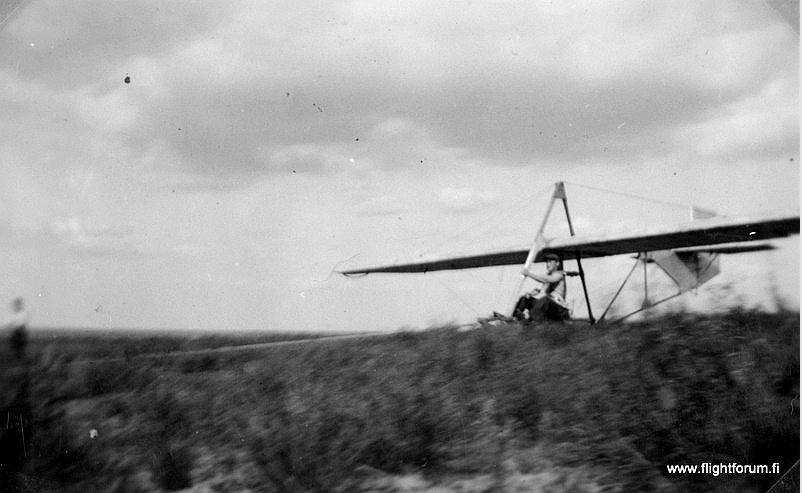
Veto! – “Pull”

Irti! – “Off”
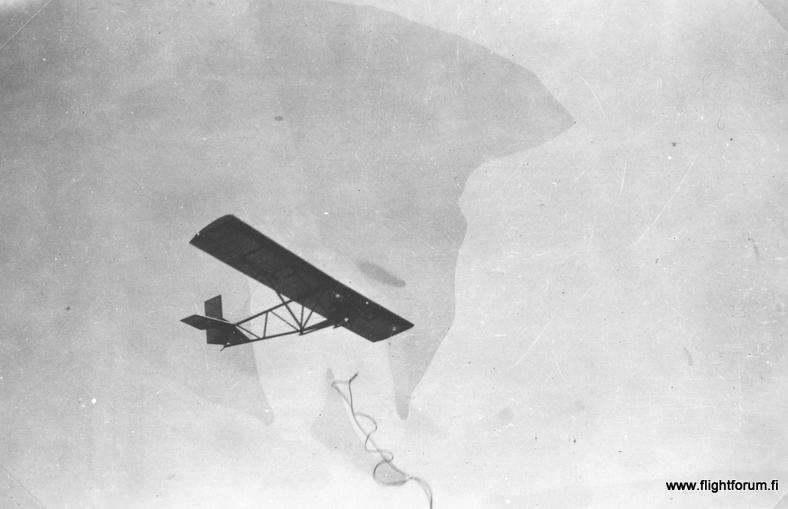
Köysi irtoaa – “The rope comes off”
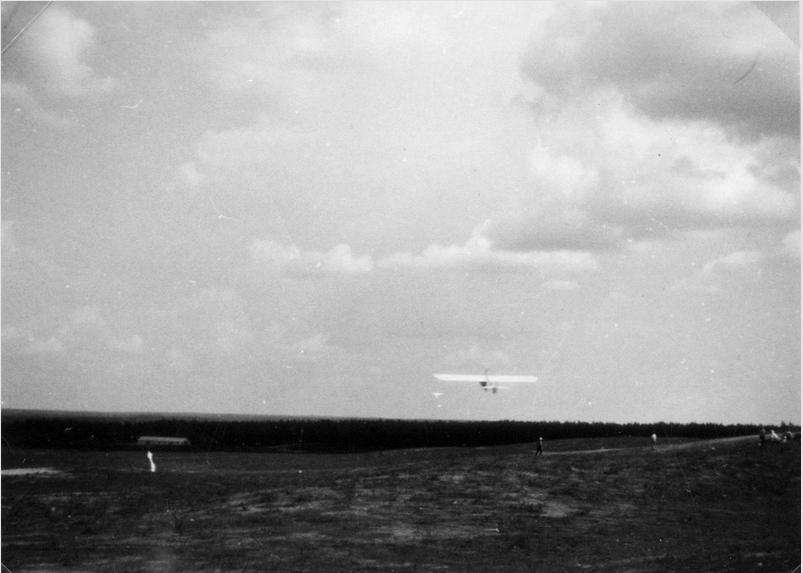
Liito – “Glide”
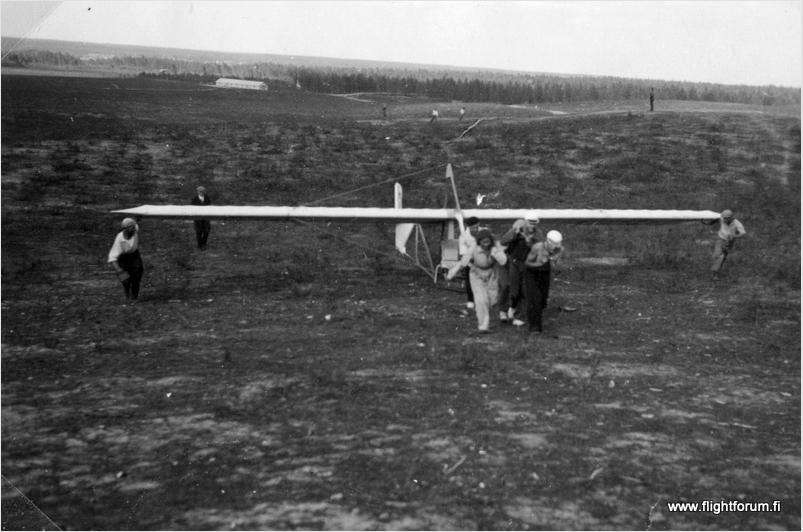
Hinaus takaisin – “Pulling the glider back”
The following photo has no caption…..
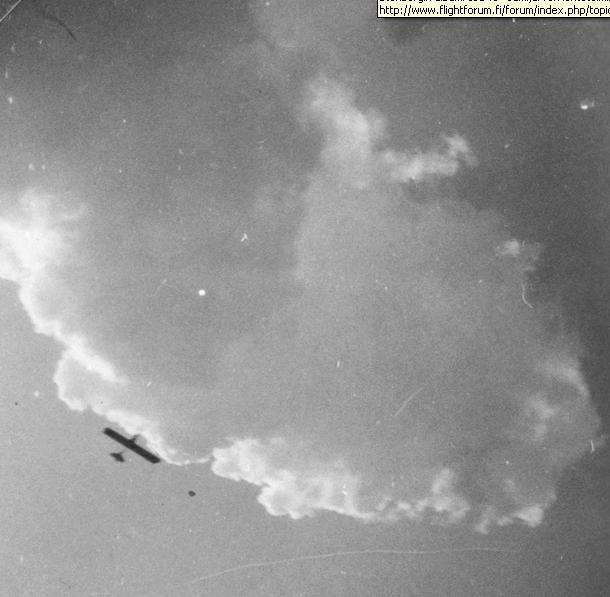
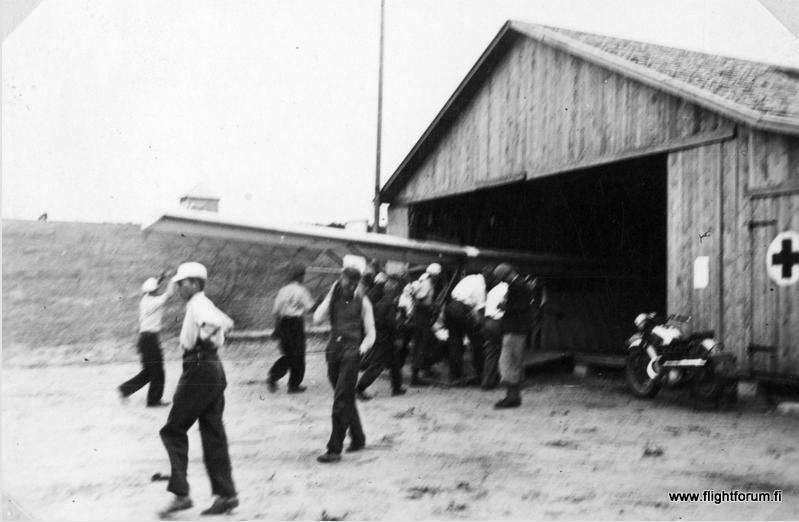
Kone suojasta – Protection for the Glider

Hinaus starttipaikalle – “Towing to the Launching Point”
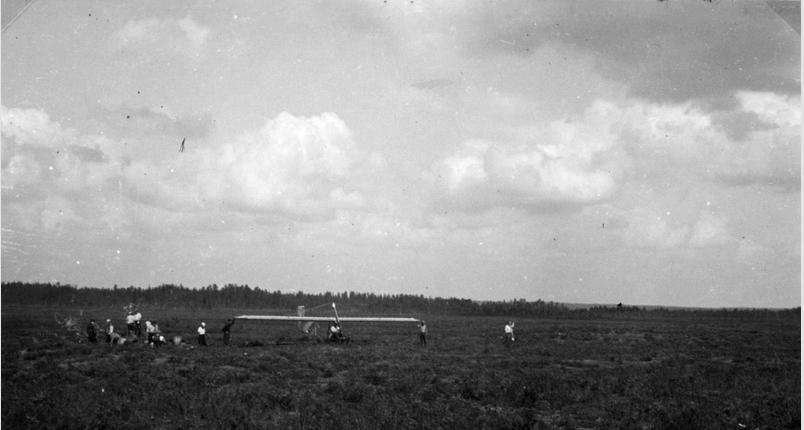
Valmiina! – “Ready!”
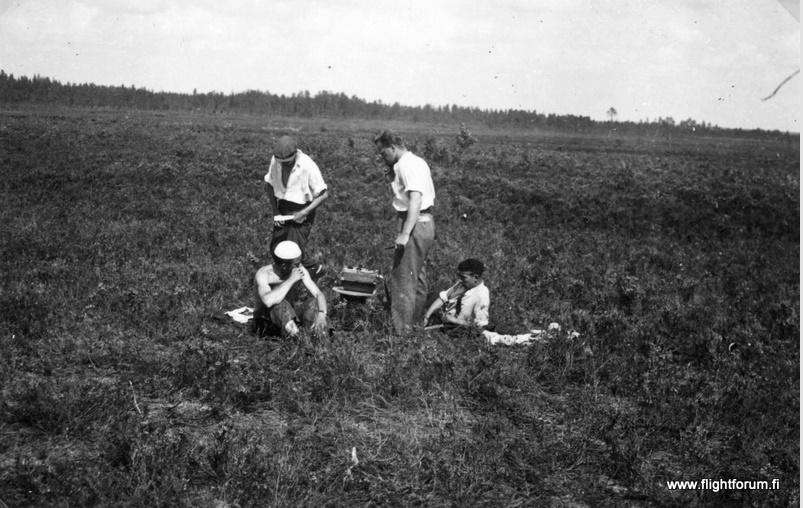
Puhelin ilmoitus hinaus paikalle - Telephone notification at the towing scene
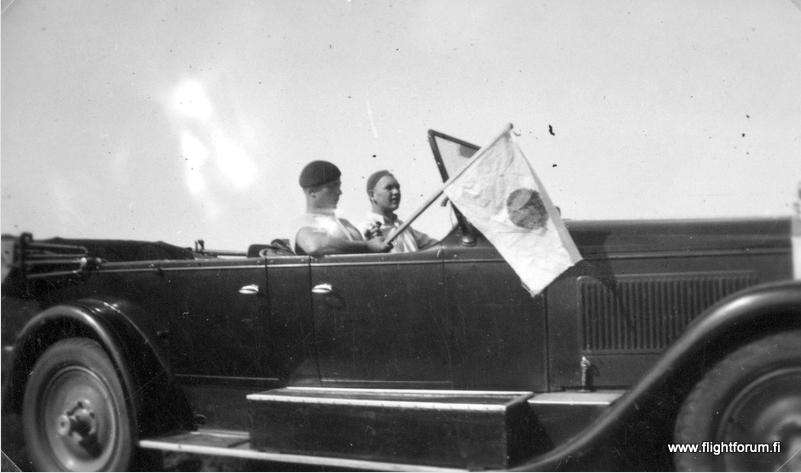
Winch Car with the signal flag

Hinausta - Towing

Nousu alkaa! – Liftoff
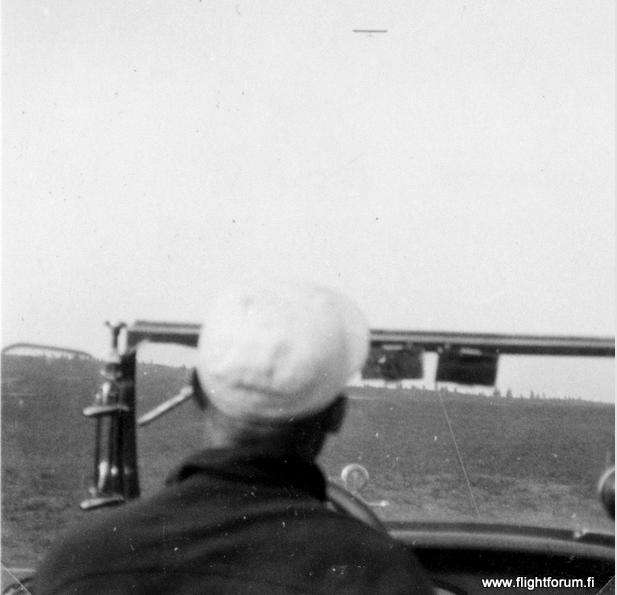
Silmä tarkkana – Watching closely
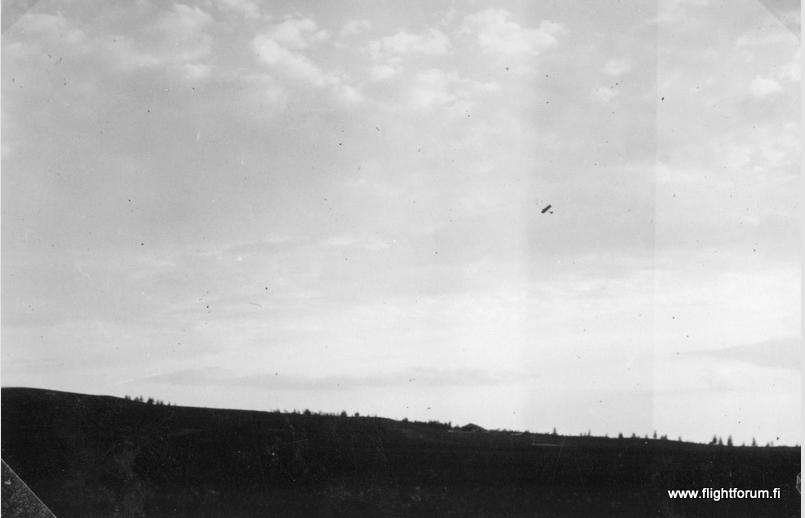
Kone nousemassa – Glider is on its own…
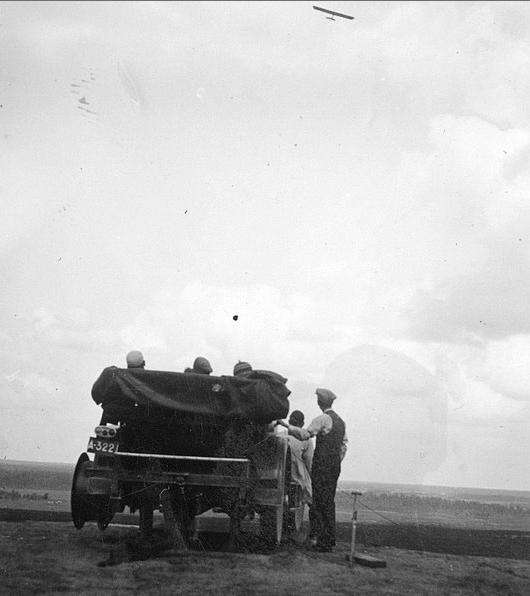
Lähellä lakipistetä – In the act of Gliding

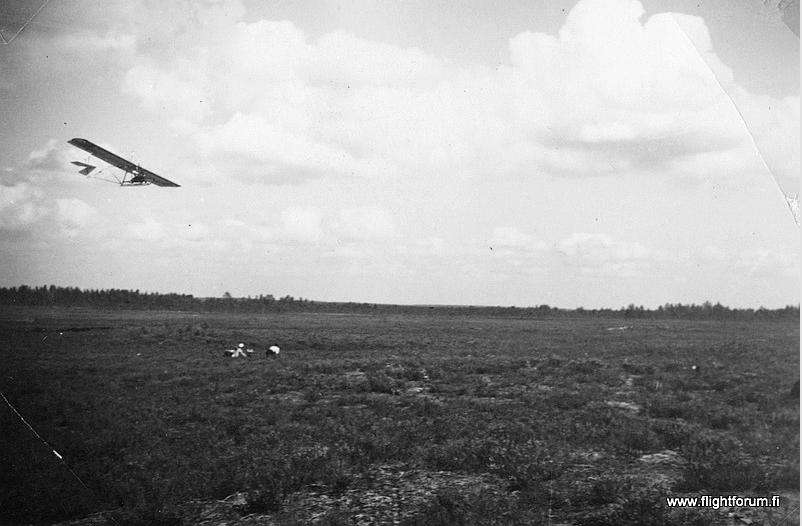
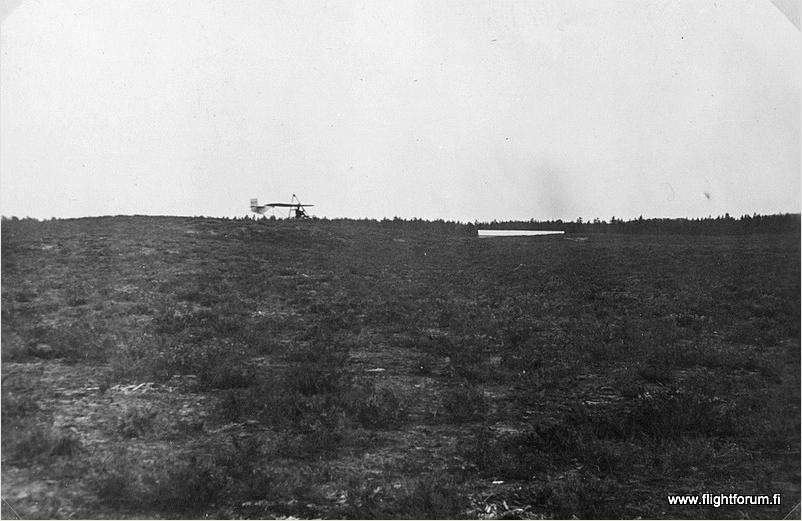
Lasku – About to launch
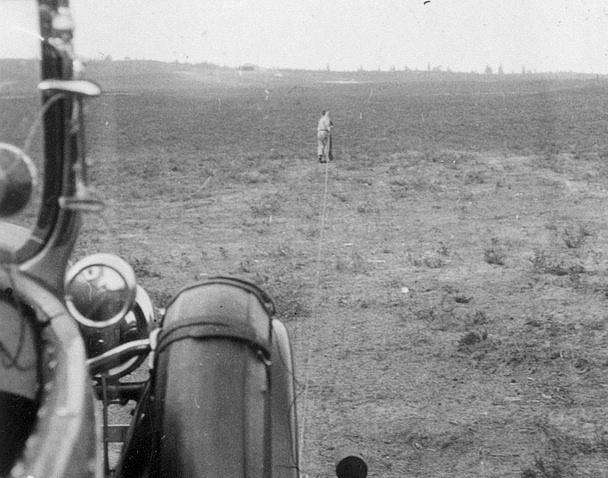
Vaijeri vedetään takaisin – “The Wire is Pulled back”
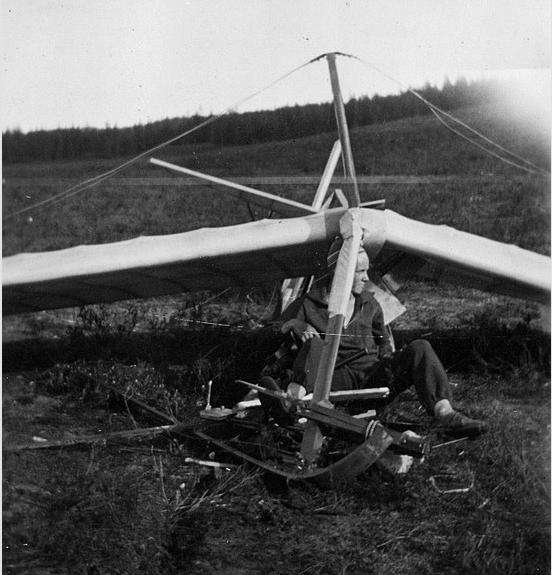
Sattui sitä vahinkojakin, konerikkoja, mutta muuten vaarattomia – Crashes happen, the Glider gets broken but otherwise no harm
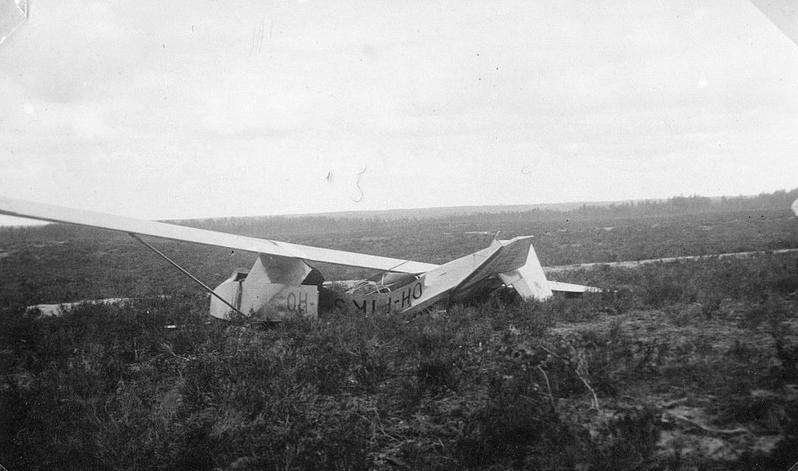
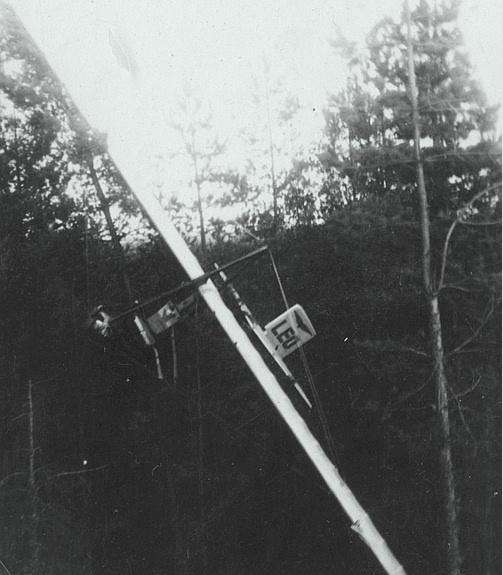
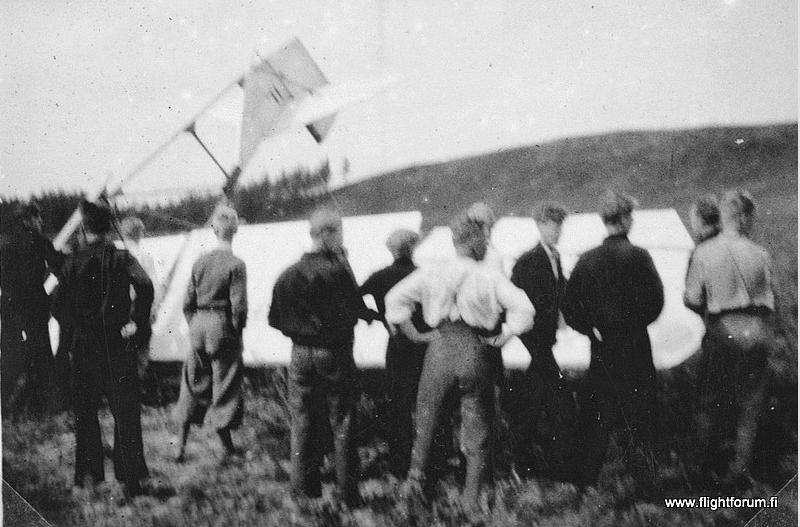
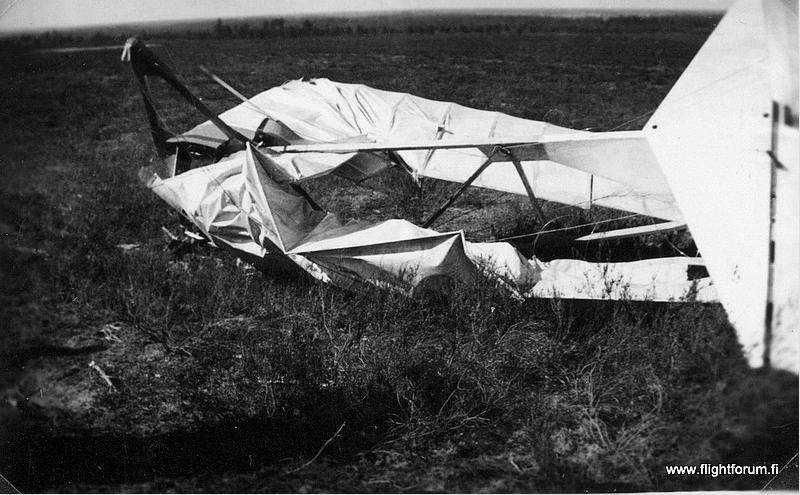
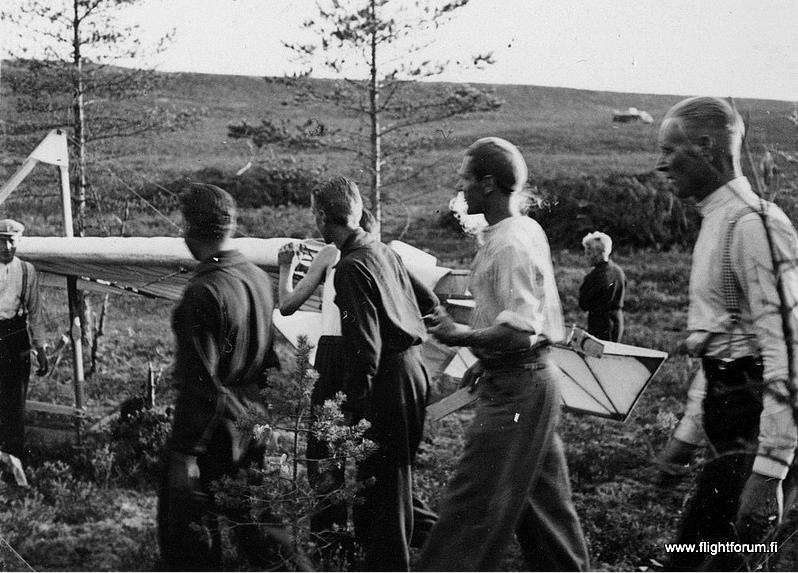
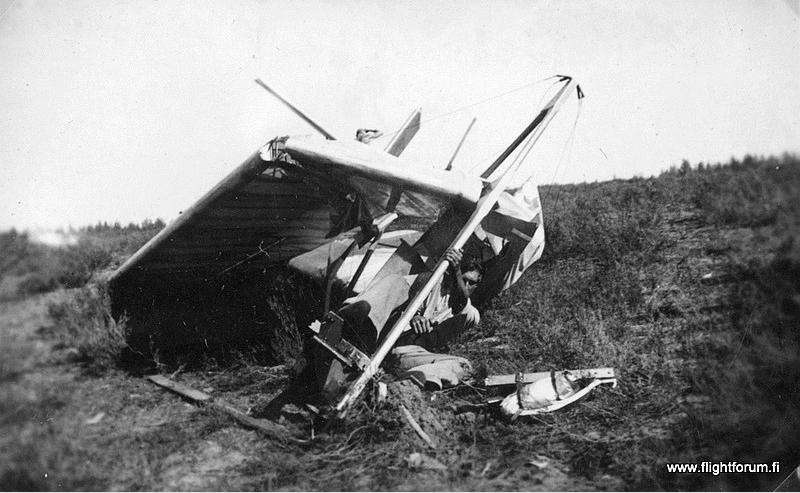

Tässä on PIK:n Grunau Baby OH-PIK3, joka saatiin kesäkuun 1936 alkupäivinä Jämille. Eräs apuopettaja rikkoi koneen rungon 13. lennon päätteeksi.- This is the Grunau Baby PIK3-OH, which was the beginning of June, 1936 Distance to Jämi - one of the auxiliary instructors and teachers broke the fuselage at the end of the flight.


Ittekin tein Komar'illa "kaputin", nokka poikki + nyrjähtänyt nilkka – The Glider is “kaput” – but the pilot only has a sprained ankle
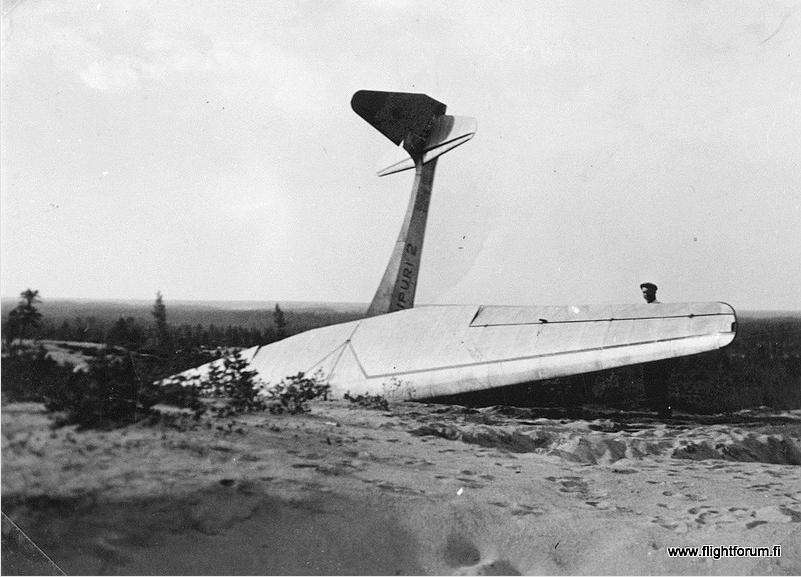
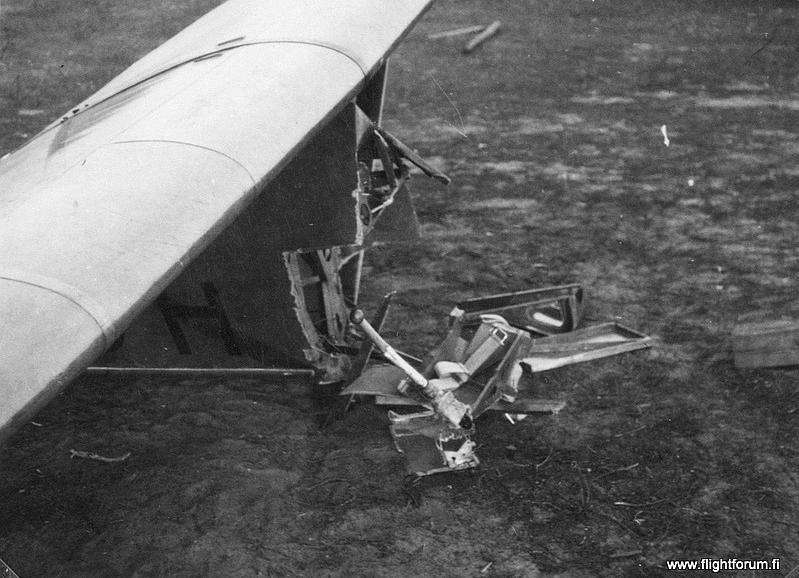
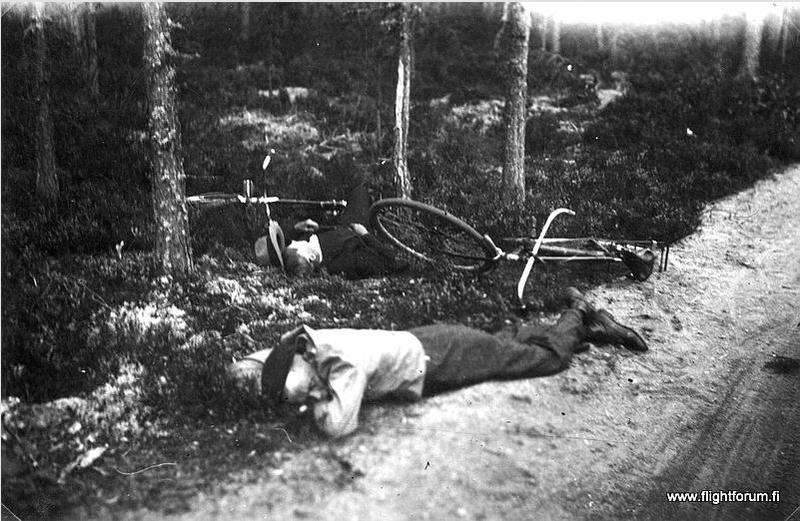
Sattui yleisöllekin "vahinkoja" välistä! Muutamat "väsyneet matkamiehet" virvoitettiin paloruiskulla ja herätys oli hölmöhkö, mutta pystyttiin kuitenkin kotimatkalle – “Damage” also happens to the general public and gliders alike! Some men are “tired of traveling” – but the fire alarm was given and with the help of a good squirt of water, they were assisted on their way home….
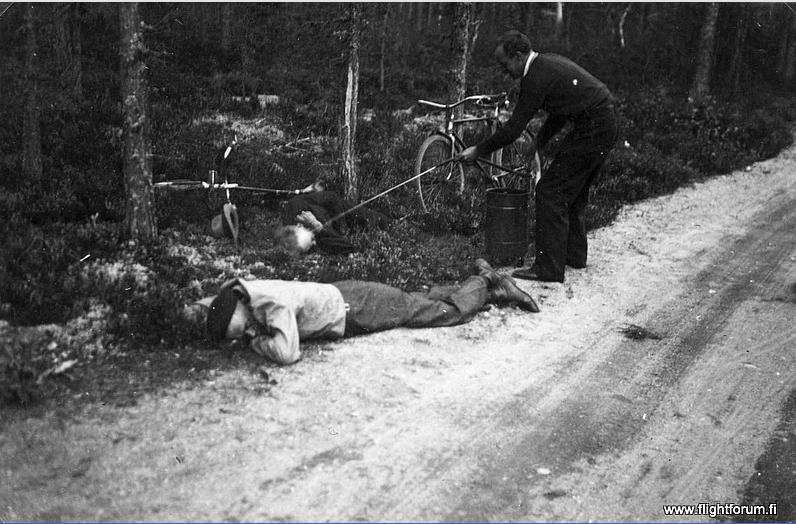
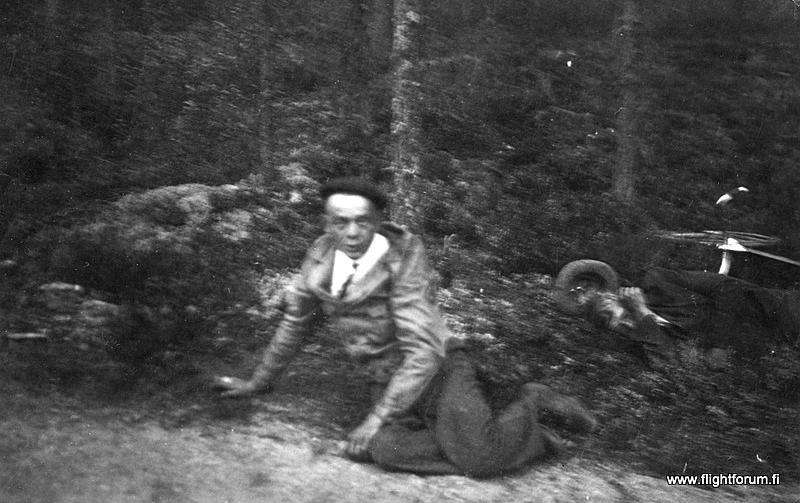
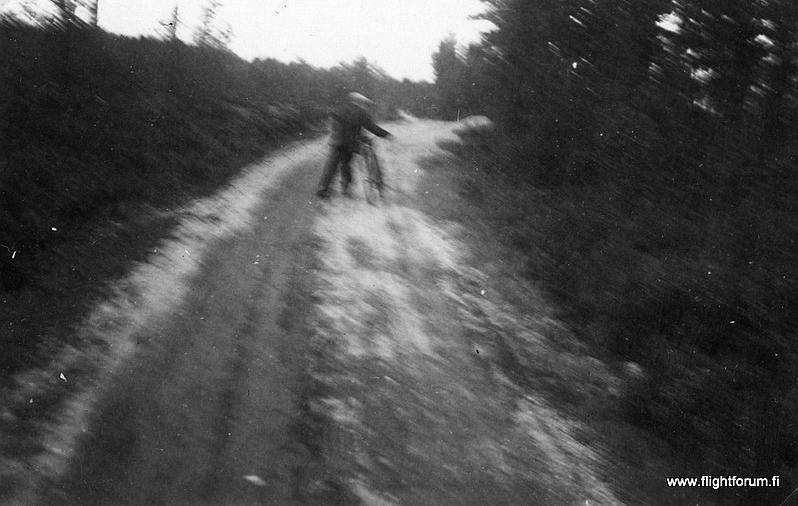
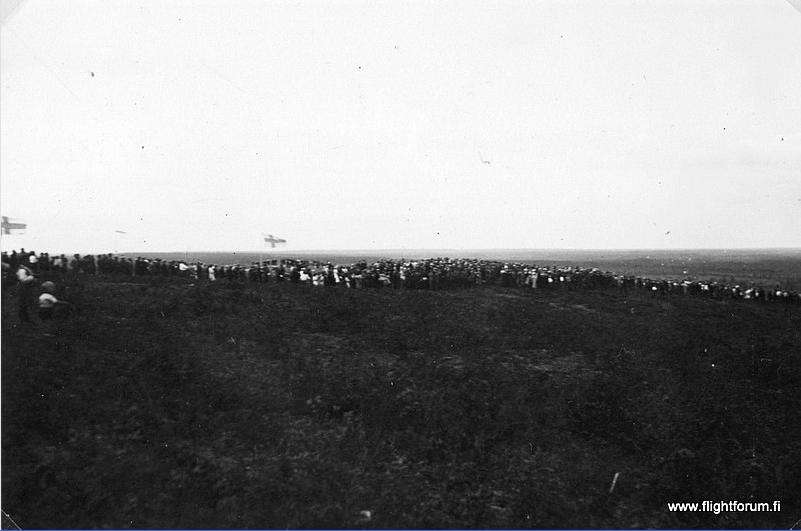
Se suuri lentonäytös "Marskin" läsnäollessa – It is a great Air Show in the presence of the Marshal
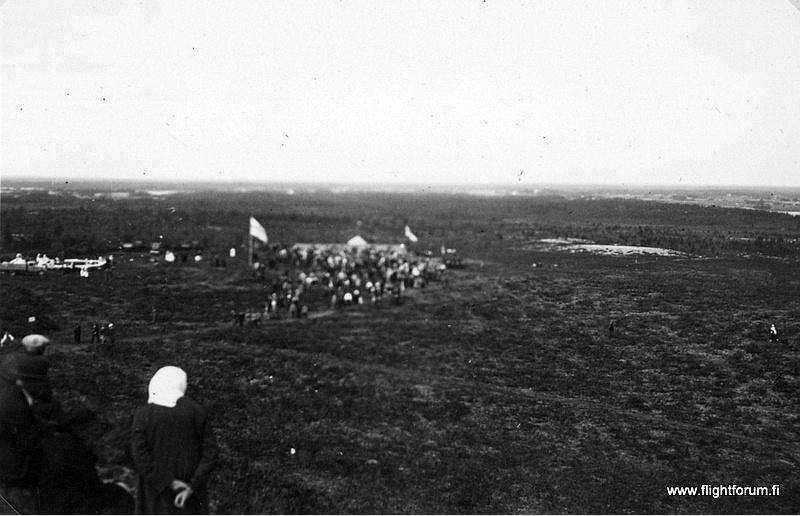
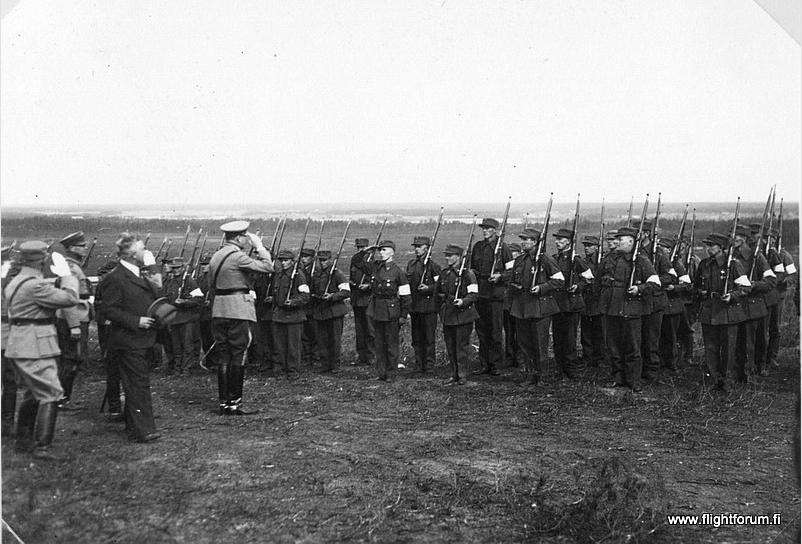
The Marshal inspects the Honor Guard
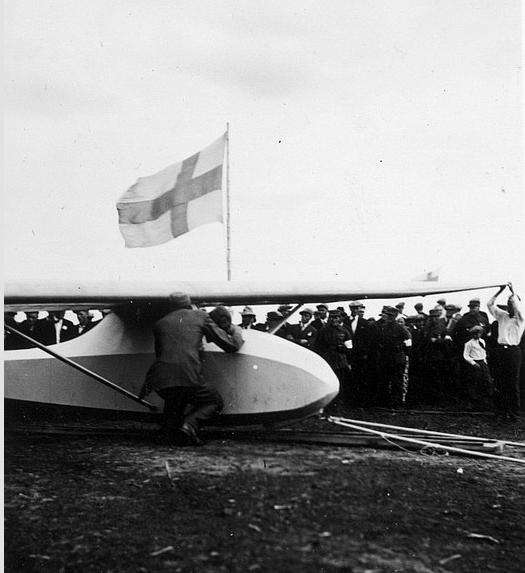
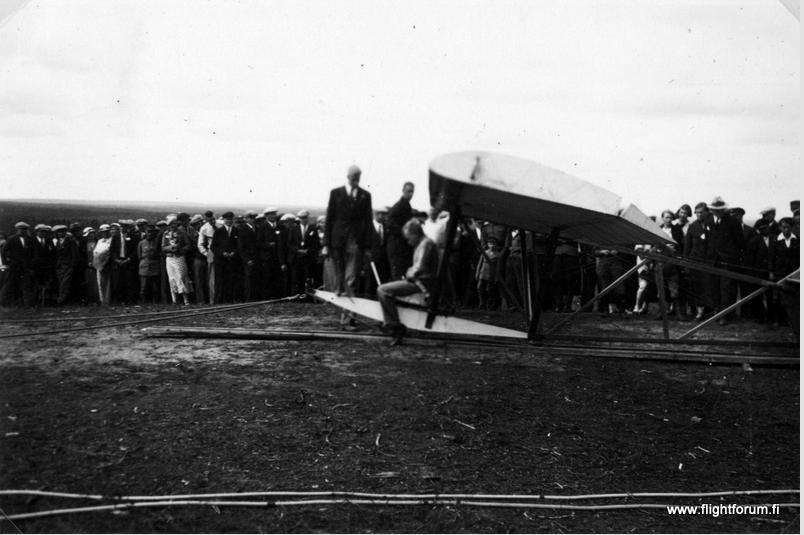
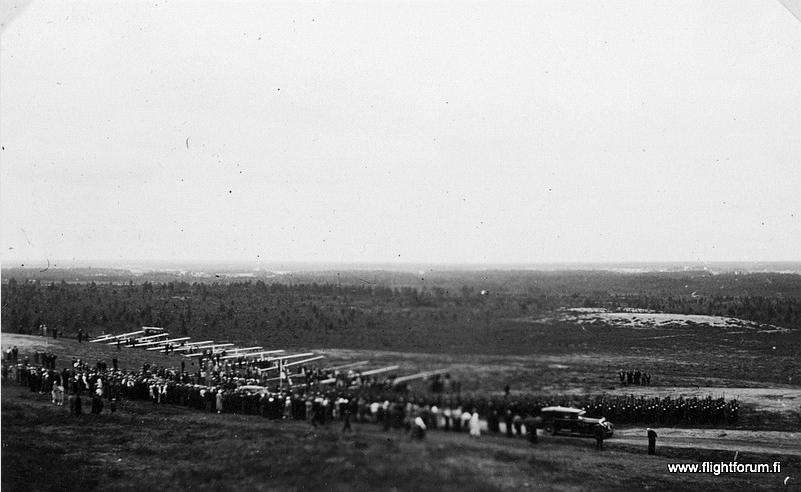

Viimeisen kuvan kone lienee Sääski - The last picture of the machine is probably Sääski.
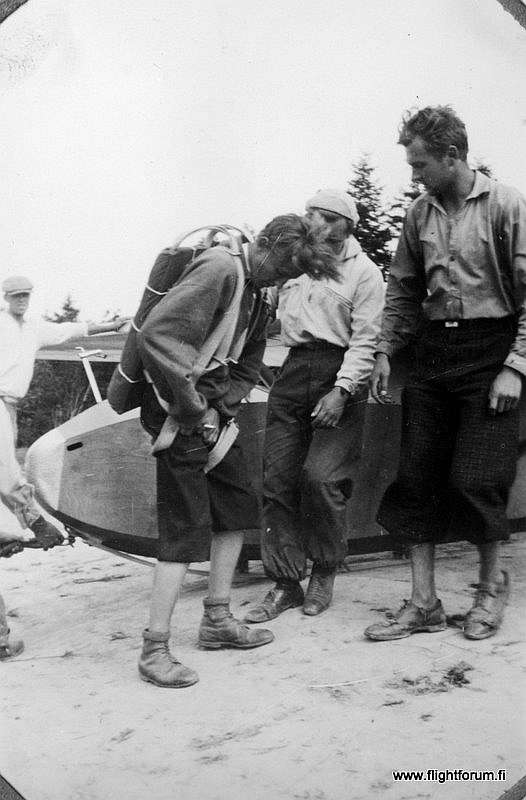
Pentti Kaukonen kertoo kirjassaan "Irti!" sivulla 69, että koululla oli vai neljä laskuvarjoa vuonna 1938 - Pentti Kaukonen says in his book "Irti!" on page 69, that the school had four or parachute in 1938.
This is an extension of the earlier post on the August 1936 Air Show....
The Winch Car
The Winch Car (a Marmon E-75) shown in the photos was originally used by Marshall Mannerheim in the late 1920s and early 1930s. After Mannerheim, the car belonged to a Baron Aminoff. Ten years later, when the Marmon actually was a rather old car, it was donated to an aviation club. They used it to pull gliders up in the air. The big and heavy car with a strong and slowly turning engine was ideal for that purpose. During the war it was stored in a hangar at the airport. This is the story of the car.....
Marmon Cars
Many people have never heard of the MARMON automobile but it was one of the premier vehicles of its time. It was in the class of the Pierce Arrow, Peerless, Lincoln and Packard and was even compared to a Rolls Royce and used by many European royal families. The Marmon Motor Car Company was an automobile manufacturer founded by Howard Marmon and owned by Nordyke Marmon & Company of Indianapolis, Indiana, USA. It was established in 1902 and was merged and renamed in 1933. They produced cars under the Marmon brand. Marmon's parent company was founded in 1851 manufacturing flour grinding mill equipment, and branching out into other machinery through the late 19th century. Small limited production of experimental automobiles began in 1902, with an air-cooled V-twin engine. An air-cooled V4 followed the next year, with pioneering V6 and V8 engines tried over the next few years before more conventional straight engine designs were settled upon. Marmons soon gained a reputation as a reliable, speedy upscale car.
The Model 32 of 1909 spawned the Wasp, winner of the first Indianapolis 500 motor race. This car featured the world's first rear-view mirror. The 1913 Model 48 was a left-hand steering tourer with a cast aluminum body and electric headlights and horn, as well as electric courtesy lights for the dash and doors. The 48 came in a variety of models: two-, four-, five-, or seven-passenger tourers at US$5000, seven-passenger limousine at US$6250, seven-passenger landaulette at US$6350, and seven-passenger Berlin limousine at US$6450. The 1916 Model 34 used an aluminum straight-6, and used aluminum in the body and chassis to reduce overall weight to just 3295 lb (1495 kg). New models were introduced for 1924, replacing the long-lived Model 34, but the company was facing financial trouble, and in 1926 was reorganized as the Marmon Motor Car Co.
In 1929, Marmon introduced an under-$1,000 straight-8 car, the Roosevelt, but the stock market crash of 1929 made the company's problems worse. Howard Marmon had begun working on the world's first V16 engine in 1927, but was unable to complete the production Sixteen until 1931. By that time, Cadillac had already introduced their V-16, designed by ex-Marmon engineer Owen Nacker. Peerless, too, was developing a V16 with help from an ex-Marmon engineer, James Bohannon. Marmon discontinued automobile production in 1933, the worst year of the Great Depression. Marmon was notable as having introduced the rear-view mirror as well as pioneering both the V16 engine and the use of aluminum in auto manufacturing.
Between the years of 1903 and 1933 Marmon Motor Cars (previously Nordyke and Marmon), made approximately 250,000 cars...fewer than 350 exist today. The Model 74 series was produced in 1925 and 1926. It was powered by the six-cylinder engine used in the Model 34. The Model E-75 was introduced in 1927 and produced until 1928; it too was powered by the Model 34 six-cylinder engine. It was fitted with a custom body constructed by the Locke Coachbuilding Company. The Locke company had facilities in New York City and Rochester. The Rochester facility handled mostly convertible bodies as well as series production and they built their bodies atop of many prestigious marque's during their long career, lasting from the early 1900's through 1937. The Great Depression was a difficult time for the company and forced them to close their facilities. From 1932 through 1937, they painted and refurbished cars.
While the Marmon Company discontinued auto production, they continued to manufacture components for other auto manufacturers and manufactured trucks. When the Great Depression drastically reduced the luxury car market, the Marmon Car Company joined forces with Colonel Arthur Herrington, an ex-military engineer involved in the design of all-wheel drive vehicles. The new company was called Marmon-Herrington. Marmon-Herrington got off to a successful start by procuring contracts for military aircraft refueling trucks, 4x4 chassis for towing light weaponry, commercial aircraft refueling trucks, and an order from the Iraqi Pipeline Company for what were the largest trucks ever built at the time. In addition to large commercial and military vehicles, company leaders recognized a growing market for moderately priced all-wheel drive vehicles. This gave birth to the Marmon-Herrington Ford. The installation of all-wheel drive to commercial truck chassis is the primary focus of the Marmon-Herrington Company today. In the early 1960s, Marmon-Herrington was purchased by the Pritzker family and became a member of an association of companies which eventually adopted the name The Marmon Group. In 2007 the Pritzker family sold major part of Group to Warren Buffet's firm Berkshire Hathaway.

Photo taken at the Driving School of V. Gestrin in Helsinki. The first car looks to be a Franklin, second car is a German Wanderer and cars four to six are Benz or Mercedes cars. The car facing front is a Wanderer Puppchen. The big American car third from right is a Marmon Model 34, available from 1916.
Although one article says that the first Marmons were imported to Finland in 1926 by "Autokeskus OY", the Finnish Marmon dealer, the above photo would indicate that at least some Marmon’s were arriving in Finland before this. The technical magazine "Moottori" published a very flattering article of Marmons in August 1926, "Marmon Porvoo." It hailed the Marmon in the following words: "The Marmon's ability to absorb shock was truly amazing, and I agreed to drive the car to Porvoo. Driving the Marmon can be compared to sailing, because the cars movements on uneven surfaces and on sharp corners resembled very much a big sailboat gliding across the sea. Climbing hills presented no challenge and on downhills the car seemed lighter than ordinary."
Alongside the description of the test drive was a photo of the Marmon engine. It clearly showed the oil coolers found in the model E-75. What’s amazing is how the 1927 model, Marmon was test-driven in Finland in the summer of 1926! It seems that as with the new year models of cars today, they went on sale in the autumn of the previous year. In the 1920s and 1930s some 36 Marmons were brought to Finland. Of these, two were the E-75 speedster models with the Locke body. One belonged to a well-known Jyväskyläläiselle Commercial Counsellor Hanna Parviainen, and the second is the one used by Mannerheim.
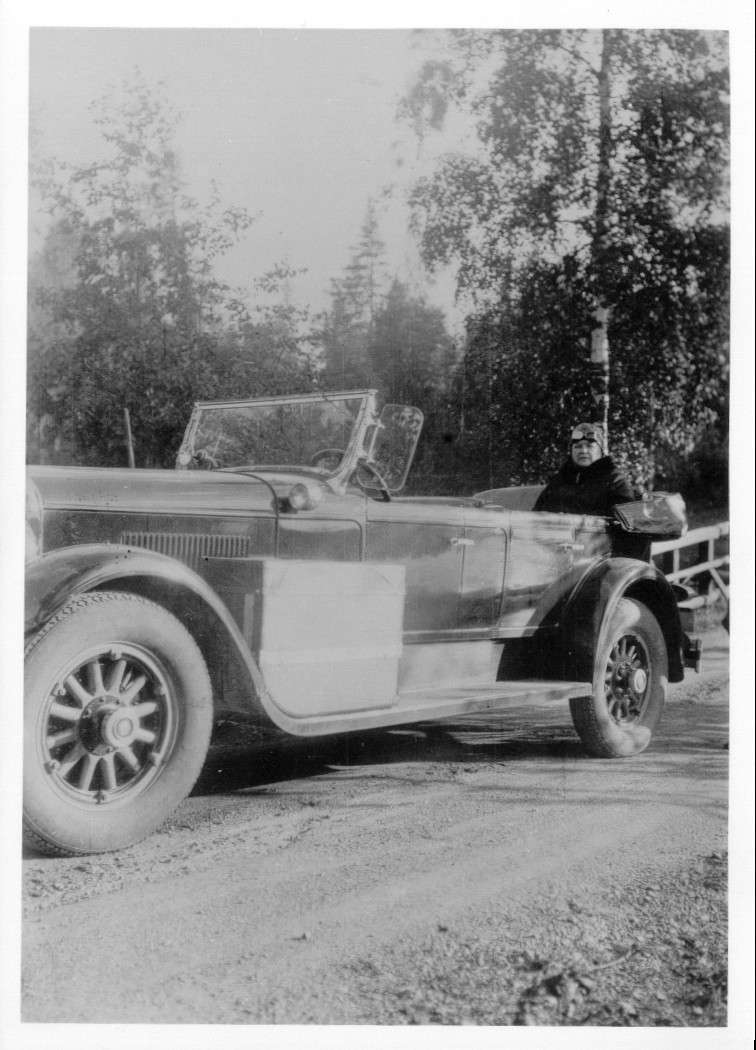
Kauppaneuvos Hanna Parviainen Marmonissaan -30 luvun alussa - Commercial Councillor Hanna Parviainen and her Marmon –In the early 1930’s
In the picture below one can clearly see that the Marmon model featured in the article is an E-75.
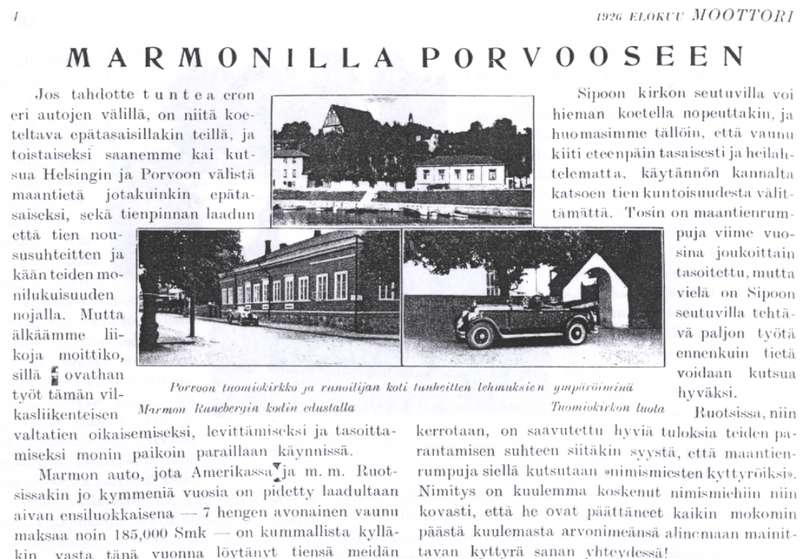
The technical magazine "Moottori" published a very flattering article of Marmons in August 1926, "Marmon Porvoo."
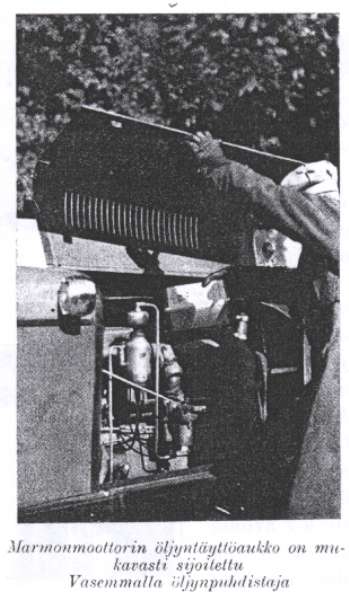
The Oil Purifier, device seen in the middle, was first introduced in the model E-75
The Marmons were known as a very technically advanced car brand. Marmon were early to use engine lubricating oil under pressure, as well as two spark plugs for each cylinder. Today, this "twin spark" ignition is used, for example in the Alfa-Romeo. Marmons were also lighter than other similar cars and therefore achieved a higher performance due to the generous use of aluminum. For example, the engine block was made of aluminum, as were body panels – this at a time when aluminium was rarely used for cars. Marmon was also renowned for its excellent travel comfort and the rare occurrence of tire punctures. In fact, most technical features found in modern cars were invented in the late twenties and these were used in the later Marmons of that period. The Marmon was truly an advanced technology platform of the era and steered lighter and was easier to drive than many of its contemporaries.
The Marmon E-75, 7-passenger Speedster (body by Locke), License Id number 10RA84, was first used by the Marshal of Finland, C.G.E. Mannerheim. After the end of the Civil War and resigning as Regent of Finland, Mannerheim was a civilian and so he had no official car in his use. Even though he had no official position Mannerheim was a very highly respected person and the owner of a large (and still existent) Finnosh Car Dealership, Autokeskus Oy, Lieutenant Fred Geitel, was very good friend of Marshal Mannerheim and generously offered him a car and a driver when ever he wanted. It is somewhat unclear if the Marmon ever really belonged to Mannerheim, but he used it as if it was his own car on his trips around the country and also through Europe including at least one journey to Switzerland.
On the tenth anniversary of the end of the civil war on 16th May 1928, Mannerheim participated in the celebration and in the parade. In the following photos of the event, Mannerheim is seen in the Marmon.
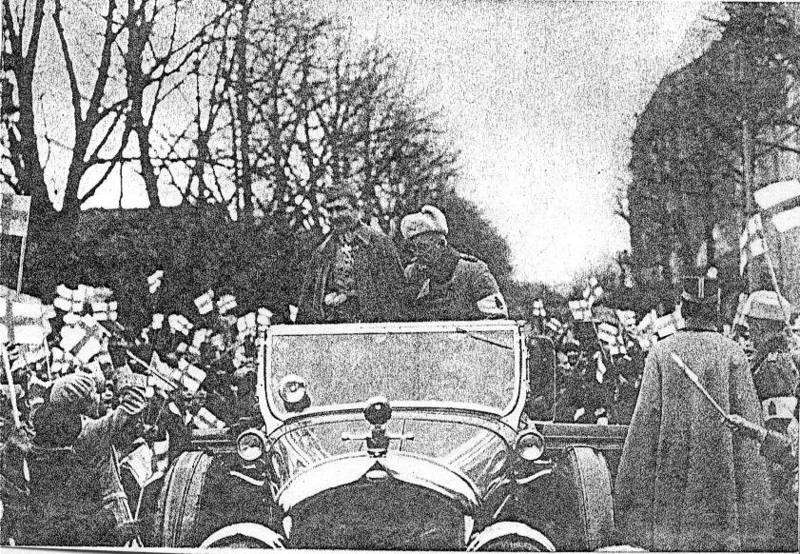
Mannerheim Esplanadilla tervehtimässä yleisöä - Mannerheim greets the crowd
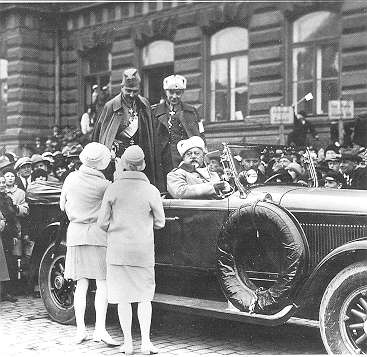
Marsalkka Mannerheim tervehtimässä nuoria neitosia. Vieressä seisomassa kenraali Martin Wetzer. Edessä istumassa kenraali Hannes Ignatius sekä autonkuljettaja Lehtinen tai Tulander (kumpi?). Marshal Mannerheim greets the young maidens. Standing next to him is Gen. Martin Wetzer. Sitting in front is General Hannes Ignatius, as well as a chauffeur, or Tulander Lehtinen (which one?).
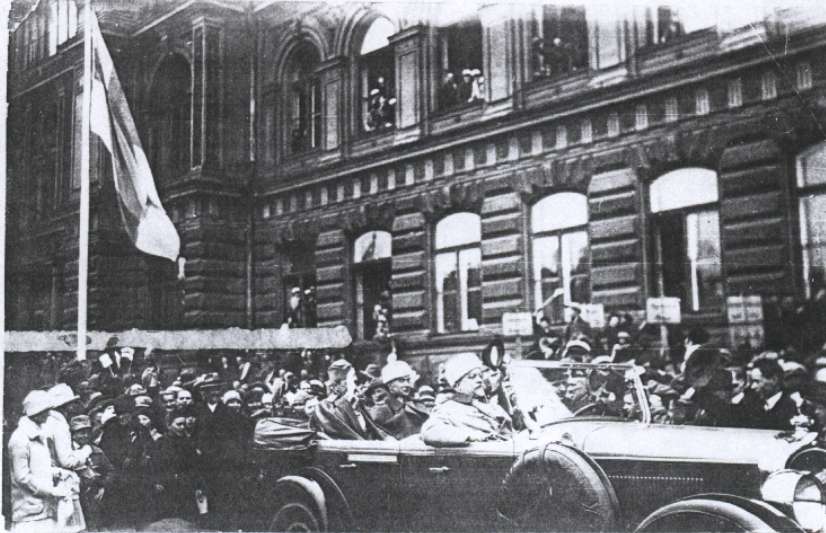
Kuva heti neitosten tervehtimisen jälkeen./ Marshal Mannerheim in the Marmon E-75 in the parade of 16th May 1928 after having been greeted by two young ladies…
The Marmon was specially customized for Marshal Mannerheim. He was a rather tall man and the mounting points for the folding dickey seats were moved in order to provide more room for his legs on long trips (and incidentally less room for his adjutants and for random additional passengers...). Mannerheim was also known as a very accurate and strict person and he always wanted to be aware of the speed and schedule of the trip. Thus an extra speedometer was installed in the passenger compartment and Mannerheim watched this closely, commenting to the driver if he was driving too fast or too slow. Mannerheim had the Marmon treated with special care. On one of his trips to Europe, the journey began with a trip by ship from Helsinki. A tale told by the son of a person who was on the same trip relates how the Mannerheim car (a big sedan) was being loaded when a halyard broke and the car dropped to the ship's deck. Mannerheim was angry, and remained so all the way to Germany.
After Mannerheim, the Marmon was sold to a Baron Aminoff. This phase of the Marmon's history is still obscure but at some stage it is hoped by Finnish restorers working on restoring the car that some light will be shed on this period. In the mid-thirties the Marmon reappears again. A Turku manufacturer, a Mr. Rettig, donated the car to the Turku Flying Club, where it played a part in a film made about gliding, "Karmankolon Kuningas". As a Glider Launcher, the Marmon was undoubtedly an excellent solution with its large and robust engine and huge torque. The following pictures show how the launching was very organized. The car is stationary while the winch drum is fitted on the rear wheel to wind in the tpw rope. The driver takes care of glider towing with the success depending on controlling the speed of winding in the tow rope. The driver also has a cut-out switch, ie the image of which appears as a thin wire, which when pulled drops a weight and a guillotine blade then cuts through the tow rope.
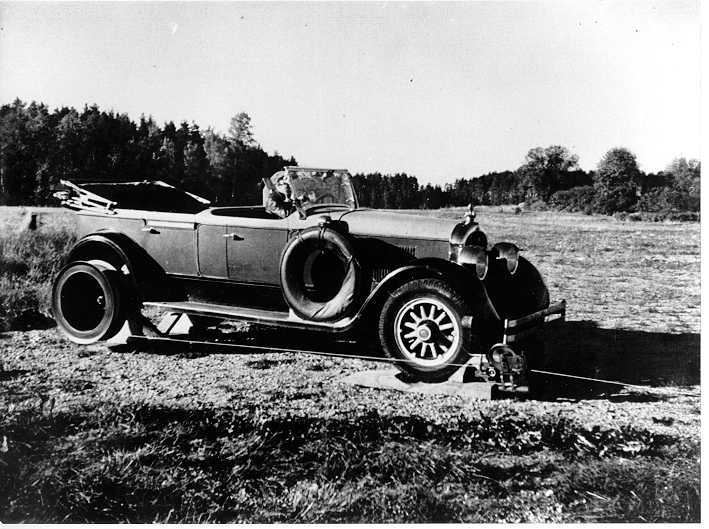
Marmon Turun Artukaisten lentokentällä purjekoneiden hinauslaitteena vuonna 1938 / The Marmon at Turku Artukainen Airport being used as a glider aircraft towing device in 1938.

Yksityiskohtia vinssin kelasta ja hätäkatkaisulaitteesta. / Details of the winch reel and emergency shut down device
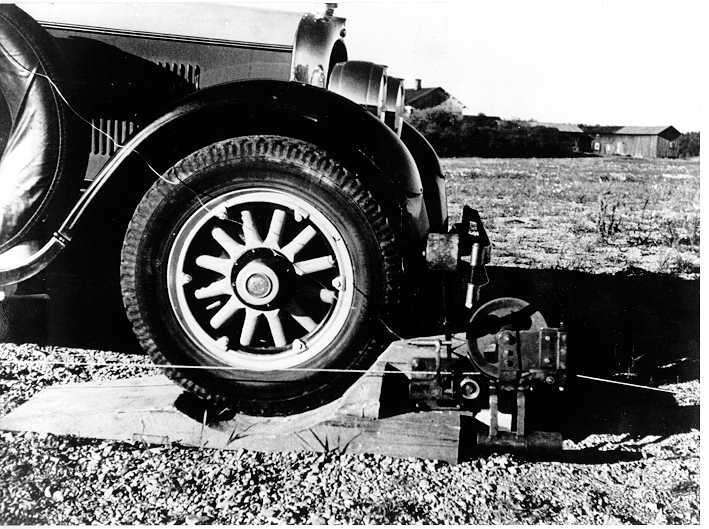
Yksityiskohtia vinssin kelasta ja hätäkatkaisulaitteesta. / Details of the winch reel and emergency shut down device
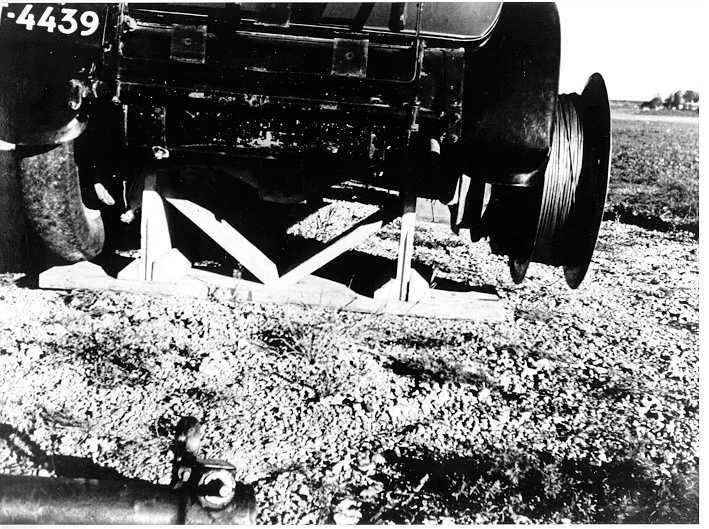
Yksityiskohtia vinssin kelasta ja hätäkatkaisulaitteesta. / Details of the winch reel and emergency shut down device
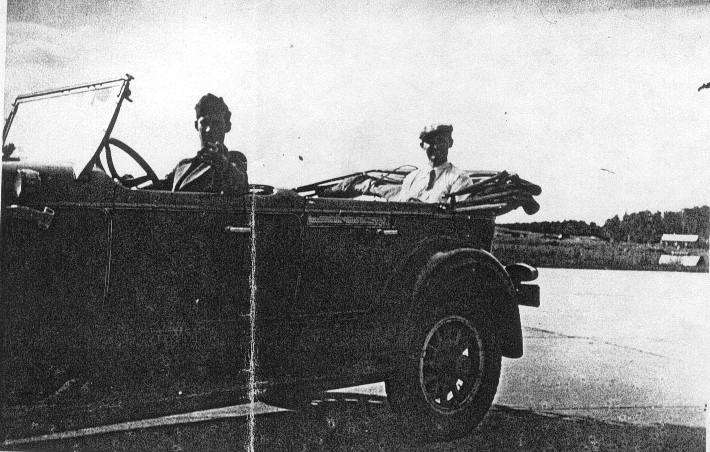
Artukaisten kentällä 1938. Kuljettajana Mikko Moisio, kyydissä istumassa Veikko Linnaluoto / The Marmon at Turku’s Artukainen Airport in 1938. The driver is Mikko Moisio, seated in the rear is Veikko Linnaluoto
A post-war note on the fate of the Marmon
During WW2 the car was stored in a hangar at the airport. After some years - in 1959 - a group of young students from the Helsinki University of Technology bought the Marmon. Every year on the 1st of May the Asociation of Technology Students (SiMiLi) publish a fun magazine called "ÄPY". The Marmon was used to arouse peoples interest when selling these magazines. A large and dark old car was really a head turning sight when roaring down the streets among the small european post-war cars like Fiats and Volkswagens. The Student Union used it also in different kinds of student campaigns and festivals and for driving around just for fun. Maintenance of the old car was rather difficult and time consuming. The radiator was leaking, the water pump had been corroded, the electricity system behaved oddly etc. The students who bought the Marmon graduated and moved away and after a while there was nobody left to take care of the car.
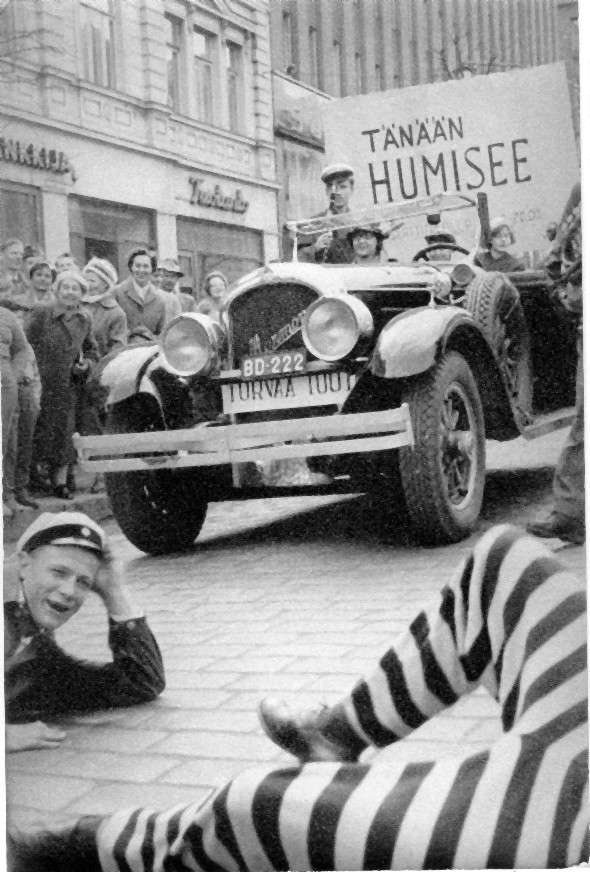
The Marmon in a Student Campaign, "Teekkaritempaus". Year is 1960
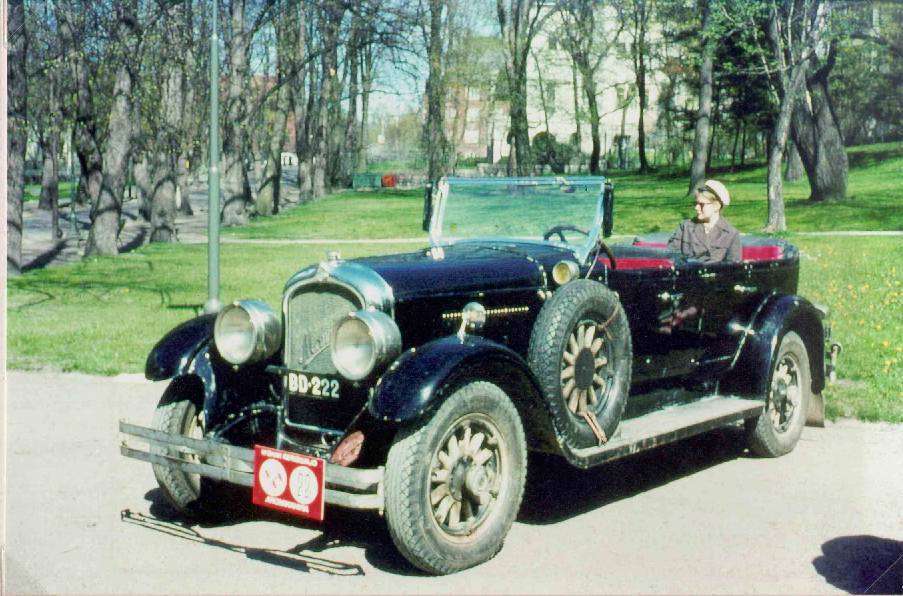
The Marmon in 1965 at restaurant Kaivohuone, Helsinki
The Marmon was just forgotten in a garage and it was removed from the Finnish vehicle register in 1967. Nothing was heard of the Marmon until 1980 when a magazine called "Ratto" published an article "Marshals Car in a Pile of Junk!" That woke up the Espoo Car Museum and they offered Marmon a better place to stay.
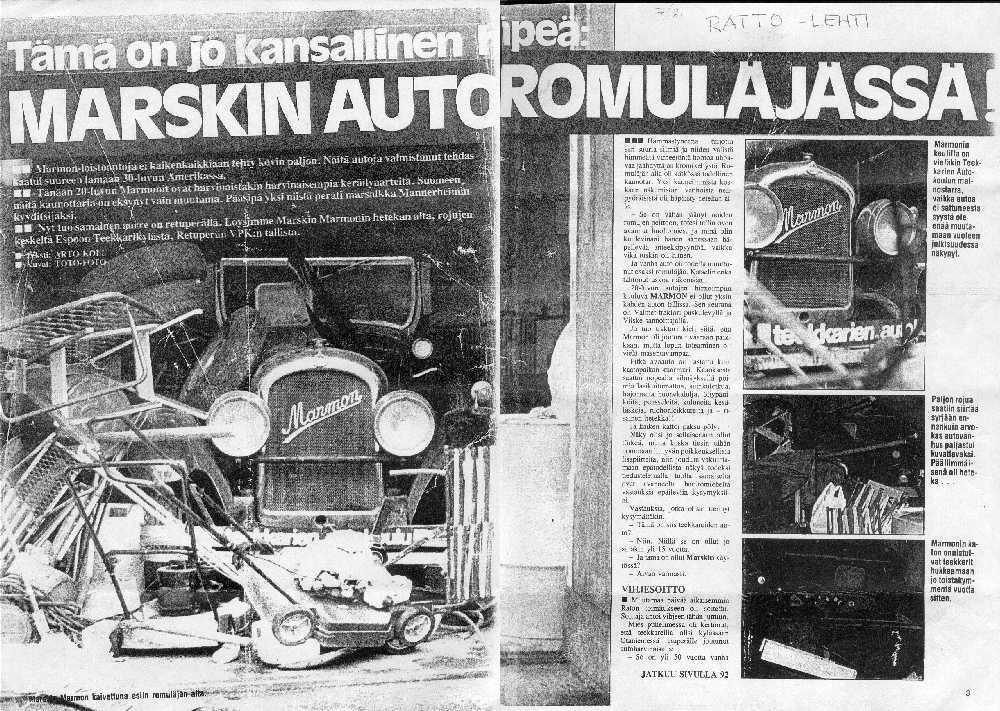
The Marmon in a Pile of Junk. This 1980 article in a Finnish magazine "Ratto" aroused a great concern for the Marmons future among the Students of Technology and so it was hauled of to the Espoo Car Museum where it sat for the next ten years. This is where the where members of the Automobile Club (TAK) of the Helsinki University of Technology found it and began restoration work.
Some ten years later the president of the Automobile Club (TAK) of the Helsinki University of Technology was participating in an automobile club get-together (a discussion about cars, a Finnish sauna and, of course, lots of beer...) where the chief editor of a veteran car magazine gave us a presentation on antique cars. At the end of the presentation he asked us: "...by the way, how is Marshal Mannerheims Marmon doing nowadays? The one that belongs to you students?" The students had to admit that they had never even heard of the car. Then they found the Marmon in the Espoo Car Museum and were really astonished by its majestic looks. After a few more years thinking about the idea of restoring the Marmon they found a suitable garage and some skillful people to do the job and got the Student Unions permission to restore the car.
The project begun by repairing the garage over the winter of 1990-1991. The restoring itself started in the spring 1991. The Marmon was looking pretty good, but when the restoration started, the truth was revealed: the engine worked all right, but the water pump was corroded beyond reparation, the radiator had several leaks, the distributor cap was cracked, and all the moving parts were more or less worn out. When the engine as opened up it was found that all bearings were cracked and worn and somebody had put the pistons in the wrong order. The car had been in an accident at some time and the front end of the chassis was twisted. As a consequence of the accident one of the running boards had been replaced. The interior of the car was made of cheap imitation leather and the canvas top and the top mechanism and many of the smaller parts were missing. The restoreres realized that they had a lot bigger mission ahead of them than they thought when starting the project.
It has taken quite a long time to restore it, but as of 2011 the car has been restored, although some parts are still missing. Go to http://marmon.ayy.fi/Marmon_main.htm for the current status. It’s a fascinating story.
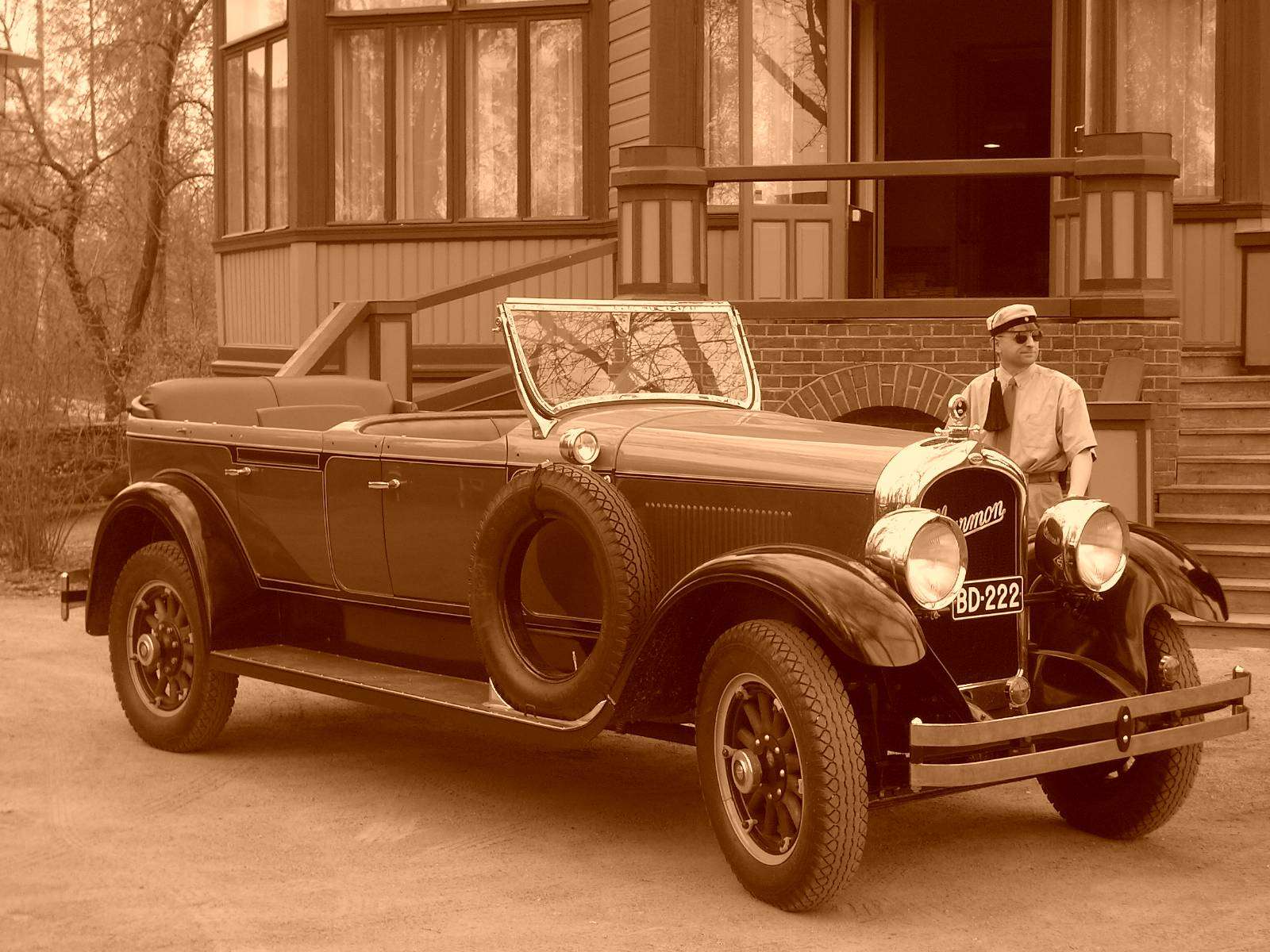
Marshal Mannerheim’s Marmon restored….
That gliding was popular and that these Air Shows were well attended by the public is illustrated by the following Article from the North Satakunta Journal of 15 August 1936 and a series of accompanying photos.
08/14/1936 North Satakunta - Journal
Last Sunday the Jämijärvi Finnish Air Defence League Air Show was held, with Field Marshal Mannerheim as the guest of honor. The Minister of Defence and a number of other high ranking officers were present. The Air Show attracted a crowd of several thousand people. Large numbers of buses, cars, trucks, private cars, motorcycles and bicycles brought spectators to the Show from Tampere, Pori and Helsinki as well as up from Vaasa. Field Marshal Mannerheim, who had spent the previous night in Tampere and left there at 6am in the morning to follow the battle exercises at the Kankaanpää reservist camp, arrived directly from Kankaanpää. He was greeted by the Satakunta Suojeluskuntapiirin Company Honor Guard, the flags of Finland and the Air Defence League and at the same time a small girl gave to the Field Marshal a bouquet of roses.. Also greeting the Marshal were members of the Air Defence Club executive and central committee members.
As well as the presence of Field Marshal Mannerheim and the Defence Minister, those present included the Air Force \Commander, Colonel Guide, Colonel Oar (yleisesikunnasta), Colonel Vinell of the Kankaanpää Training Centre, the Airfield commander, the provincial military commander, Colonel Siilasvuo, everstil. Kari Koski, Aviation relevant rapporteur, the Minister of Transport and Public Works, Ståhle of Aero Oy, Finland Air Defence Central Executive Council members as well as many Air Force officers. The audience was therefore the most representative and authoritative on aviation matters. After the arrival of the Marshal, the official guests moved to a high sand ridge to watch the Glider Air Show, which mainly consisted of glider pilot students flying a variety of glider types. The Chairman of the Gliding Central Committee acted as guide for the Field Marshal.
The Progam included the first use of a rubber rope in combination with a winch car to get the Gliders airborne. This involves a long rubber rope which the machine winch machine uses to sling the glider from the ridge into the air. The automobile takeoff, as it is known, is carried out in such a way that the aircraft nose is attached to a long steel cable. This cable is attached to a drum on the rear wheel which us then quickly wound in, giving the glider the initial velocity to ascend into the air. The towing cable length was 800 meters, the towing cable is quickly wound in, the glider asends and then once in the air above the car the pilots release the wire above the winch machine and continue to fly above the audience. While there were no tow-aircraft available, using this launching apparatus the Pilots were able to achieve as great a height as in the previous years show. The first flight was by Gliding School student Miss Aili Hedstrom (later surname suomalaistettu Heikinaro), a high school student from Vaasa flying the Kuopio Air Defence Association Grünau 9. She flew beautifully above the ridge and then descended back to the place of origin, making beautiful curves above the landscape. This flight, like everyone elses, was well received by the spectators and the Pilot effortlessly landed at the forest edge.
Other flights followed. The next flight, which was fairly long, was carried out in the Satakunta Flying Club machine. The Southern Finland Air Defence League presented to the public an early trainer built by the association, the “Kassel 12”, which is a relatively "old fashioned" model. The Helsinki air defense built Grünau Baby II flew and of course soared the highest, two times more than a basic trainer. Other gliders and pilots flew in Grünau 9’s and Grünau Baby II’s and the last flight was by glider flight chief instructor TB Nissinen who performed an aerobatic show with beautiful looping which attracted a round of applause from the spectators, especially as his starting point for the aerobatics was only 300 metres. The audience viewed the entire show with pleasure, especially as it was performed not by foreign glider pilots but by all Finnish pilots and Finnis enthusiasts who are all volunteers.
Field Marshal Mannerheim, as he left the Show, was given a triple-hurrah by the audience, who then cheered him as he departed. The Air Show went according to plan in every way and the weather was ideal. The Air Show went according to plan in every way, and it was beautiful weather. Catering was provided by the Jämijärvi Lotta women, whose dishes went like hot cakes.
What follows is a series of 47 Photos from an Air Show that I believe is the one reported in the article above from the North Satakunta Journal of 15 August 1936. The captions for the photos are apparantly those written into the original photo album that these were scanned in from. For anyone interested, here’s the link to where I sourced the photos from: http://www.flightforum.fi/forum/index.php/topic,84677.0.html

Valmiina – “Ready”

Veto! – “Pull”

Irti! – “Off”

Köysi irtoaa – “The rope comes off”

Liito – “Glide”

Hinaus takaisin – “Pulling the glider back”
The following photo has no caption…..


Kone suojasta – Protection for the Glider

Hinaus starttipaikalle – “Towing to the Launching Point”

Valmiina! – “Ready!”

Puhelin ilmoitus hinaus paikalle - Telephone notification at the towing scene

Winch Car with the signal flag

Hinausta - Towing

Nousu alkaa! – Liftoff

Silmä tarkkana – Watching closely

Kone nousemassa – Glider is on its own…

Lähellä lakipistetä – In the act of Gliding



Lasku – About to launch

Vaijeri vedetään takaisin – “The Wire is Pulled back”

Sattui sitä vahinkojakin, konerikkoja, mutta muuten vaarattomia – Crashes happen, the Glider gets broken but otherwise no harm







Tässä on PIK:n Grunau Baby OH-PIK3, joka saatiin kesäkuun 1936 alkupäivinä Jämille. Eräs apuopettaja rikkoi koneen rungon 13. lennon päätteeksi.- This is the Grunau Baby PIK3-OH, which was the beginning of June, 1936 Distance to Jämi - one of the auxiliary instructors and teachers broke the fuselage at the end of the flight.


Ittekin tein Komar'illa "kaputin", nokka poikki + nyrjähtänyt nilkka – The Glider is “kaput” – but the pilot only has a sprained ankle



Sattui yleisöllekin "vahinkoja" välistä! Muutamat "väsyneet matkamiehet" virvoitettiin paloruiskulla ja herätys oli hölmöhkö, mutta pystyttiin kuitenkin kotimatkalle – “Damage” also happens to the general public and gliders alike! Some men are “tired of traveling” – but the fire alarm was given and with the help of a good squirt of water, they were assisted on their way home….




Se suuri lentonäytös "Marskin" läsnäollessa – It is a great Air Show in the presence of the Marshal


The Marshal inspects the Honor Guard




Viimeisen kuvan kone lienee Sääski - The last picture of the machine is probably Sääski.

Pentti Kaukonen kertoo kirjassaan "Irti!" sivulla 69, että koululla oli vai neljä laskuvarjoa vuonna 1938 - Pentti Kaukonen says in his book "Irti!" on page 69, that the school had four or parachute in 1938.
This is an extension of the earlier post on the August 1936 Air Show....
The Winch Car
The Winch Car (a Marmon E-75) shown in the photos was originally used by Marshall Mannerheim in the late 1920s and early 1930s. After Mannerheim, the car belonged to a Baron Aminoff. Ten years later, when the Marmon actually was a rather old car, it was donated to an aviation club. They used it to pull gliders up in the air. The big and heavy car with a strong and slowly turning engine was ideal for that purpose. During the war it was stored in a hangar at the airport. This is the story of the car.....
Marmon Cars
Many people have never heard of the MARMON automobile but it was one of the premier vehicles of its time. It was in the class of the Pierce Arrow, Peerless, Lincoln and Packard and was even compared to a Rolls Royce and used by many European royal families. The Marmon Motor Car Company was an automobile manufacturer founded by Howard Marmon and owned by Nordyke Marmon & Company of Indianapolis, Indiana, USA. It was established in 1902 and was merged and renamed in 1933. They produced cars under the Marmon brand. Marmon's parent company was founded in 1851 manufacturing flour grinding mill equipment, and branching out into other machinery through the late 19th century. Small limited production of experimental automobiles began in 1902, with an air-cooled V-twin engine. An air-cooled V4 followed the next year, with pioneering V6 and V8 engines tried over the next few years before more conventional straight engine designs were settled upon. Marmons soon gained a reputation as a reliable, speedy upscale car.
The Model 32 of 1909 spawned the Wasp, winner of the first Indianapolis 500 motor race. This car featured the world's first rear-view mirror. The 1913 Model 48 was a left-hand steering tourer with a cast aluminum body and electric headlights and horn, as well as electric courtesy lights for the dash and doors. The 48 came in a variety of models: two-, four-, five-, or seven-passenger tourers at US$5000, seven-passenger limousine at US$6250, seven-passenger landaulette at US$6350, and seven-passenger Berlin limousine at US$6450. The 1916 Model 34 used an aluminum straight-6, and used aluminum in the body and chassis to reduce overall weight to just 3295 lb (1495 kg). New models were introduced for 1924, replacing the long-lived Model 34, but the company was facing financial trouble, and in 1926 was reorganized as the Marmon Motor Car Co.
In 1929, Marmon introduced an under-$1,000 straight-8 car, the Roosevelt, but the stock market crash of 1929 made the company's problems worse. Howard Marmon had begun working on the world's first V16 engine in 1927, but was unable to complete the production Sixteen until 1931. By that time, Cadillac had already introduced their V-16, designed by ex-Marmon engineer Owen Nacker. Peerless, too, was developing a V16 with help from an ex-Marmon engineer, James Bohannon. Marmon discontinued automobile production in 1933, the worst year of the Great Depression. Marmon was notable as having introduced the rear-view mirror as well as pioneering both the V16 engine and the use of aluminum in auto manufacturing.
Between the years of 1903 and 1933 Marmon Motor Cars (previously Nordyke and Marmon), made approximately 250,000 cars...fewer than 350 exist today. The Model 74 series was produced in 1925 and 1926. It was powered by the six-cylinder engine used in the Model 34. The Model E-75 was introduced in 1927 and produced until 1928; it too was powered by the Model 34 six-cylinder engine. It was fitted with a custom body constructed by the Locke Coachbuilding Company. The Locke company had facilities in New York City and Rochester. The Rochester facility handled mostly convertible bodies as well as series production and they built their bodies atop of many prestigious marque's during their long career, lasting from the early 1900's through 1937. The Great Depression was a difficult time for the company and forced them to close their facilities. From 1932 through 1937, they painted and refurbished cars.
While the Marmon Company discontinued auto production, they continued to manufacture components for other auto manufacturers and manufactured trucks. When the Great Depression drastically reduced the luxury car market, the Marmon Car Company joined forces with Colonel Arthur Herrington, an ex-military engineer involved in the design of all-wheel drive vehicles. The new company was called Marmon-Herrington. Marmon-Herrington got off to a successful start by procuring contracts for military aircraft refueling trucks, 4x4 chassis for towing light weaponry, commercial aircraft refueling trucks, and an order from the Iraqi Pipeline Company for what were the largest trucks ever built at the time. In addition to large commercial and military vehicles, company leaders recognized a growing market for moderately priced all-wheel drive vehicles. This gave birth to the Marmon-Herrington Ford. The installation of all-wheel drive to commercial truck chassis is the primary focus of the Marmon-Herrington Company today. In the early 1960s, Marmon-Herrington was purchased by the Pritzker family and became a member of an association of companies which eventually adopted the name The Marmon Group. In 2007 the Pritzker family sold major part of Group to Warren Buffet's firm Berkshire Hathaway.

Photo taken at the Driving School of V. Gestrin in Helsinki. The first car looks to be a Franklin, second car is a German Wanderer and cars four to six are Benz or Mercedes cars. The car facing front is a Wanderer Puppchen. The big American car third from right is a Marmon Model 34, available from 1916.
Although one article says that the first Marmons were imported to Finland in 1926 by "Autokeskus OY", the Finnish Marmon dealer, the above photo would indicate that at least some Marmon’s were arriving in Finland before this. The technical magazine "Moottori" published a very flattering article of Marmons in August 1926, "Marmon Porvoo." It hailed the Marmon in the following words: "The Marmon's ability to absorb shock was truly amazing, and I agreed to drive the car to Porvoo. Driving the Marmon can be compared to sailing, because the cars movements on uneven surfaces and on sharp corners resembled very much a big sailboat gliding across the sea. Climbing hills presented no challenge and on downhills the car seemed lighter than ordinary."
Alongside the description of the test drive was a photo of the Marmon engine. It clearly showed the oil coolers found in the model E-75. What’s amazing is how the 1927 model, Marmon was test-driven in Finland in the summer of 1926! It seems that as with the new year models of cars today, they went on sale in the autumn of the previous year. In the 1920s and 1930s some 36 Marmons were brought to Finland. Of these, two were the E-75 speedster models with the Locke body. One belonged to a well-known Jyväskyläläiselle Commercial Counsellor Hanna Parviainen, and the second is the one used by Mannerheim.

Kauppaneuvos Hanna Parviainen Marmonissaan -30 luvun alussa - Commercial Councillor Hanna Parviainen and her Marmon –In the early 1930’s
In the picture below one can clearly see that the Marmon model featured in the article is an E-75.

The technical magazine "Moottori" published a very flattering article of Marmons in August 1926, "Marmon Porvoo."

The Oil Purifier, device seen in the middle, was first introduced in the model E-75
The Marmons were known as a very technically advanced car brand. Marmon were early to use engine lubricating oil under pressure, as well as two spark plugs for each cylinder. Today, this "twin spark" ignition is used, for example in the Alfa-Romeo. Marmons were also lighter than other similar cars and therefore achieved a higher performance due to the generous use of aluminum. For example, the engine block was made of aluminum, as were body panels – this at a time when aluminium was rarely used for cars. Marmon was also renowned for its excellent travel comfort and the rare occurrence of tire punctures. In fact, most technical features found in modern cars were invented in the late twenties and these were used in the later Marmons of that period. The Marmon was truly an advanced technology platform of the era and steered lighter and was easier to drive than many of its contemporaries.
The Marmon E-75, 7-passenger Speedster (body by Locke), License Id number 10RA84, was first used by the Marshal of Finland, C.G.E. Mannerheim. After the end of the Civil War and resigning as Regent of Finland, Mannerheim was a civilian and so he had no official car in his use. Even though he had no official position Mannerheim was a very highly respected person and the owner of a large (and still existent) Finnosh Car Dealership, Autokeskus Oy, Lieutenant Fred Geitel, was very good friend of Marshal Mannerheim and generously offered him a car and a driver when ever he wanted. It is somewhat unclear if the Marmon ever really belonged to Mannerheim, but he used it as if it was his own car on his trips around the country and also through Europe including at least one journey to Switzerland.
On the tenth anniversary of the end of the civil war on 16th May 1928, Mannerheim participated in the celebration and in the parade. In the following photos of the event, Mannerheim is seen in the Marmon.

Mannerheim Esplanadilla tervehtimässä yleisöä - Mannerheim greets the crowd

Marsalkka Mannerheim tervehtimässä nuoria neitosia. Vieressä seisomassa kenraali Martin Wetzer. Edessä istumassa kenraali Hannes Ignatius sekä autonkuljettaja Lehtinen tai Tulander (kumpi?). Marshal Mannerheim greets the young maidens. Standing next to him is Gen. Martin Wetzer. Sitting in front is General Hannes Ignatius, as well as a chauffeur, or Tulander Lehtinen (which one?).

Kuva heti neitosten tervehtimisen jälkeen./ Marshal Mannerheim in the Marmon E-75 in the parade of 16th May 1928 after having been greeted by two young ladies…
The Marmon was specially customized for Marshal Mannerheim. He was a rather tall man and the mounting points for the folding dickey seats were moved in order to provide more room for his legs on long trips (and incidentally less room for his adjutants and for random additional passengers...). Mannerheim was also known as a very accurate and strict person and he always wanted to be aware of the speed and schedule of the trip. Thus an extra speedometer was installed in the passenger compartment and Mannerheim watched this closely, commenting to the driver if he was driving too fast or too slow. Mannerheim had the Marmon treated with special care. On one of his trips to Europe, the journey began with a trip by ship from Helsinki. A tale told by the son of a person who was on the same trip relates how the Mannerheim car (a big sedan) was being loaded when a halyard broke and the car dropped to the ship's deck. Mannerheim was angry, and remained so all the way to Germany.
After Mannerheim, the Marmon was sold to a Baron Aminoff. This phase of the Marmon's history is still obscure but at some stage it is hoped by Finnish restorers working on restoring the car that some light will be shed on this period. In the mid-thirties the Marmon reappears again. A Turku manufacturer, a Mr. Rettig, donated the car to the Turku Flying Club, where it played a part in a film made about gliding, "Karmankolon Kuningas". As a Glider Launcher, the Marmon was undoubtedly an excellent solution with its large and robust engine and huge torque. The following pictures show how the launching was very organized. The car is stationary while the winch drum is fitted on the rear wheel to wind in the tpw rope. The driver takes care of glider towing with the success depending on controlling the speed of winding in the tow rope. The driver also has a cut-out switch, ie the image of which appears as a thin wire, which when pulled drops a weight and a guillotine blade then cuts through the tow rope.

Marmon Turun Artukaisten lentokentällä purjekoneiden hinauslaitteena vuonna 1938 / The Marmon at Turku Artukainen Airport being used as a glider aircraft towing device in 1938.

Yksityiskohtia vinssin kelasta ja hätäkatkaisulaitteesta. / Details of the winch reel and emergency shut down device

Yksityiskohtia vinssin kelasta ja hätäkatkaisulaitteesta. / Details of the winch reel and emergency shut down device

Yksityiskohtia vinssin kelasta ja hätäkatkaisulaitteesta. / Details of the winch reel and emergency shut down device

Artukaisten kentällä 1938. Kuljettajana Mikko Moisio, kyydissä istumassa Veikko Linnaluoto / The Marmon at Turku’s Artukainen Airport in 1938. The driver is Mikko Moisio, seated in the rear is Veikko Linnaluoto
A post-war note on the fate of the Marmon
During WW2 the car was stored in a hangar at the airport. After some years - in 1959 - a group of young students from the Helsinki University of Technology bought the Marmon. Every year on the 1st of May the Asociation of Technology Students (SiMiLi) publish a fun magazine called "ÄPY". The Marmon was used to arouse peoples interest when selling these magazines. A large and dark old car was really a head turning sight when roaring down the streets among the small european post-war cars like Fiats and Volkswagens. The Student Union used it also in different kinds of student campaigns and festivals and for driving around just for fun. Maintenance of the old car was rather difficult and time consuming. The radiator was leaking, the water pump had been corroded, the electricity system behaved oddly etc. The students who bought the Marmon graduated and moved away and after a while there was nobody left to take care of the car.

The Marmon in a Student Campaign, "Teekkaritempaus". Year is 1960

The Marmon in 1965 at restaurant Kaivohuone, Helsinki
The Marmon was just forgotten in a garage and it was removed from the Finnish vehicle register in 1967. Nothing was heard of the Marmon until 1980 when a magazine called "Ratto" published an article "Marshals Car in a Pile of Junk!" That woke up the Espoo Car Museum and they offered Marmon a better place to stay.

The Marmon in a Pile of Junk. This 1980 article in a Finnish magazine "Ratto" aroused a great concern for the Marmons future among the Students of Technology and so it was hauled of to the Espoo Car Museum where it sat for the next ten years. This is where the where members of the Automobile Club (TAK) of the Helsinki University of Technology found it and began restoration work.
Some ten years later the president of the Automobile Club (TAK) of the Helsinki University of Technology was participating in an automobile club get-together (a discussion about cars, a Finnish sauna and, of course, lots of beer...) where the chief editor of a veteran car magazine gave us a presentation on antique cars. At the end of the presentation he asked us: "...by the way, how is Marshal Mannerheims Marmon doing nowadays? The one that belongs to you students?" The students had to admit that they had never even heard of the car. Then they found the Marmon in the Espoo Car Museum and were really astonished by its majestic looks. After a few more years thinking about the idea of restoring the Marmon they found a suitable garage and some skillful people to do the job and got the Student Unions permission to restore the car.
The project begun by repairing the garage over the winter of 1990-1991. The restoring itself started in the spring 1991. The Marmon was looking pretty good, but when the restoration started, the truth was revealed: the engine worked all right, but the water pump was corroded beyond reparation, the radiator had several leaks, the distributor cap was cracked, and all the moving parts were more or less worn out. When the engine as opened up it was found that all bearings were cracked and worn and somebody had put the pistons in the wrong order. The car had been in an accident at some time and the front end of the chassis was twisted. As a consequence of the accident one of the running boards had been replaced. The interior of the car was made of cheap imitation leather and the canvas top and the top mechanism and many of the smaller parts were missing. The restoreres realized that they had a lot bigger mission ahead of them than they thought when starting the project.
It has taken quite a long time to restore it, but as of 2011 the car has been restored, although some parts are still missing. Go to http://marmon.ayy.fi/Marmon_main.htm for the current status. It’s a fascinating story.

Marshal Mannerheim’s Marmon restored….
Last edited:
The 1933 Ilmavoimat Procurement Program
The 1933 Ilmavoimat Purchase Program
Again in 1933, the procurement program emphasised the purchase of trainers and fighters. A high priority had been given to the continual acquisition of modern fighter aircraft – and with no attempts to compromise by ordering aircraft with multiple capabilities. Even in the early 1930’s, it was envisaged that any war with the Soviet Union would involve the Red Air Force attacking Douhet-style with waves of unescorted bombers and the counter would thus be Fighter aircraft. Conversely, Finland’s small population and economy could never support the number of bomber aircraft necessary for a Douhet-style bombing campaign against any enemy, let alone the Soviet Union – strategic bombing was therefore eschewed from the start and where the Ilmavoimat selected bomber aircraft, the primary emphasis was to be on support for the Maavoimat and Merivoimat – and with a marked emphasis on the capability to carry out accurate ground attack bombing.
Trials carried out had long concluded that high altitude bombing from level flight was wildly inaccurate and the Ilmavoimat would never have enough aircraft to carry out effective area-saturation bombing as Douhet and his disciples advocated. On the other hand, in the evaluation trials with the Curtiss Helldivers, the Ilmavoimat had established that it was possible to accurately aim for and hit small targets. Accurate low-level bombing was also achievable with training and practice, but again this was more suitable for attacking specific targets rather than saturation bombing – and also could be carried out with small numbers of aircraft. Provision had been made for the purchase of bomber-types in the five year plan and it was decided that the 1933 procurement program would include a capable medium bomber, which would then be extensively tested in combined arms and tactical bombing exercises and evaluated for effectiveness.
As a result, in 1933 and with the Curtiss Helldivers already ordered, the Ilmavoimat opted to purchase a limited number of medium bombers, additional fighters and the new Finnish-design Tuiska Advance Trainer.
VL Tuiska Advanced Trainers – 40 ordered in late 1933 (an additional 40 were ordered in 1935)
The VL Tuisku (Snowstorm) was a Finnish-design two-seat mixed structure (welded steel framework covered with fabric) biplane with a fixed undercarriage designed as an advanced trainer aircraft with fixed undercarriage. The Designer was Arvo Ylinen (who was in 1933 the chief designer at Valtion Lentokonetehdas). As an Advanced Fighter Trainer, the first prototype was ordered from VL in January 1933. The first test flights for this aircraft were performed over spring 1933 by Lieutenant U.E. Mäkelä. The prototype broke up in the early test flights due to flutter developing – Lieutenant Mäkelä parachuted to safety. The problem was identified and eliminated for the second prototype, which was ready in early summer 1933. The test flight program was completed by 5 September, 1933. Overall, the aircrafts flying characteristics were considered to be excellent.
Immediately after the completion of the test flight program, an order was placed with VL for 40 aircraft. Construction began immediately with delivery taking place over summer 1934 and into early 1935. As an advanced trainer, the VL Tuiska proved to be a success. A second production series for an additional 40 aircraft was ordered on 14 Feb, 1935. These aircraft were delivered over mid 1935 to mid 1936. Three different versions of the aircraft were constructed: a maritime training, a pilot training and a reconnaissance training version, with the numbers being approximately equally distributed between the types. The Tuiska remained in use as an Advanced Trainer until 1950. The Tuiska was fitted with 2x7.62mm machineguns and could carry 4 x12.5 to 23kg bombs.
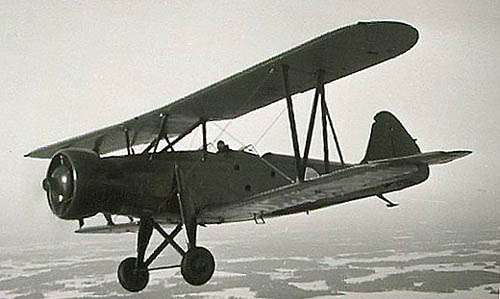
Ilmavoimat VL Tuisku in flight – as well as being used for Training, the aircraft could be used for Reconnaisance. With a crew of 2 (Instructor and Trainee) the Tuisku was powered by a single aircooled Armstrong Siddeley Lynx IVC 7-cylinder radial, 160 kW (215 hp) giving a maximum speed of 129mph, a range of 715 miles and had a service ceiling of 14,436 feet.
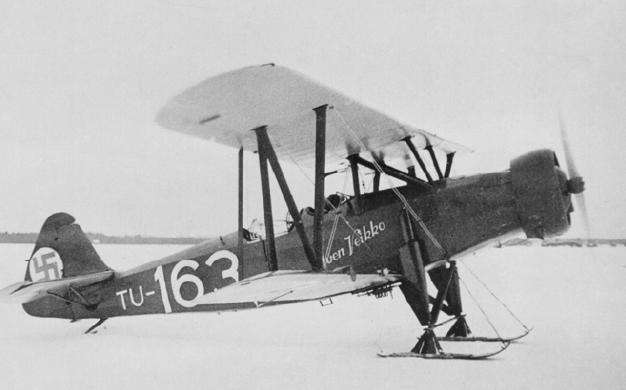
The aircraft proved a reliable and cost-effective platform in a wide variety of roles, and the Tuisku ("Snowstorm") can be regarded as one of the most successful aircraft types designed in Finland. It made a significant contribution to the development of the Ilmavoimat in the 1930s.
OTL Note: OTL, the first prototype was ordered from the State Aircraft Factory in the spring of 1933. The first flight for this aircraft was performed on 10 Jan, 1934. The second prototype was ready in the beginning of 1935 and the test flight program was finished by 5 Feb, 1935. 12 aircraft were ordered in the same month. They were delivered in the summer of 1936. One additional Tuisku was donated to the Air Force on 19 Apr, 1936. A second production series was ordered on 14 Feb, 1936. These 16 aircraft were delivered in 1937. Again one additional aircraft was donated to the Air Force. One Tuisku, named "Sokeri-Sirkku" (TU-178) is preserved and on display at the air museum in Vantaa. The fuselage of TU-169 is preserved in the museum's storage facilities. A Tuisku is also on display in front of the old State Aircraft Factory in Tampere.
Fairey Firefly II Biplane Fighter – 25 ordered early 1933, retired 1940
The earlier purchase of the Bristol Bulldog Fighter had proved to be a success, and this influenced the decision to but a further and more modern Fighter aircraft from Britain. The Ilmavoimat and VL evaluated both the new British Fighters that had been developed in response the the UK Air Ministry Specification F.20/27 for a single-seat interceptor. The Fiat CR.30 was also evaluated but was not as fast, although it had double the range. The Firefly II competed for the RAF contract against the Hawker Fury, showing superior speed but was criticised for having heavier controls. Crucially, it retained a mainly wooden structure despite the UK Air Ministry's demands for metal structures. In the UK, this led to the Fury being selected. VL however preferred the wooden structure – this was technology they were used to working with and while they were working to build up experience with the new metal structural technology, this was as yet not a strong point. The Firefly was also somewhat cheaper and, crucially, faster. The Procurement Team therefore opted for the purchase of the Firefly II. In hindsight, this was probably not an “ideal” choice, but the Firefly did prove to be an adequate fighter, if outdated by the time of the Winter War.
The Finnish order for 25 Firefly II’s was placed at the end of the first quarter of 1933, with Fairey’s UK factory building the aircraft. They were delivered to Finland six months later, assembled and tested over the winter and entered service with the Ilmavoimat in March 1934. As with the Bristol Bulldog, with Firefly II was utilised as a fighter in the Winter War, with limited success. It was relegated to use as an Advanced Fighter Trainer in early 1940 as new Fighters became available and entered service.
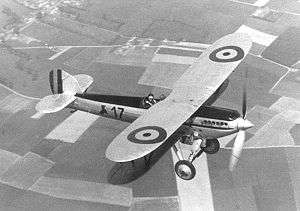
The Fairey Firefly II was a good high-speed interceptor Fighter in its day, albeit with limited range. With a maximum speed of 223mph at 13,000 feet, it had a range of 240 miles and a service ceiling of 30,840 feet. A single seater, it was armed with 2 × 0.303 in (7.7 mm) Vickers machine guns.
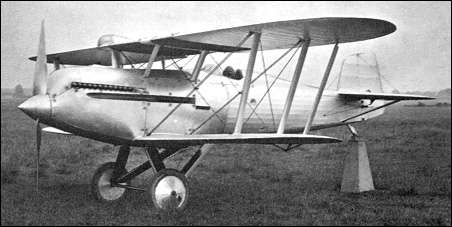
Fairey Firefly II on display
OTL Note: The Firefly was a private-venture design, penned by Marcel Lobelle. A contract was won for 25 IIM aircraft for Belgium's Aéronautique Militaire, followed by a contract for a further 62 to be constructed by Avions Fairey, Fairey's Belgian subsidiary. The Belgian aircraft served briefly in the Second World War from May to June 1940. Two of the Belgian aircraft were converted to Firefly IV, with 785 hp (585 kW) Hispano-Suiza 12Xbrs engines but the improvement was not deemed sufficient to warrant development. One was restored to its original form, while the other passed to Fairey for trials. One aircraft was supplied to the Soviet Union.
Hawker Hart Light Bomber – 20 ordered mid-1933, retired 1943
After an assessment of light and medium bombers available, the Procurement Team settled in early 1933 on the British Hawker Hart Light Bomber. An evaluation aircraft was ordered and after delivery in April, an extensive evaluation program was flown over May and June 1933. The results were such that an immediate order was placed for 20 of the aircraft, with delivery confirmed for late 1933. The Hart’s delivery was delayed due to the large number of orders that had been received for the aircraft, with delivery actually taking place in early 1934.
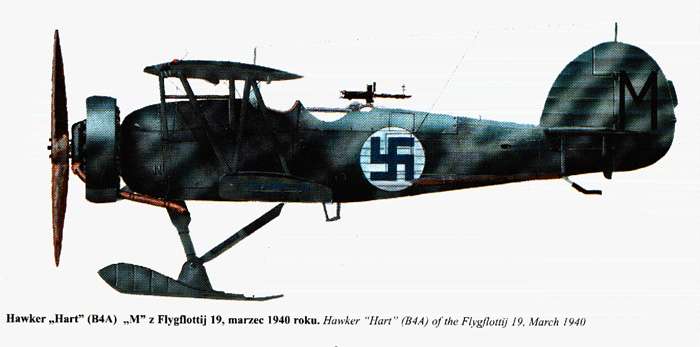
Ilmavoimat Hawker Hart
The Hawker Hart was a British two-seater biplane light bomber of the Royal Air Force (RAF), which had a prominent role during the RAF's inter-war period. The Hart was designed during the 1920s by Sydney Camm in response to a 1926 UK Air Ministry requirement for for a two-seat high-performance light day-bomber, to be of all-metal construction and with a maximum speed of 160 mph (258 km/h). Designs were tendered by Hawker, Avro and de Havilland. Fairey, who had sold a squadron's worth of its wooden Fox bomber in 1925, was not at first invited to tender to the specification, and was only sent a copy of the specification after protesting to the Chief of the Air Staff, Hugh Trenchard.
Hawker's design was a single-bay biplane powered by a Rolls-Royce F.XI water-cooled V12 engine (the engine that later became known as the Rolls-Royce Kestrel). It had, as the specification required, a metal structure, with a fuselage structure of steel-tube covered by aluminium panels and fabric, with the wings having steel spars and duralumin ribs, covered in fabric. The crew of two sat in individual tandem cockpits, with the pilot sitting under the wing trailing edge, and operating a single .303 in (7.7 mm) Vickers machine gun mounted on the port side of the cockpit. The observer sat behind the pilot, and was armed with a single Lewis gun on a ring mount, while for bomb-aiming, he lay prone under the pilots seat. Up to 520 pounds (240 kg) of bombs could be carried under the aircraft's wings.
The prototype Hart first flew in June 1928 and demonstrated good performance and handling, reaching 176 mph (283 km/h) in level flight and 282 mph (454 km/h) in a vertical dive. The competition culminated in the choice of the Hawker Hart by the UK Air Ministry in April 1929. Of its competitors, the de Havilland Hound was rejected due to handling problems during landing and because of its part-wooden primary structure. While the Avro Antelope demonstrated similar performance and good handling, the Hart was preferred as it was far cheaper to maintain, a vital aspect to a programme during defence budget constraints that the British armed forces faced during the 1920s. The Fairey Fox IIM (which despite the name was effectively an all-new aircraft), delayed by Fairey's late start on the design compared to the other competitors, only flew for the first time on 25 October 1929, long after the Hart had been selected.
The production Hart day bomber had a single 525 hp (390 kW) Rolls-Royce Kestrel IB 12-cylinder V-type engine; a speed of 184 mph (296 km/h) and a range of 470 mi (757 km). It was faster than most contemporary fighters, an astonishing achievement considering it was a light bomber, and had high manoeuvrability, making the Hart one of the most effective biplane bombers ever produced for the Royal Air Force. In particular, it was faster than the Bristol Bulldog, which had recently entered service as the RAF's front line fighter. This disparity in performance led the RAF to gradually replace the Bulldog with the Hawker Fury. A total of 992 aircraft were built as Harts. It became the most widely used light bomber of its time and the design would prove to be a successful one with a number of derivatives, including the Hawker Hind and Hector, being made. In addition, a specialised Hart Trainer was also designed. Vickers built 114 of the latter model at Weybridge between 1931 and June 1936. Demand for the bomber was such that 164 were built by Vickers-Armstrongs at its Weybridge factory at Brooklands between 1931 and 1936 after that company's submission of a tender, alongside the trainers mentioned above.
Thus, in selecting the Hawker Hart in 1933, the Ilmavoimat was buying an aircraft that was already tested and proven as effective in its role. The Ilmavoimat pilots took to the Hart immediately. It proved to be a superb performer, highly effective in its role and capable of being used well outside the parameters envisaged by the designers. With the example of the Curtiss Helldivers, the Ilmavoimat Pilots quickly developed dive-bombing techniques for the aircraft. When the Hawker engineers found out, they issued a formal objection, stating that the aircraft had not been designed for that purpose; however, Ilmavoimat pilots proved that the aircraft was up to the task and dispelled their concerns (or at least, ignored them). Swedish Air Force General Bjorn Bjuggren wrote in his memoirs about how his squadron developed dive-bombing techniques in the mid-1930s for their B4 Harts – there is probably some Swedish bias here, as it was well known at the time within the Ilmavoimat that the Swedes had observed the Ilmavoimat pilots carrying out dive-bombing exercises with their Harts and had copied the technique from them.
Neighboring Sweden had also purchased the Hawker Harts – in 1934, the Swedish Air Force purchased four Hawker-built pattern aircraft, powered by a Bristol Pegasus IM2 radial piston engine – these were delivered in 1934. Following successful evaluation, 42 were built under licence in Sweden, powered by a Swedish-built NOHAB Pegasus IU2. A number of these Swedish Harts fought in the Winter War as part of the Swedish F19 volunteer unit assisting the Finns. The Ilmavoimat found that the performance of the Hart was such that it could outfly their older fighters and it also proved to be a highlly manouverable aircraft – consequently, the Ilmavoimat added a second Vickers machine gun, while the coaming of the rear cockpit was angled to give a better field of fire for the observer.
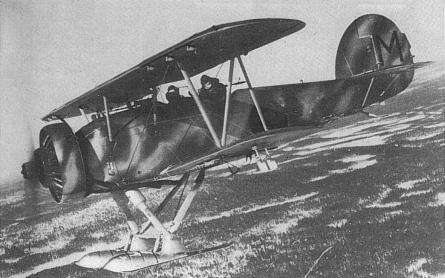
Ilmavoimat Hawker Hart: The Hart's fought through the duration of the Winter War and remained in service until 1943, when they were retired as a flood of American Lend-Lease Aircraft (and some Russian aircraft) began entering service with the Ilmavoimat prior to Finland's entry into WW2
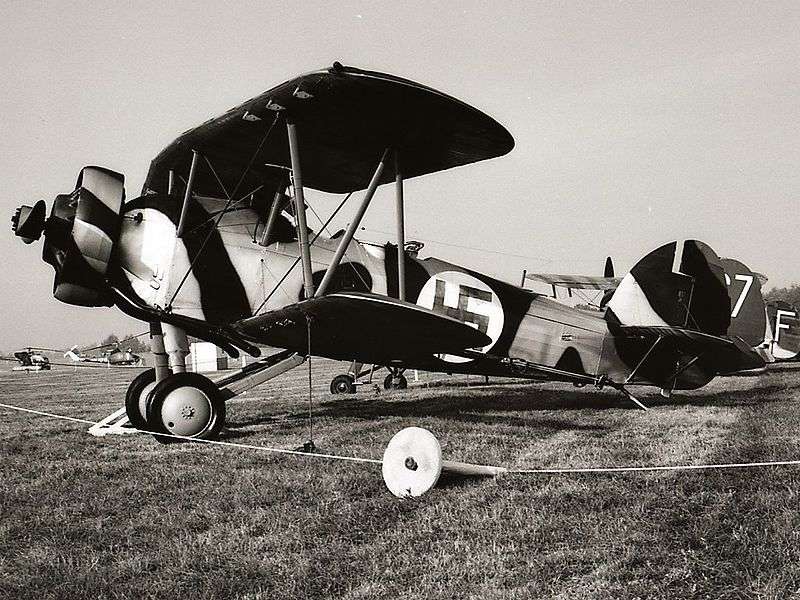
And lastly - a Swedish Hawker Hart in Ilmavoimat markings – photo taken in 1976
The 1933 Ilmavoimat Purchase Program
Again in 1933, the procurement program emphasised the purchase of trainers and fighters. A high priority had been given to the continual acquisition of modern fighter aircraft – and with no attempts to compromise by ordering aircraft with multiple capabilities. Even in the early 1930’s, it was envisaged that any war with the Soviet Union would involve the Red Air Force attacking Douhet-style with waves of unescorted bombers and the counter would thus be Fighter aircraft. Conversely, Finland’s small population and economy could never support the number of bomber aircraft necessary for a Douhet-style bombing campaign against any enemy, let alone the Soviet Union – strategic bombing was therefore eschewed from the start and where the Ilmavoimat selected bomber aircraft, the primary emphasis was to be on support for the Maavoimat and Merivoimat – and with a marked emphasis on the capability to carry out accurate ground attack bombing.
Trials carried out had long concluded that high altitude bombing from level flight was wildly inaccurate and the Ilmavoimat would never have enough aircraft to carry out effective area-saturation bombing as Douhet and his disciples advocated. On the other hand, in the evaluation trials with the Curtiss Helldivers, the Ilmavoimat had established that it was possible to accurately aim for and hit small targets. Accurate low-level bombing was also achievable with training and practice, but again this was more suitable for attacking specific targets rather than saturation bombing – and also could be carried out with small numbers of aircraft. Provision had been made for the purchase of bomber-types in the five year plan and it was decided that the 1933 procurement program would include a capable medium bomber, which would then be extensively tested in combined arms and tactical bombing exercises and evaluated for effectiveness.
As a result, in 1933 and with the Curtiss Helldivers already ordered, the Ilmavoimat opted to purchase a limited number of medium bombers, additional fighters and the new Finnish-design Tuiska Advance Trainer.
VL Tuiska Advanced Trainers – 40 ordered in late 1933 (an additional 40 were ordered in 1935)
The VL Tuisku (Snowstorm) was a Finnish-design two-seat mixed structure (welded steel framework covered with fabric) biplane with a fixed undercarriage designed as an advanced trainer aircraft with fixed undercarriage. The Designer was Arvo Ylinen (who was in 1933 the chief designer at Valtion Lentokonetehdas). As an Advanced Fighter Trainer, the first prototype was ordered from VL in January 1933. The first test flights for this aircraft were performed over spring 1933 by Lieutenant U.E. Mäkelä. The prototype broke up in the early test flights due to flutter developing – Lieutenant Mäkelä parachuted to safety. The problem was identified and eliminated for the second prototype, which was ready in early summer 1933. The test flight program was completed by 5 September, 1933. Overall, the aircrafts flying characteristics were considered to be excellent.
Immediately after the completion of the test flight program, an order was placed with VL for 40 aircraft. Construction began immediately with delivery taking place over summer 1934 and into early 1935. As an advanced trainer, the VL Tuiska proved to be a success. A second production series for an additional 40 aircraft was ordered on 14 Feb, 1935. These aircraft were delivered over mid 1935 to mid 1936. Three different versions of the aircraft were constructed: a maritime training, a pilot training and a reconnaissance training version, with the numbers being approximately equally distributed between the types. The Tuiska remained in use as an Advanced Trainer until 1950. The Tuiska was fitted with 2x7.62mm machineguns and could carry 4 x12.5 to 23kg bombs.

Ilmavoimat VL Tuisku in flight – as well as being used for Training, the aircraft could be used for Reconnaisance. With a crew of 2 (Instructor and Trainee) the Tuisku was powered by a single aircooled Armstrong Siddeley Lynx IVC 7-cylinder radial, 160 kW (215 hp) giving a maximum speed of 129mph, a range of 715 miles and had a service ceiling of 14,436 feet.

The aircraft proved a reliable and cost-effective platform in a wide variety of roles, and the Tuisku ("Snowstorm") can be regarded as one of the most successful aircraft types designed in Finland. It made a significant contribution to the development of the Ilmavoimat in the 1930s.
OTL Note: OTL, the first prototype was ordered from the State Aircraft Factory in the spring of 1933. The first flight for this aircraft was performed on 10 Jan, 1934. The second prototype was ready in the beginning of 1935 and the test flight program was finished by 5 Feb, 1935. 12 aircraft were ordered in the same month. They were delivered in the summer of 1936. One additional Tuisku was donated to the Air Force on 19 Apr, 1936. A second production series was ordered on 14 Feb, 1936. These 16 aircraft were delivered in 1937. Again one additional aircraft was donated to the Air Force. One Tuisku, named "Sokeri-Sirkku" (TU-178) is preserved and on display at the air museum in Vantaa. The fuselage of TU-169 is preserved in the museum's storage facilities. A Tuisku is also on display in front of the old State Aircraft Factory in Tampere.
Fairey Firefly II Biplane Fighter – 25 ordered early 1933, retired 1940
The earlier purchase of the Bristol Bulldog Fighter had proved to be a success, and this influenced the decision to but a further and more modern Fighter aircraft from Britain. The Ilmavoimat and VL evaluated both the new British Fighters that had been developed in response the the UK Air Ministry Specification F.20/27 for a single-seat interceptor. The Fiat CR.30 was also evaluated but was not as fast, although it had double the range. The Firefly II competed for the RAF contract against the Hawker Fury, showing superior speed but was criticised for having heavier controls. Crucially, it retained a mainly wooden structure despite the UK Air Ministry's demands for metal structures. In the UK, this led to the Fury being selected. VL however preferred the wooden structure – this was technology they were used to working with and while they were working to build up experience with the new metal structural technology, this was as yet not a strong point. The Firefly was also somewhat cheaper and, crucially, faster. The Procurement Team therefore opted for the purchase of the Firefly II. In hindsight, this was probably not an “ideal” choice, but the Firefly did prove to be an adequate fighter, if outdated by the time of the Winter War.
The Finnish order for 25 Firefly II’s was placed at the end of the first quarter of 1933, with Fairey’s UK factory building the aircraft. They were delivered to Finland six months later, assembled and tested over the winter and entered service with the Ilmavoimat in March 1934. As with the Bristol Bulldog, with Firefly II was utilised as a fighter in the Winter War, with limited success. It was relegated to use as an Advanced Fighter Trainer in early 1940 as new Fighters became available and entered service.

The Fairey Firefly II was a good high-speed interceptor Fighter in its day, albeit with limited range. With a maximum speed of 223mph at 13,000 feet, it had a range of 240 miles and a service ceiling of 30,840 feet. A single seater, it was armed with 2 × 0.303 in (7.7 mm) Vickers machine guns.

Fairey Firefly II on display
OTL Note: The Firefly was a private-venture design, penned by Marcel Lobelle. A contract was won for 25 IIM aircraft for Belgium's Aéronautique Militaire, followed by a contract for a further 62 to be constructed by Avions Fairey, Fairey's Belgian subsidiary. The Belgian aircraft served briefly in the Second World War from May to June 1940. Two of the Belgian aircraft were converted to Firefly IV, with 785 hp (585 kW) Hispano-Suiza 12Xbrs engines but the improvement was not deemed sufficient to warrant development. One was restored to its original form, while the other passed to Fairey for trials. One aircraft was supplied to the Soviet Union.
Hawker Hart Light Bomber – 20 ordered mid-1933, retired 1943
After an assessment of light and medium bombers available, the Procurement Team settled in early 1933 on the British Hawker Hart Light Bomber. An evaluation aircraft was ordered and after delivery in April, an extensive evaluation program was flown over May and June 1933. The results were such that an immediate order was placed for 20 of the aircraft, with delivery confirmed for late 1933. The Hart’s delivery was delayed due to the large number of orders that had been received for the aircraft, with delivery actually taking place in early 1934.

Ilmavoimat Hawker Hart
The Hawker Hart was a British two-seater biplane light bomber of the Royal Air Force (RAF), which had a prominent role during the RAF's inter-war period. The Hart was designed during the 1920s by Sydney Camm in response to a 1926 UK Air Ministry requirement for for a two-seat high-performance light day-bomber, to be of all-metal construction and with a maximum speed of 160 mph (258 km/h). Designs were tendered by Hawker, Avro and de Havilland. Fairey, who had sold a squadron's worth of its wooden Fox bomber in 1925, was not at first invited to tender to the specification, and was only sent a copy of the specification after protesting to the Chief of the Air Staff, Hugh Trenchard.
Hawker's design was a single-bay biplane powered by a Rolls-Royce F.XI water-cooled V12 engine (the engine that later became known as the Rolls-Royce Kestrel). It had, as the specification required, a metal structure, with a fuselage structure of steel-tube covered by aluminium panels and fabric, with the wings having steel spars and duralumin ribs, covered in fabric. The crew of two sat in individual tandem cockpits, with the pilot sitting under the wing trailing edge, and operating a single .303 in (7.7 mm) Vickers machine gun mounted on the port side of the cockpit. The observer sat behind the pilot, and was armed with a single Lewis gun on a ring mount, while for bomb-aiming, he lay prone under the pilots seat. Up to 520 pounds (240 kg) of bombs could be carried under the aircraft's wings.
The prototype Hart first flew in June 1928 and demonstrated good performance and handling, reaching 176 mph (283 km/h) in level flight and 282 mph (454 km/h) in a vertical dive. The competition culminated in the choice of the Hawker Hart by the UK Air Ministry in April 1929. Of its competitors, the de Havilland Hound was rejected due to handling problems during landing and because of its part-wooden primary structure. While the Avro Antelope demonstrated similar performance and good handling, the Hart was preferred as it was far cheaper to maintain, a vital aspect to a programme during defence budget constraints that the British armed forces faced during the 1920s. The Fairey Fox IIM (which despite the name was effectively an all-new aircraft), delayed by Fairey's late start on the design compared to the other competitors, only flew for the first time on 25 October 1929, long after the Hart had been selected.
The production Hart day bomber had a single 525 hp (390 kW) Rolls-Royce Kestrel IB 12-cylinder V-type engine; a speed of 184 mph (296 km/h) and a range of 470 mi (757 km). It was faster than most contemporary fighters, an astonishing achievement considering it was a light bomber, and had high manoeuvrability, making the Hart one of the most effective biplane bombers ever produced for the Royal Air Force. In particular, it was faster than the Bristol Bulldog, which had recently entered service as the RAF's front line fighter. This disparity in performance led the RAF to gradually replace the Bulldog with the Hawker Fury. A total of 992 aircraft were built as Harts. It became the most widely used light bomber of its time and the design would prove to be a successful one with a number of derivatives, including the Hawker Hind and Hector, being made. In addition, a specialised Hart Trainer was also designed. Vickers built 114 of the latter model at Weybridge between 1931 and June 1936. Demand for the bomber was such that 164 were built by Vickers-Armstrongs at its Weybridge factory at Brooklands between 1931 and 1936 after that company's submission of a tender, alongside the trainers mentioned above.
Thus, in selecting the Hawker Hart in 1933, the Ilmavoimat was buying an aircraft that was already tested and proven as effective in its role. The Ilmavoimat pilots took to the Hart immediately. It proved to be a superb performer, highly effective in its role and capable of being used well outside the parameters envisaged by the designers. With the example of the Curtiss Helldivers, the Ilmavoimat Pilots quickly developed dive-bombing techniques for the aircraft. When the Hawker engineers found out, they issued a formal objection, stating that the aircraft had not been designed for that purpose; however, Ilmavoimat pilots proved that the aircraft was up to the task and dispelled their concerns (or at least, ignored them). Swedish Air Force General Bjorn Bjuggren wrote in his memoirs about how his squadron developed dive-bombing techniques in the mid-1930s for their B4 Harts – there is probably some Swedish bias here, as it was well known at the time within the Ilmavoimat that the Swedes had observed the Ilmavoimat pilots carrying out dive-bombing exercises with their Harts and had copied the technique from them.
Neighboring Sweden had also purchased the Hawker Harts – in 1934, the Swedish Air Force purchased four Hawker-built pattern aircraft, powered by a Bristol Pegasus IM2 radial piston engine – these were delivered in 1934. Following successful evaluation, 42 were built under licence in Sweden, powered by a Swedish-built NOHAB Pegasus IU2. A number of these Swedish Harts fought in the Winter War as part of the Swedish F19 volunteer unit assisting the Finns. The Ilmavoimat found that the performance of the Hart was such that it could outfly their older fighters and it also proved to be a highlly manouverable aircraft – consequently, the Ilmavoimat added a second Vickers machine gun, while the coaming of the rear cockpit was angled to give a better field of fire for the observer.

Ilmavoimat Hawker Hart: The Hart's fought through the duration of the Winter War and remained in service until 1943, when they were retired as a flood of American Lend-Lease Aircraft (and some Russian aircraft) began entering service with the Ilmavoimat prior to Finland's entry into WW2

And lastly - a Swedish Hawker Hart in Ilmavoimat markings – photo taken in 1976
A question on transport aircraft suitable for military use in 1934
The Ilmavoimat is looking at transport aircraft for military use. Has to be robust, proven, tough, suitable for military use and available - and not too expensive. What aircraft were available in early 1934. So far they are looking at the following
Junkers Ju52
Junkers Ju86 (unfortunately just on paper at this stage so probably will not go far)
Boeing Model 247
Douglas DC2
de Havilland Dragon
What other aircraft were out there in 1934 that could carry at least 10 passengers and were robust enough for military use?
The Ilmavoimat is looking at transport aircraft for military use. Has to be robust, proven, tough, suitable for military use and available - and not too expensive. What aircraft were available in early 1934. So far they are looking at the following
Junkers Ju52
Junkers Ju86 (unfortunately just on paper at this stage so probably will not go far)
Boeing Model 247
Douglas DC2
de Havilland Dragon
What other aircraft were out there in 1934 that could carry at least 10 passengers and were robust enough for military use?
There's the DH 86 Express in development (the prototype flew in Jan 34)
Handley Page HP42
There is also the obsolescent Vickers Victoria, planned to be converted to the newer Valentia standard.
Heinkel He 59
General Aviatian GA-43
Perhaps one of the Sikorsky flying boats?
Thx for those, I'll add them to the list. I don't think flying boats would work - have to be able to operate on skis or at least wheels in winter, which more or less eliminates the Sikorsky flying boats.
Thought about the Heinkel 111 but it didn't fly until well into 1935
Buy italian?
Caproni Ca 133 or Savioa S73?
Savoia S73 looks good too - flewmid 1934 and had a passenger compartment that could house 18 passengers in two rows.
OK, thx guys. The ca.132 and the S73 are on the eval list as well.
Derek Pullem
Donor
Caprioni Ca.132 - looks good - Configured as an airliner, it would have seated 20 passengers.
The Ca.133 prototype first flew in December 1934, which makes it a littlke bit late.
Ca 132 was a prototype too and the Ca 133 was in production in 1935 anyway and fought in Ethopia. Either could be available in your time frame I believe.
Share:
